W ESTERN M ICHIGAN U NIVERSITY C OOLEY L AW R EVIEW
Volume 38 Spring 2023
Articles
Issue 1
A Step in the Right Direction: The H-1B Program is Finding a New Light
Maria J. Pierre
Justice Affordable to All: A Comparison of Bail Reform Across America
Riley Stheiner
Memory: The Past, Present & Future of Law School Exams
Matthew Marin & Amanda Fisher
Reading Between the Wines: Granholm v. Heald’s Implications for Other Industries
Tyler R. Smotherman
Distinguished Briefs
Rouch World, LLC & Uprooted Electrolysis, LLC v. Michigan Department of Civil Rights & Director of the Department of Civil Rights
Tonya Celeste Jeter
People of the State of Michigan v. Robert Lance Propp
Steven Helton
A Publication of Western Michigan University
Thomas M. Cooley Law S chool

I
Cite this volume as: 38 W. MICH. U. T.M. COOLEY L. REV. (2023). The Western Michigan University Thomas M. Cooley Law Review is published three times annually by the students of the Western Michigan University Thomas M. Cooley Law School, 300 South Capitol Avenue, P.O. Box 13038, Lansing, Michigan 48901.
Subscriptions: Special Patrons, $50 per year; Law Firm Benefactors, $100 per year; regular subscriptions, $30 per year. Inquiries and changes of address may be directed to the Law Review, care of the Western Michigan University Thomas M. Cooley Law School, phone number 1 (517) 371-5140, ext. 4501.
The Western Michigan University Thomas M. Cooley Law Review welcomes submission of articles. Manuscripts should be typed, double-spaced, with footnotes. Citations in manuscripts should follow the form prescribed in The Bluebook: A Uniform System of Citation (19th or 20th Ed.). We regret that unsolicited manuscripts cannot be returned. E-mail to LawReview@cooley.edu in Microsoft Word format.
Editorial Policy: The views expressed in papers published herein are to be attributed to their authors and not to the Western Michigan University Thomas M. Cooley Law Review, its editors, or the Western Michigan University Thomas M. Cooley Law School.
The Western Michigan University Thomas M. Cooley Law Review is a member of the National Conference of Law Reviews. Printed by The Sheridan Press, 450 Fame Ave., Hanover, Pennsylvania 17331. Nonprofit postage prepaid at Lansing, Michigan, and at additional offices.
Back issues and volumes, as well as complete sets, are available from William S. Hein & Co., Inc., 1285 Main Street, Buffalo, New York 14209, phone number 1 (800) 828-7571.
Printed on recycled paper.
Copyright 2023 by Western Michigan University Thomas M. Cooley Law School.
W ESTERN M ICHIGAN U NIVERSITY THOMAS M. COOLEY LAW SCHOOL
James McGrath, President & Dean
BOARD OF DIRECTORS
Hon. Louise Alderson, Chairman
Aaron V. Burrell
Thomas W. Cranmer
Hon. Michael P. Hatty
Kenneth V. Miller
Hon. Bart Stupak
Mitchell S. Zajac
Mustafa Ameen
Christina Corl
John M. Dunn
Hon. Jane Markey
Lawrence P. Nolan
Jordan V. Sutton
PROFESSOR, FOUNDER, AND PAST PRESIDENT
The Honorable Thomas E. Brennan (deceased)
DEANS EMERITI
Michael P. Cox, Dean and Distinguished Professor Emeritus
Keith J. Hey, Dean and Distinguished Professor Emeritus
Robert E. Krinock, Dean and Professor Emeritus (deceased)
Don LeDuc, Dean Emeriti
DISTINGUISHED PROFESSORS EMERITI
Frank Aiello
David Berry (deceased)
Jeanette Buttrey
Terrence Cavanaugh
Julie Clement
Mary D’Isa
Cynthia Faulkner
Gary Bauer
Ronald Bretz
Evelyn Calogero
Karen Chadwick
Pat Corbett
Mark Dotson
Norman Fell
Curt Benson
Kathleen Butler
Paul Carrier
Dennis Cichon
David Cotter
Heather Dunbar
Gerald Fisher
Hon. Anthony Flores Judith Frank (deceased) Marjorie Gell
Elliot Glicksman (deceased) Lisa Halushka
James Hicks
John Kane
Mara Kent
Gerald MacDonald
Jeffrey L. Martlew
Nelson Miller
Lawrence Morgan
Kimberly O’Leary
Emily Horvath
Eileen Kavanagh
R. Joseph Kimble
Dena Marks
Dan McNeal
Ann Miller Wood
Maurice Munroe
Charles Palmer
James Peden Ernest Phillips
John Rooney (deceased)
Devin Schindler
Chris Shafer
Brent Simmons
Lauren Rousseau
John Scott
Dan Sheaffer
Paul Sorenson
John Taylor Gina Torielli
Gerald Tschura
Victoria Vuletich
Christopher Hastings
Peter Jason (deceased)
Peter Kempel (deceased)
Dorean Koenig (deceased)
John Marks
Helen Mickens
Marla Mitchell-Cichon
John Nussbaumer
Nora Pasman-Green
Philip Prygoski (deceased)
Marjorie Russell
Charles Senger
Jane Siegel
Norman Stockmeyer
Ronald Trosty
William Wagner
i
Cynthia Ward
Nancy Wonch
William Weiner
PROFESSORS EMERITI
F. Georgeann Wing
Sherry Batzer
Heather Garretson
Paul Marineau
Florise Neville-Ewell
James Carey
Lewis Langham
Donna McKneelen
Norman Plate
Dan Ray Kevin Scott
David Tarrien L. Patricia Thorpe-Mock
DEANS
Lisa DeMoss
Ashley Lowe
Monica Navarro
Toree Randall
Ronald Sutton
Karen Truszkowski
Tracey Brame
Associate Dean of Experiential Learning and Practice Preparation & Director of the Innocence Project & Professor
Danielle Hall
Associate Dean for Admissions, Financial Aid & Registration
Amy Timmer
Associate Dean of Students and Acting Dean of Graduate Programs
Katherine Gustafson
Assistant Dean of the Tampa Bay Campus & Associate Professor
Duane A. Strojny
Associate Dean for Library and Instructional Support & Professor
Paul J. Zelenski
Senior Vice President and Associate Dean of Enrollment & Student Services
PROFESSORS
Tammy Asher
Brendan Beery
Bradley Charles Mark Cooney
Renalia DuBose
Joseline Hardrick
Emily Horvath
Tonya Krause-Phelan
Michael McDaniel
Matthew Marin
David Finnegan
Richard C. Henke
Barbara Kalinowski
Mable Martin-Scott
Michael K. Molitor
Florise Neville-Ewell
Jeffrey Swartz Patrick Tolan
Christine Zellar-Church
ADJUNCT PROFESSORS
Erika Breitfeld
Mark Dotson
Dustin Foster
James Hicks
Linda Kisabeth
Daniel Matthews
Martha Moore
Monica Nuckolls
Joan Vestrand
Wafa Adib-Lobo
James Anderton V
Patrick Batterson
Michael Behan
Joseph Burgess
Terrence Cavanaugh
Patrick Corbett
Rich DiGiacomo
Chad Engelhardt
Giuliana Allevato
Andrew Arena
Sherry Batzer
Sonya Beverly
Daniel Cardwell
Steve Cernak
Debbie Crockett
Michelle Donovan
Steven Fantetti
Hon. Tony Flores Hon. Richard Garcia
Hon. Jack Gilbreath
Nathan Goetting
Mustafa Ameenuddin
Amy Bandow
Gary Bauer
Mark Brewer
James Carey
Russel Church
Elizabeth Devolder
Steve Dulan
William Fleener
Laura Genovich
Christi Henke
ii
Robert Heitmeyer
Daniel Houlf
Caroline Johnson-Levine
Lewis Langham
Peggy MacDougall
Daryl Manning
Holly Hicks
Hon. Curtis Ivy
Sheila Lake
Michael Leffler
Colin Maguire
Paul Marineau
Hon. Catherine McEwen Scott Mertens
Christian Montesinos
Nicholas Nazaretian
Kimberly O’Leary
John Pierce
Toree Randall
Tami Salzbrenner
Joseph Shada
Samantha Sliney
John Taylor
Victor Veschio
Graham Ward
Julie Mullens
Bentley Nettles
Sarah Ostahowski
Karen Poole
Jennifer Rosa
Jalitza Serrano
Ben Shotten
James Sterken
David Tirella
James Vlasic
Deirdre White
Clarence Hollins
Julie Janeway
Salvatore LaMendola
Randall Leonard
Steven Mann
John McDaniel
Marla Mitchell-Cichon
Thomas Myers
John Nicolucci
Jennifer Paillon
Teri Quimby
Christopher Sabella
Traci Schenkel
Eric Skinner
Edward Sternisha
Gregory Ulrich
Sarah Walker
Zena Zumeta
iii
WESTERN MICHIGAN UNIVERSITY COOLEY LAW REVIEW TRINITY 2023

BOARD OF EDITORS
Adam Ostrander Editor-in-Chief
Michala Ringquist Executive Managing Editor
Sarah Tanner Interim Executive Managing Editor
Ethan Loch Executive Articles Editor
Hannah Murphy Executive Publicity Editor
Samantha Hulliberger Managing Articles Editor
ASSOCIATE EDITORS
Elizabeth Zywicki
Zachary Walters
Melissa Bianchi
Cameron Wilson
Adam Kimball
Kristin Duffy
Francesca Camacho
Norelle Miranda
Maria Pierre Executive Symposium Editor
Wyatt Wells Interim Executive Symposium Editor
Hope Teachout Executive Notes Editor
Caroline Quandt Managing Notes Editor
Professor Mark Cooney Faculty Advisor
vii
DAWN C. BEACHNAU AWARD
This award is presented to the member of the Western Michigan University Cooley Law Review Voting Board of Editors who made the most significant contributions to the Law Review through leadership and dedication.
Trinity 2023 Recipient: Ethan Loch & Hope Teachout
JOHN D. VOELKER AWARD
This award is presented to the Senior Associate Editor of the Western Michigan University Cooley Law Review who made the most significant contributions to the publication of the Law Review.
Trinity 2023 Recipient: Melissa Bianchi
EUGENE KRASICKY AWARD
This award is presented to the Assistant Editor of the Western Michigan University Cooley Law Review who made the most significant contributions to the publication of the Law Review.
Trinity 2023 Recipient: Adam Kimball
viii
WESTERN MICHIGAN UNIVERSITY COOLEY LAW REVIEW

HILARY 2023
BOARD OF EDITORS
Nancy Zieah Editor-in-Chief
Adam Ostrander Interim Editor-in-Chief
Michala Ringquist Executive Managing Editor
Samira Montlouis Executive Articles Editor
Jessica Sivillo Executive Notes Editor
Hannah “Leah” Ortiz Executive Publicity Editor
Samantha Hulliberger Managing Articles Editor
Professor Mark Cooney Faculty Advisor
ASSOCIATE EDITORS
Julia Card
Alexandra Calzaretta
Aniela Bosca
Elizabeth Zywicki
Zachary Walters
Melissa Bianchi
Tyrone Laury
Cameron Wilson
Maria Pierre Executive Symposium Editor
Ethan Loch Interim Executive Articles Editor
Hope Teachout Interim Executive Notes Editor
Hannah Murphy Interim Executive Publicity Editor
Ronja Lugo Akergren Managing Notes Editor
v
DAWN C. BEACHNAU AWARD
This award is presented to the member of the Western Michigan University Cooley Law Review Voting Board of Editors who made the most significant contributions to the Law Review through leadership and dedication.
Hilary 2023 Recipient: Michala Rinquist
JOHN D. VOELKER AWARD
This award is presented to the Senior Associate Editor of the Western Michigan University Cooley Law Review who made the most significant contributions to the publication of the Law Review.
Hilary 2023 Recipient: Julia Card
EUGENE KRASICKY AWARD
This award is presented to the Assistant Editor of the Western Michigan University Cooley Law Review who made the most significant contributions to the publication of the Law Review.
Hilary 2023 Recipient: Tyrone Laury
vi
CONTENTS
From the Editor …………………………………………………………....xi
ARTICLES
A Step in the Right Direction: The H-1B Program is Finding a New Light
Maria J. Pierre…………………………………………………….1
Justice Affordable to All: A Comparison of Bail Reform Across America
Riley Stheiner……………………………………………………..13
Memory: The Past, Present & Future of Law School Exams
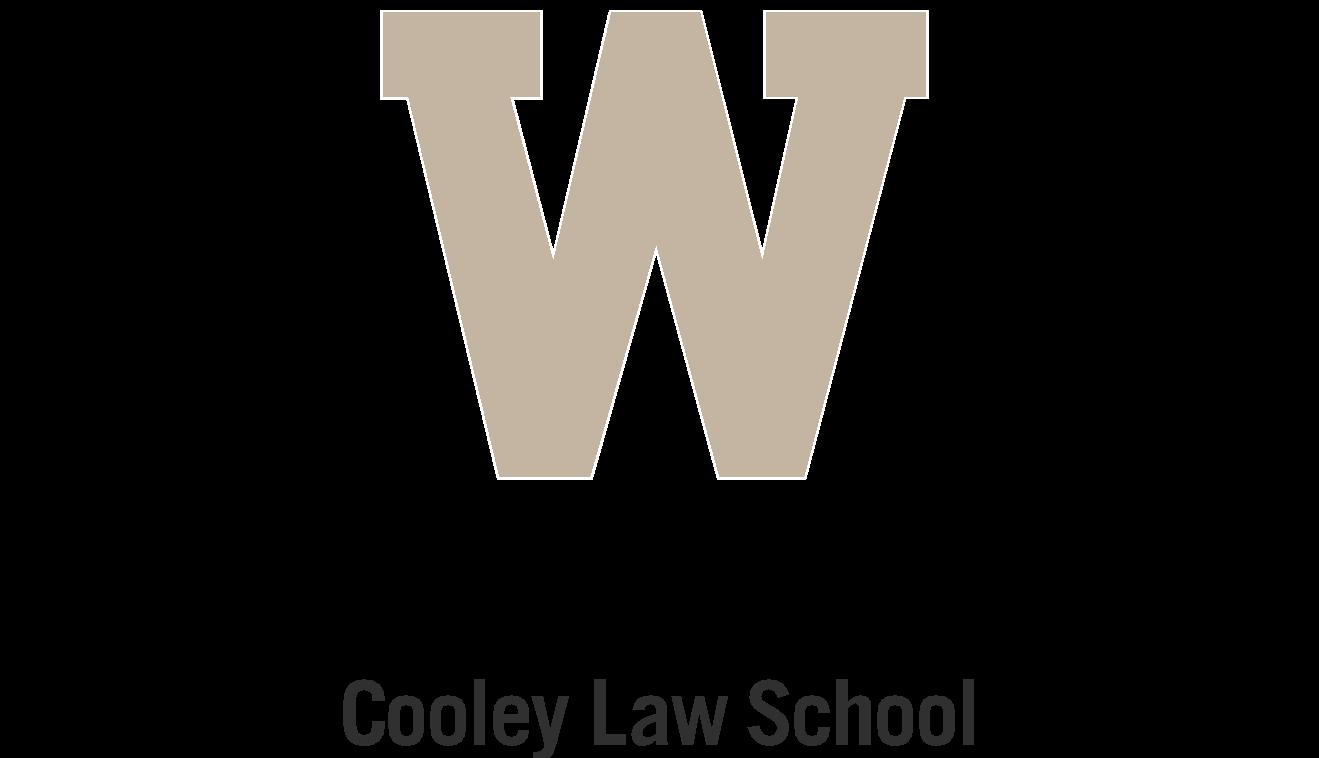
Matthew Marin & Amanda Fisher……………………………….29
Reading Between the Wines: Granholm v. Heald’s Implications for Other Industries
Tyler R. Smotherman……………………………………………..49
DISTINGUISHED BRIEFS
Rouch World, LLC & Uprooted Electrolysis, LLC v. Michigan Department of Civil Rights & Director of the Department of Civil Rights
Tonya Celeste Jeter…………………………………………....….75
People of the State of Michigan v. Robert Lance Propp
Steven Helton …………119
ix
Volume 38 Spring 2023 Issue 1
LETTER FROM THE EDITOR
Dear Reader,
The Executive Board of Editors of the Western Michigan University Thomas M. Cooley Law School Law Review is proud to present to you the first issue of the 38th volume of our journal. The Board, myself in particular, would like to thank you for your support of this critical publication. Each member of the Cooley Law Review has dedicated untold hours to create this issue, and without your support, there is no reason for us to do what we do.
This issue contains an array of articles addressing some of the most pressing legal issues of our time. The first article addresses immigration in the United States and the state of the H-1B visa caps. The second article tackles equal and equitable bail bonds in our criminal justice system. The third article takes on the state of law school exams in a post-COVID world. And the fourth article addresses the impact of Granholm v. Heald on interstate commerce.
Additionally, this issue contains two award-winning briefs of the 2022 Distinguished Briefs Awards hosted by the Western Michigan University Thomas M. Cooley Law Review.
Many articles were submitted for consideration. These articles were chosen by the Law Review Board of Editors because they offered unique, insightful perspectives on their subject matter. As we have since our inception, several decades ago, we strive to bring exceptional, provocative perspectives to the table to further thoughtful discussion about the law. We are sure that is exactly what these articles will do. Thank you again for your continued support.
With Great Appreciation,
Adam N. Ostrander
xi
A STEP IN THE RIGHT DIRECTION: THE H-1B PROGRAM IS FINDING A NEW LIGHT
MARIA J. PIERRE1
I. INTRODUCTION
H-1B Cap. What else is there to say – if you know, you know. The H-1B program applies to employers who want to hire nonimmigrant foreign nationals in specialty occupations. A specialty occupation requires the applicant to have a bachelor’s degree (or equivalent) and highly specialized knowledge. The H-1B Cap process is applicable to foreign nationals who have not had H-1B visa status before
How does the process work for first-time H-1B visa holders? There is an annual cap of 65,000 for new H-1B visa holders, with an additional 20,000 for noncitizens with master’s degrees or higher from a U.S. institution. The H-1B visas are allocated during a certain time of the fiscal year by a randomized lottery system – this lottery system is referred to as the “H-1B Cap.” An H-1B Cap application is not considered to be selected if the randomized lottery does not select that H-1B Cap application.
The H-1B Cap process invokes an array of feelings; applicants commonly experience frustration, anxiety, and high stress levels. For instance, if the U.S. Citizenship and Immigration Services (“USCIS”) did not select an individual’s H-1B Cap application, then all of one’s hard work, blood, sweat, and tears could be meaningless.
Gladly, the system is far removed from those dark days. In March 2020, the H-1B selection process stepped into the light by creating a registration system. This system helps cut out the tedious work on the
1. Maria J. Pierre received a Bachelor of Arts in Political Science from the University of San Diego in 2011, completed her certified Paralegal certificate in 2013 from USD, and obtained her Master of Science in Law from Champlain College in 2017. Maria has worked in the Business Immigration field since 2013 and will continue to practice in this field of law after obtaining her Juris Doctorate in 2024. Maria is the Executive Symposium Editor of WMU Cooley Law Review, a member of the American Immigration Lawyers Association, a member of the Phi Alpha Delta Society of Scholars, and a member of Sigma Gamma Rho Sorority, Inc.
front end of the H-1B application process. Under the new system, a beneficiary is selected for the H-1B Cap, and then the individual prepares an H-1B Cap application. If the H-1B beneficiary is not selected, the individual will no longer waste time and resources while preparing for the case.
Emily C. Callan’s article, Is the Game Still Worth the Candle (or the Visa)? How the H-1B Visa Lottery Lawsuit Illustrates the Need for Immigration Reform, 2 provided alternative solutions for Congress and the USCIS to cure problems in the H-1B Cap process and the entire H-1B program. Since the article’s publication in 2016, President Joe Biden’s Administration has slightly improved this visa program. The Biden Administration offers solutions to help cure the “ills” Callan addressed in her article. Part II of this article provides an in-depth background of the H-1B program and the H-1B Cap registration system. Part III provides alternatives to Callan’s proposed “cures” to the H-1B program. Finally, Part IV states a conclusion.
II. BACKGROUND
A. Statutory Provisions
In 1952, the Immigration and Nationality Act (“INA”) “first established an H-1 nonimmigrant visa classification for temporary workers ‘of distinguished merit and ability.’”3 The Homeland Security Act of 2002 disbanded INA on March 1, 2003,4 and the newly-formed Department of Homeland Security (“DHS”) absorbed the constituent parts under three agencies: Customs and Border Protection (“CBP”), Immigration and Customs Enforcement (“ICE”), and USCIS to “retain[] its commitment to welcoming lawful
2 Emily C. Callan, Is the Game Still Worth the Candle (or the Visa): How the H-1B Visa Lottery Lawsuit Illustrates the Need for Immigration Reform, 80 ALB. L. REV. 335, 347 (2016).
3. RODNEY A. MALPERT, ET AL., BUSINESS IMMIGRATION LAW: STRATEGIES FOR EMPLOYING FOREIGN NATIONALS § 4.03 (2015).
4 USCIS, Overview of INS History, USCIS HIST. OFF. & LIBR., 11 (2012), https://www.uscis.gov/sites/default/files/document/factsheets/INSHistory .pdf (last visited Aug. 1, 2022)
2 W. MICH. U. COOLEY LAW REVIEW [Vol. 38:1
immigrants and supporting their integration and participation in American civic culture.”5
B. Regulations
The two U.S. Administrative agencies responsible for the H-1B Program are USCIS and the Department of Labor (“DOL”).6 “The USCIS authorizes actual H-1B classification for a particular foreign national beneficiary, based on a petition submitted by the employer[.]”7 The H-1B application describes the H-1B specialtyoccupation position that will be performed and the foreign national’s qualifications for the intended job.8 Before the H-1B application is submitted, whether the application is Cap or non-Cap, the “DOL reviews and certifies the employer’s labor condition application (‘LCA’).”9 The DOL certifies “the employer’s obligations regarding wages and working conditions” for the employment opportunity.10 These two agencies have “promulgated detailed regulations” regarding the H-1B application.11 For example, employers are not allowed to file “multiple H-1B petitions for the same employee,”12 and there is a “minimum five-day period at the beginning of the fiscal year’s filing ‘season’ during which H-1B petitions are received by USCIS.”13
C. The H-1B Cap Selection Process
The most recognized feature of the H-1B program is the H-1B Cap selection process. The H-1B Cap season is “[o]ne of the more widely known and frustrating features of the H-1B program[.]”14 It “is the annual numerical limit on usage of the H-1B category[.]”15
2023] FINDING A NEW LIGHT 3
5. Id. 6 Malpert, supra note 1, at 5 7 Id. 8 Id. 9 Id. 10 Id. 11. Id. 12 Id. at 7. 13 Id. 14 Id. 15 Id.
“The law specifies that foreign nationals who are subject to the limitation shall be issued visas or otherwise provided the status ‘in the order in which petitions are filed for them.’”16
USCIS begins accepting and processing H-1B petitions at the start of the filing period for a given year (April 1) and continues to accept and process petitions in chronological order of filing until it determines, using projections based on historical rates of approval, denial, and revocation, that enough petitions have been filed to ensure that the number of approved petitions for qualifying beneficiaries will meet the year’s cap.17
The H-1B application can be “filed up to six months [before] the requested start date.”18 This means the “filing period for each fiscal year actually starts the previous April 1, with petitions asking for October 1 start dates.”19 The H-1B Visa Reform Act of 2004 allows beneficiaries that hold “a master’s or higher degree from a U.S. institution” to be exempt from the 65,000 annual caps.20 These higher education beneficiaries have a separate annual cap limit of 20,000.21
Before 2020, employers were required to submit full H-1B applications before knowing “whether a visa number would be available, given that demand for visa numbers usually outstrips supply.”22 However, in March 2020, for the 2021 fiscal year, USCIS changed its registration process.23 A completed H-1B application was no longer required.24 “The purpose of this new process was to reduce the burden on U.S. employers, and the agency, caused by requiring employers to submit complete H-1B petitions and supporting documentation [before] knowing whether a visa number would even be available.”25 USCIS announces its next year’s dates in advance, “during which a U.S. employer must register electronically for each
16 Id. (quoting 8 U.S.C. § 1184(g)(3)).
17 Id. (quoting 8 C.F.R. §§ 214.2(h)(8)(ii)(A), 214.2(h)(8)(ii)(B)).
18. Id. (quoting 8 C.F.R. § 214.2(h)(9)(i)(B)).
19. Id.
20 Id. at 8 (quoting 8 U.S.C. § 1184(g)(5)(C)).
21 Id.
22
American Immigration Council, The H-1B Visa Program and its Impact on the U.S. Economy, AM. IMMIGR. COUNCIL 3 (Apr 2020), https://www.immigrationresearch.org/system/files/the_h-1b_visa_program_ a_primer_on_the_program_and_its_impact_on_jobs_wages_and_the_ economy.pdf (last visited Aug. 1, 2022).
23 Id.
24 Id.
25 Id. at 3-4.
4 W. MICH. U.
COOLEY LAW REVIEW [Vol. 38:1
foreign national for whom the employer intends to file an H-1B petition.”26
In contrast to the copious amount of information USCIS previously required, the electronic registration process now requires a U.S. employer to pay a $10 registration fee for each H-1B candidate, along with limited information about the petitioner and beneficiary.27 “If USCIS receives more registrations than visa numbers available,”28 a lottery occurs to select the registrants who can file full H-1B applications.29 “USCIS will select registrations for the 65,000 visa numbers first and then for the 20,000 master’s exemption visa numbers.”30
When the registrants are selected, the employers are electronically notified, and the employer then has 90 days to file an H-1B application.31 If the USCIS does not receive enough petitions to meet the visa numbers, “USCIS has the option to make additional selections.”32
III. ANALYSIS
A. Proposed Solution No.1: Congress Should Increase the H-1B Visas Numbers
In her article, Callan suggests that this solution is the “easiest legislative fix” to the H-1B paradox – “for Congress to simply increase the number of visas that may be issued each year.”33 This proposed solution has been pursued, and it is the cause for multiple bills proposed annually.34 Still, the Biden Administration will most likely not raise the H-1B Cap numbers.35
35. Patrick Thibodeau, Biden Wants Permanent Work Visas, Not More H-1Bs, TECHTARGET (Oct. 29, 2021), https://www.techtarget.com/ searchhrsoftware/news/252508840/Biden-wants-permanent-work-visas-notmore-H-1Bs (last visited Aug. 1, 2022)
2023] FINDING A NEW LIGHT 5
26 Id. at 4. 27. Id. at 3. 28. Id. at 4. 29 Id. 30 Id. 31 Id. 32 Id. 33. Callan, supra note 1, at 347. 34. Id.
If the Biden Administration will not increase the H-1B visa numbers, how does this solution help immigrants pursuing this nonimmigrant visa type? The answer lies in Employment-Based green cards. The Biden Administration is relaxing some of the stringent restrictions that the Trump Administration placed on businesses pursuing employment-based green cards.36 The Biden Administration is working with lawmakers to increase this green card category that would allow foreign nationals to remain and live in the U.S. permanently.37
Why are green cards preferred over H-1B visas? Foreign nationals who have obtained H-1B visas can work for up to six years without special permission, and only “[u]nder certain circumstances, USCIS may extend . . . authorization beyond the six-year limit.”38 In contrast, if a beneficiary’s employer does not opt-in for a green card, then the foreign national must leave the U.S., or scramble to find another favorable alternative to remain and continue to work in the United States.
However, a foreign national can find an employer to sponsor their green card and extend the six-year limitation for three more years if the foreign national has an approved I-140.39 The American Competitiveness in the 21st Century Act (“AC-21”) permits a foreign national to continue to extend their H-1B visa in one to three-year increments, depending on the status of their 1-140 petition.40 This extension can be continued until the foreign national’s priority date is current and their status is adjusted from H-1B visa holder to Lawful Permanent Resident–a non-citizen green card holder.41
38 USCIS, 6.5 H-1B Specialty Occupations, DEP’T OF HOMELAND SEC., https://www.uscis.gov/i-9-central/form-i-9-resources/handbook-foremployers-m-274/60-evidence-of-status-for-certain-categories/65-h-1bspecialty-occupations (last visited Aug. 1, 2022)
39 Kyle Knapp, How Long an H-1B Worker Can Stay in the United States, NOLO 2, https://www.nolo.com/legal-encyclopedia/how-long-h-1bworker-can-stay-the-united-states.html (last visited Feb. 17, 2023).
40 H-1B Visa Extension, VISANATION, https://www.immi-usa.com/h1bvisa/h1b-visa-extension/ (last visited Feb. 17, 2023).
41. Dep’t Homeland Sec., Lawful Permanent Residents (LPR), DEP’T HOMELAND SEC., https://www.dhs.gov/immigration-statistics/lawfulpermanent-residents (last visited Aug. 01, 2022) See also 8 U.S.C. § 1184(g)(8)(C).
6 W. MICH.
U. COOLEY LAW REVIEW [Vol. 38:1
36 Id. 37 Id.
The problem with Biden’s green card push is that getting a green card for some foreign nationals depends on their birth country. For a foreign national from any given country, there is a 7% limitation for green cards issued annually for that country.”42 For example, as of August 2022, USCIS is accepting Indian Nationals in the EB-2 category (members of the professions holding advanced degrees or persons of exceptional ability) to file their green card applications if they have a December 1, 2014, priority date.43
However, USCIS cannot review and adjudicate its applications if the foreign national’s priority date is before January 1, 2015.44 This means, for instance, that in 2022, an Indian National with a priority date of June 1, 2022, is not allowed to file their green card application until their priority date is “current;” the priority date will not be current for the next eight years, and that is if those dates do not retrogress.
Eight years is a generous estimate, and the more accurate estimate is closer to a decade or more for some countries. This is where AC-21 extensions can help Indian and Chinese Nationals remain in a prolonged H-1B visa status until they are permitted to apply for their green cards.45 This devastating news does not spread across the board. Foreign nationals from the Philippines, Mexico, and all other nationals have priority dates that are considered “current;” these nationals can file their green card applications shortly after receiving their I-140 approval notice, or they can file I-140 applications simultaneously with their green card applications.46
B. Proposed Solution No.2: Congress Should Create More Visa Categories
Callan suggests that “Congress should create more employment visa categories” that would “craft an entirely new temporary
42 Thibodeau, supra note 33
43 Dep’t of State–Bureau of Consular Affairs, Visa Bulletin: Immigrant Numbers for August 2022, DEP’T OF STATE 3-4, https://travel.state .gov/content/dam/visas/Bulletins/visabulletin_august2022.pdf (last visited Aug. 1, 2022).
44 Id. at 5.
45
6.5 H-1B Specialty Occupations, supra note 36
46 Visa Bulletin, supra note 41, at 4.
2023] FINDING A NEW LIGHT 7
employment visa category that foreign nationals could utilize [if] their H-1B petitions are not selected in the lottery.”47
Although the Biden-Harris Administration is not creating new employment visa categories, this Administration is expanding the Science, Technology, Engineering, and Mathematics (“STEM”) fields to help attract “global talent to strengthen our economy and technological competitiveness, and benefit working people and communities all across the country.” 48 With this initiative, the DHS announced new actions to have more “predictability and clarity for pathways for international STEM scholars, students, researchers, and experts to contribute to innovation and job creation efforts across America.49 These actions will allow international STEM talent to continue to make meaningful contributions” to America.50 To list a few of the announcements:
1. Department of Homeland Security Secretary Mayorkas is announcing that 22 new fields of study are now included in the STEM Optional Practical Training (OPT) program through the Student and Exchange Visitor Program (SEVP). The program permits F-1 students earning Bachelors, Masters, and Doctorates in certain STEM fields to remain in the United States for up to 36 months to complete Optional Practical Training after earning their degrees. . . . The added fields of study are primarily new multidisciplinary or emerging fields, and are critical in attracting talent to support U.S. economic growth and technological competitiveness.
2. DHS . . . update[d] its policy manual related to “extraordinary ability” (O-1A) nonimmigrant status regarding what evidence may satisfy the O-1A evidentiary criteria. . . . [This] status is available to persons of extraordinary ability in . . . science, business, education, or athletics. . . . DHS is clarifying how it determines eligibility for immigrants of exceptional abilities, such as PHD holders, in the (STEM) fields.
47 Callan, supra note 32, at 347.
48 FACT SHEET: Biden-Harris Administration Actions to Attract STEM Talent and Strengthen our Economy and Competitiveness, THE WHITE HOUSE (Jan 21, 2022), https://www.whitehouse.gov/briefing-room /statements-releases/2022/01/21/fact-sheet-biden-harris-administrationactions-to-attract-stem-talent-and-strengthen-our-economy-andcompetitiveness/ (last visited Aug. 1, 2022)
49 Id
50 Id.
8 W. MICH.
U. COOLEY LAW REVIEW [Vol. 38:1
3. With respect to immigration, DHS is issuing an update to its policy manual on how U.S. Citizenship and Immigration Services (USCIS), a DHS component, adjudicates national interest waivers for certain immigrants with exceptional abilities in their field of work. The Immigration and Nationality Act (INA) provides that an employer can file an immigrant petition for a person of exceptional ability or a member of the professions with an advanced degree. . . .USCIS may waive a job offer requirement, allowing immigrants whose work is in the national interest to petition for themselves, without an employer.51
The above announcements are designed to remove some of the barriers placed on the legal immigration system.52 Although these STEM programs do not create new H-1B Employment Visa categories, they do lessen the previously stringent requirements that once made qualifying for these categories more challenging and contribute to the feasibility of obtaining a green card.
C. Proposed Solution No.3: USCIS Should Implement and Adhere to New and Existing H-1B Regulations
USCIS is not empowered to make new laws, as this authority is reserved solely for Congress.53 Nonetheless, the agency is authorized to promulgate its own regulations to execute its duties.54 The USCIS regulations have been made law frequently.55
Callan implies that USCIS does not follow its revoking mandate.56 When an approved H-1B application is not used, the petitioner is supposed to notify the Service Center Director about the unused H-1B application.57 At that point, the application is considered revoked; USCIS is to tally the number of unused H-1B applications and take into account the number of unused petitions for
51. Id.
52 Id.
53 See, e.g., 8 C.F.R. § 2.1 (2016) (stating that the Secretary of Homeland Security may delegate the authority to any employee of the DHS–including USCIS employees–to create regulations to administer and enforce immigration laws).
54. Id.
55 Legislation, USCIS, https://www.uscis.gov/laws-and-policy/legislation (last updated July 9, 2020).
56 Callan, supra note 32, at 349.
57 See, 8 C.F.R. § 214.2(h)(8)(ii)(B).
2023] FINDING A NEW LIGHT 9
the next fiscal year.58 “By its own admission, USCIS does not adhere to this regulation because the agency ‘allegedly’ takes into account these potential scenarios. . . when conducting the initial lottery.”59 However, there is no way for USCIS to accurately predict how many approved petitions will go unused;60 the agency has no empirical method to ensure that it accepts enough petitions to fulfill the Cap.61
Callan also proposed creating more new categories – preferential categories – that would result in more available H-1B visa numbers.62 This was done for Chilean and Singaporean foreign nationals by creating the H-1B1 category.63 The H-1B1 Program allows employers to temporarily employ foreign workers from Chile and Singapore in the U.S. on a nonimmigrant basis in specialty occupations.64 Current laws limit the annual number of qualifying foreign workers who may be issued an H-1B1 visa to 6,800, with 1,400 from Chile and 5,400 from Singapore.65 A similar visa category was created for the Australian National – the E3 Visa Category.66 This visa category bypasses the H-1B visa category and allows an annual 10,500 visas for Australian Nationals.67
58 Id.
59 Callan, supra note 32, at 349.
60 Off of Inspector Gen , USCIS Approval of H-1B Petitions Exceeded 65,000 Cap in Fiscal Year 2005, DEP’T HOMELAND SEC 5 (Sept 2005), https://trac.syr.edu/immigration/library/P34.pdf
61. Id.
62. Callan, supra note 32, at 350.
63 Dep’t of Lab., H-1B, H-1B1 and E-3 Specialty (Professional) Workers, EMP. & TRAINING ADMIN. (ETA), https://www.dol.gov/agencies/eta /foreign-labor/programs/h-1b (last visited Aug. 1, 2022)
64 Id.
65 Id.
66. USCIS, E-3 Specialty Occupation Workers from Australia, DEP’T HOMELAND SEC. (last updated May 4, 2022), https://www.uscis.gov /working-in-the-united-states/temporary-workers/e-3-specialty-occupationworkers-from-australia.
67 Dep’t of Lab., supra note 60
10 W. MICH. U.
COOLEY LAW REVIEW [Vol. 38:1
The Biden Administration, however, does not want to create new H-1B categories. Instead, the Administration wants foreign nationals to bypass the H-1B visa category; Biden’s new policies encourage foreign nationals to apply directly for their green card. With a green card, six-year limitations on how long a foreign national can remain in the United States do not exist.68 Also, there are no limitations on foreign nationals traveling while their green cards are processed, which is an abandonment of a visa applicant’s status.69
To help speed up the adjudication process of pending green cards, on February 18, 2022, USCIS encouraged applicants to change the underlying basis of their green card applications to the first or second employment-based categories.70 This is encouraged because, statutorily, visas cannot be made available to applicants who are in the third employment-based category.71 The green card alternative does not directly address the H-1B visa numbers, nor does it address the issue of USCIS not adhering to its own provisions. It does, however, speak to the Biden administration’s future vision to move away from the H-1B visa category completely.
Biden’s proposed green card alternative appears to be a wonderful substitute for the H-1B program. Still, it comes with its own series of problems, such as the availability of a given country’s allowed visas, priority dates, and the excessively long wait times for some countries such as China and India. It is a step in the right direction. If more applicants can qualify for green cards, then more applicants can bypass the H-1B program. This, in turn, will help prevent the allotted H-1B visa numbers from depleting and allow those who do not qualify for the first and second employment-based green card categories an opportunity to receive an H-1B visa until they can adjust their status and obtain a green card. Hopefully, as the Biden Administration continues, it will also continue to urge
68. USCIS, Green Card, DEP’T HOMELAND SEC., https://www.uscis.gov /green-card (last visited Feb. 17, 2022)
69 USCIS, Chapter 2 – Lawful Permanent Resident Admission for Naturalization, DEP’T HOMELAND SEC. Vol. 12, Part D, Ch. 2, § B. https://www.uscis.gov/policy-manual/volume-12-part-d-chapter-2 (last visited Aug. 1, 2022).
70. USCIS, USCIS Urges Eligible Applicants to Switch Employment-Based Categories, DEP’T HOMELAND SEC. (Feb. 18, 2002), https://www.uscis.gov/newsroom/alerts/uscis-urges-eligible-applicants-toswitch-employment-based-categories (last visited Aug. 1, 2022)
71 Id.
2023] FINDING A NEW LIGHT 11
Congress to create favorable immigration reform laws that will continue to help benefit our nation.
IV. CONCLUSION
The H-1B program will likely not achieve the coveted status of perfection anytime soon. At this point, it is a common fact that all presidential administrations have recognized the importance of the H1B category and how the H-1B category directly correlates to our nation’s economic growth and technological competitiveness. Although the government has not directly addressed Callan’s proposed alternatives, the Biden Administration has offered alternate solutions to bypass the H-1B program altogether by issuing green cards a step in the right direction.
12 W. MICH. U. COOLEY LAW REVIEW [Vol. 38:1
JUSTICE AFFORDABLE TO ALL: A COMPARISON OF BAIL REFORM ACROSS AMERICA
RILEY STHEINER
I. INTRODUCTION
There are approximately 536,000 pretrial detainees, making up 70% of the United States jail population.1 Sixteen-year-old Kalief Browder was arrested after being accused of stealing a backpack.2 Browder’s family could not post his bail, which led to his three years of incarceration at Rikers Island without a trial.3 He maintained his innocence for the more than one thousand days he spent on Rikers Island while “waiting for a trial that never happened.”4 He attempted suicide several times while held in solitary confinement for two years.5 The case was eventually dropped, and Browder was released from incarceration.6 He tragically committed suicide in 2015 after battling mental health issues stemming from his long period of incarceration.7 Kalief Browder’s story and the psychological damage he sustained from his time in pretrial incarceration represents the negative effects sustained by defendants who cannot post bail.8 Americans are afforded the constitutional protection of innocence until proven guilty under the Fifth Amendment, “yet they will suffer the harms of incarceration unless they have enough money to pay
1. Adureh Onyekwere, How Cash Bail Works, BRENNAN CTR. FOR JUSTICE (Feb. 24, 2021), https://www.brennancenter.org/our-work /research-reports/how-cash-bail-works.
2 Id
3 Nicholas P. Johnson, Cash Rules Everything Around the Money Bail System: The Effect of Cash-Only Bail on Indigent Defendants in America’s Money Bail System, 36 BUFF. PUB. INT. L.J. 29, 30 (2017).
4 Jennifer Gonnerman, Kalief Browder 1993-2015, THE NEW YORKER (June 7, 2015), https://www.newyorker.com/news/news-desk/kaliefbrowder-1993-2015.
5 Id.
6. David K. Li, Family of Kalief Browder, Young Man Who Killed Himself after Jail, Gets $3.3M from New York, NBC NEWS (Jan. 24, 2019), https://www.nbcnews.com/news/us-news/family-kalief-browder -young-man-who-killed-himself-after-jail-n962466.
7 Id.
8 Onyekwere, supra note 1.
bail and buy their freedom.”9 In addition to being contradictory to constitutional rights, pretrial detention is counterproductive as it “coerc[es] people to forfeit their rights and plead guilty” to reduce their possible sentence.10 Additionally, “research shows[] the longer someone is held in pretrial detention, the more likely they are to be rearrested later.”11
Despite its effects, the purpose of money, or cash, bail is to release a defendant while guaranteeing that they will return to court for their future hearings or trial.12 If the defendant fails to appear at any required court appearances, the bail is forfeited to the government.13 In determining the amount of bail, judges have broad discretion to raise or lower the standard amount that is set for the alleged offense.14
It is clear and undisputed that the current system and utilization of pretrial detention is unfair and needs to change. While reform efforts have begun at both state and local levels, efforts have yet to be sparked in some regions. This comment will first discuss the history of the money bail process, early calls for reform, a comparison of reform as it has been implemented thus far, and each strategy’s possible success and failures.
II EMERGENCE OF THE CASH BOND SYSTEM
A right to bail was not included in the federal Constitution but was included in most state constitutions.15 Previous bail systems did not utilize a prepayment of bail, and instead, guarantees were paid only if a defendant defaulted by not attending their required court dates.16. As adopted from English law, the money for bail was provided by someone with whom the defendant had a personal
9. After Cash Bail: A Framework for Reimagining Pretrial Justice, THE BAIL PROJECT (last visited Dec. 4, 2021), https://bailproject.org/aftercash-bail/.
10 Id. 11 Id.
12 Onyekwere, supra note 1.
13 Id.
15. Alexa Van Brunt & Locke E. Bowman, Toward a Just Model of Pretrial Release: A History of Bail Reform and a Prescription for What’s Next, 108 J CRIM. L & CRIMINOLOGY 701, 712-13 (2018).
16 Id. at 713.
14 W. MICH. U. COOLEY LAW REVIEW [Vol. 38:1
14. Id.
relationship and who ensured they returned to court.17 The use of “third-party assurance” continued to be a key part of the bail system in America as it evolved over time.18
In the nineteenth century, when the population of the United States began to disperse geographically, the nature of the bail system changed.19 Communities fractured as people moved away from their place of birth and families; this required defendants to pay their own bail bond.20 This led to a rising “commercial industry [which] allowed individuals to ‘bail out’ even if lacking a personal surety or the requisite funds.”21 However, these funds were not available without cost.
If a defendant is unable to pay their determined bail amount, they may use a private or commercial bail bond company, which “agree[s] to pay for a defendant’s bail obligation in exchange for a nonrefundable fee, called a bond premium, that may be anywhere from 10 to 15 percent of the bail amount.”22 The remainder of the fee can be secured through collateral, and if a defendant misses a court appearance, the bond company will use the collateral to recoup the full amount they were required to pay to the court.23
“Bail practices are frequently discriminatory, with Black and Latino men assessed higher bail amounts than white men for similar crimes by 35 and 19 percent on average, respectively.”24 Without the resources to pay bond premiums, defendants are forced to await their trial in jail.25 Defendants held in pretrial detention are four times more likely to be sentenced to prison than defendants released before trial.26 Those in pretrial detention are also more likely to make rushed decisions to reduce their time behind bars, including pleading guilty to a lower charge, “rather than chancing a higher charge and longer sentence.”27
Arthur L. Beeley published one of the first studies showing the injustices of the bond system; the study focused on the bail and
17
. Id. at 713-14.
18 Id. at 714.
19 Id. 20 Id. 21 Id. at 715.
2023] BAIL REFORM ACROSS AMERICA 15
Id. 24 Id.
Id. 26 Id. 27 Id.
22. Onyekwere, supra note 1. 23.
25
detention practices in Cook County, Illinois, in 1927.28 “Beeley found that most defendants remained in the Cook County Jail, not because they were considered any great flight risk, but because they could not afford bail.”29 While this study is almost 100 years old, Beeley’s “findings about the arbitrary imposition of pretrial detention and its negative effects on the poor were the same that spurred later bond projects and reform efforts.”30
III. INEQUALITY: THE DRIVE FOR REFORM
The bail system in America needs reform, and luckily, changes are already occurring. Illinois became the first state to end the cash bail practice entirely in February 2021.31 In 2017, New Jersey eliminated mandatory cash bail.32 Initiatives in specific cities, such as Philadelphia, have ended cash bail use for low-level offenders and allowed over 1,700 people awaiting trial to be released.33 There have been no negative impacts found on recidivism or courtroom appearances. In fact, Philadelphia’s First Judicial District has reported record-high appearance rates.34 “As we look to a future after cash bail, it is clear that transformational change will require a clear commitment to move past the incarceration paradigm and reimagine how society responds to poverty, mental illness, substance abuse, and violence.”35
When implemented effectively, bail reform allows defendants, who would otherwise show up to court and pose no risk to their community, to return to their families and work while awaiting trial.36 “Bail reform may reduce the concentrated costs the criminal justice system imposes on poor people and communities. . . and allow
28. Van Brunt & Bowman, supra note 15, at 717.
29 Id.
30 Id. at 718.
31 Onyekwere, supra note 1.
32 Id.
33 Id.
34. Id.
35 After Cash Bail: A Framework for Reimagining Pretrial Justice, supra note 9.
36 Gloria Gong, The Next Step: Building, Funding, and Measuring Pretrial Services (Post-Bail Reforms), 98 N C L REV 389 (2020).
16 W. MICH.
U. COOLEY LAW REVIEW [Vol. 38:1
local governments to redirect scarce funds away from the machinery of incarceration toward prevention and reinvestment.”37
A. Undermining the Presumption of Innocence
In the nineteenth century, state and federal courts agreed that the United States Constitution entitled the accused to pretrial release, except when charged with a capital offense.38 Around the same time, there was also debate that denial of bail violated a defendant’s presumption of innocence.39
“The ultimate goal of bail reform is to reduce pretrial incarceration rates. Bail reform seeks to align this goal with ensuring pretrial justice and preserving the presumption of innocence.”40 Cash bail conflicts with this constitutional protection that is fundamental to the American criminal law system.41 Jail sentences are regularly handed down as punishment; however, cash bail forces people to remain in jail before being convicted simply because they cannot pay.
42
B. The Cost and Effect of Money Bail
The high costs of money bail affect individual defendants and their families when they have to post bonds directly or are subjected to the high interest rates and non-refundable fees of commercial bail bondsmen.43 Defendants who are unable to pay their bail costs are
37 Id.
38 Shima Baradaran, Restoring the Presumption of Innocence, 72 OHIO ST. L J 723, 730 (2011).
39 Id.
40 Dana Kramer, Bail Reform: A Possible Solution to Missouri’s Broken Public Defender System?, 85 MO. L. REV. 314 (2020).
41. Tracey Meares & Arthur Rizer, The “Radical” Notion of the Presumption of Innocence, THE SQUARE ONE PROJECT, at 16 (last visited Mar. 26, 2023), https://www.safetyandjusticechallenge.org/wp-content/uploads /2020/05/CJLJ8161-Square-One-Presumption-of-Innocence-Paper-200519WEB.pdf.
42. Eli Savit & Victoria Burton-Harris, Policy Directive 2021-02: Policy Eliminating the Use of Cash Bail and Setting Standards for Pretrial Detention, WASHTENAW CNTY., at 1 (last visited Dec. 7, 2021), https://www.washtenaw.org/DocumentCenter/View/19064/Cash-BailPolicy.
43 Gong, supra note 36, at 390.
2023] BAIL REFORM ACROSS AMERICA 17
already at a financial disadvantage, and they are further disadvantaged by losing wages during pre-trial detention.44 The fee incurred by defendants to bail bondsmen “trap[s] poorer people in a cycle of debt and poverty.”45 Defendants who cannot afford their bail are in a weak bargaining position as it relates to not only plea bargains but also to commercial bondsmen.46
Commercial bondsmen provide two justifications for the industry.47 First, their profession requires privatization to maintain a high level of skill and experience and to ensure that high rates of court appearances are maintained.48 However, fleeing in modern times is far more difficult than it was in the nineteenth century, and there is a lack of statistical evidence to support the commercial bond industry’s claims.49
For example, Washington D.C. eliminated cash bail in the 1960s and has almost entirely eliminated the commercial bond industry.50 Despite this, D.C. has high rates of court appearances, with ninetyfour percent of defendants released pretrial and ninety-one percent of defendants appearing at trial.51 The Brooklyn Bail Fund, a charitable bail fund that provides bail to defendants for free, has reported that ninety-five percent of clients make their required court appearances.52
“The second purported justification for commercial bail is that the industry promotes public safety.”53 However, the sole financial interest of these private companies is to prevent the flight of a defendant, not to prevent crime.54 There is no way to differentiate how commercial bail bondsmen incentivize their clients to attend court versus deterring them from committing crimes.55
In 2007, the American Bar Association (ABA) provided four reasons to support their recommendation to abolish the commercial
45. Savit & Burton-Harris, supra note 42, at 2.
46. James Gordon, Corporate Manipulation of Commercial Bail Regulation, 121 COLUM. L REV. F. 115, 121-22 (2021).
122.
18 W.
MICH. U. COOLEY LAW REVIEW [Vol. 38:1
44 Id.
49
Id. 51. Id. 52 Id. 53 Id. 54 Id. 55 Id.
47 Id. at
48 Id.
Id. at 123. 50
bail industry.56 The first reason is that a defendant’s ability to contract with commercial bondsmen does not promote the aim of protecting public safety.57 Second, the existence of the commercial bondsmen industry “transfers the decision of which defendants are an acceptable flight risk to the commercial bondsman.”58 Third, there is an apparent lack of transparency as to the contractual terms that a defendant has with the commercial bondsman.59 “[F]ourth, the industry discriminates against low-income defendants who cannot afford the nonrefundable premium, regardless of whether the defendant is a flight risk or poses a risk to public safety.”60 Put simply, the ABA recommends abolishing the commercial bail industry because it does nothing to further the societal aims of bail.
Neither history nor policy justify or provide an adequate explanation for the necessity of the commercial industry.61 As money bail becomes less utilized citywide or nationwide, the commercial bail industry will not be as easily sustained. Therefore, as money bail decreases, so will the use of the commercial bail industry.
C. Judicial Interpretation of Prejudicial Bail
Recently, the Supreme Court of Nevada entertained a writ of mandamus filed by two men, Frye and Valdez-Jimenez, who were restricted to pre-trial detention.62 The petitioners argued that their bail amounts, $250,000 and $40,000, respectively, were excessive and violated their due process and equal protection rights.63 Petitioners argued that imposing money bail in an amount they could not afford to pay “denied them substantive and procedural due process and equal protection under the Nevada and United States Constitutions.”64
Petitioners’ contentions required the Nevada Supreme Court to review the constitutionality of the State’s “statutory scheme for
56 Id. at 120.
57 Id.
58 Id. at 120-21.
59 Id. at 121.
60 Id.
61. Id. at 124.
62 See Valdez-Jimenez v. Eighth Judicial Dist. Court of Nev., 460 P.3d 976, 981 (Nev. 2020).
63 Id. at 980-81.
64 Id. at 983-84.
2023] BAIL REFORM ACROSS AMERICA 19
pretrial release,” including the presumption of money bail and requiring defendants to show good cause for release on non-monetary conditions.65
[The court concluded that b]ail may be imposed only where necessary to ensure the defendant’s appearance or to protect the community is also mandated by substantive due process principles. Because bail may be set in an amount that an individual is unable to pay, resulting in continued detention pending trial, it infringes on the individual’s liberty interest. And given the fundamental nature of this interest, substantive due process requires that any infringement be necessary to further a legitimate and compelling governmental interest.66
The court held that when bail is set greater than is necessary to serve the purpose of the use of bail, a defendant is denied their “rights under the Nevada Constitution to be ‘bailable by sufficient sureties’ and for bail not to be excessive.”67 The holding of this case stressed the importance of due process protections in order “to safeguard against pretrial detainees sitting in jail simply because they cannot afford to post bail.”68
The court upheld the purpose of bail, when necessary, to ensure that a defendant will appear in court when required and to promote community safety.69 However, when a defendant is arrested and remains detained, they have the right to a hearing at which evidence must be provided to show that bail is necessary to ensure the defendant will not flee.70 However, at the time of the court’s decision, the defendants were no longer subject to pretrial detention, so their petitions for writ of mandamus were denied.71 However, the court used this case as an opportunity to denounce excessive cash bail and protect defendants’ due process rights through individualized considerations of bail.
65 Id. at 984.
66 Id. at 984-85.
67. Id. at 988.
68 Id. at 980.
69 Id. at 988.
70 Id.
71 Id.
20 W. MICH. U. COOLEY LAW REVIEW [Vol. 38:1
D. Enacting Policies to Support Bail Reform
The Washtenaw County Prosecuting Attorney’s Office in Michigan released Policy Directive 2021-02 enacting a no-cash-bail policy.72 This policy directive states, “Assistant Prosecuting Attorneys (APAs) will be required to fill out the Bond Information Form in all cases. APAs may not seek cash bond in any case.”73
This directive still allows for “unsecured appearance bonds, surety bonds, and where lawful categorical denial of pretrial release.”74 A preference will also be shown for the least restrictive release conditions while still considering public safety as a concern.75 This means that in most cases, defendants will be released on their own personal recognizance.76 In some cases, additional conditions will be placed on a defendant to avoid flight risks. These conditions include drug and alcohol testing, driving restrictions, GPS tethers, no contact orders, travel restrictions, house arrest, firearm and weapon restrictions, or release to a responsible member of the community.77
A directive such as this seems to be a small step. While cash bail is no longer being used in Washtenaw County, the county is utilizing other techniques to deter defendants from fleeing and to encourage behaviors that would reduce their likelihood of recidivism and possible danger to the public. Washtenaw County reported that in March 2020, there were 332 people in the county jail, and by the end of April, after releasing non-threatening defendants and those on cash bonds less than $1,000, only 147 remained.78 Further, the county did not find that the directive caused a crime wave.79 “Our . . . experience demonstrates that, as in Washington D.C. and New Jersey, bail reforms can be implemented locally without threatening public safety.”80
Implementation of bail reform at the local level will be discussed in later sections of this comment.
72 Savit & Burton-Harris, supra note 42, at 7.
73 Id. at 8.
74 Id.
75 Id.
76. Id.
77 Id. at 9-12.
78 Id. at 4-5.
79 Id. at 5.
80 Id.
2023] BAIL REFORM ACROSS AMERICA 21
E. Weaknesses of Current Reform
To make significant strides in the effort for bail reform, attorneys must have the time and resources to zealously advocate for their clients, especially clients with insufficient means to defend against pretrial detention. Public defenders have limited time and resources, and the Missouri Public Defender System is an example. This program has been underfunded and understaffed since the legislation to represent indigent defendants passed.81 This is an issue for indigent defendants in Missouri, as their attorney’s ability to advocate on their behalf is “imperative to protecting indigent defendant’s pretrial procedural rights.”82 Based on the Missouri Public Defender’s current funding, its attorneys are forced to choose which cases require their attention.83 This leads to “misdemeanors and lesser felonies the cases that would benefit the most from representation at bail hearings generally go[ing] uninvestigated” due to a lack of time for motion practice, a lack of legal research, and high caseloads.84
“[I]ncreas[ing] funding and. . . manpower would reduce the number of cases appointed to each public defender. This, in turn, would afford public defenders the time to represent indigent defendants at initial appearances.”85 If more defendants could be released from pretrial detention, return home to be with their families, and have the opportunity to work and earn money to support their household, bail reform would be successful. To ensure that the promises of bail reform are delivered, it must be supported by wellfunded and well-staffed legal aid programs for indigent defendants, primarily our public defender system.86
The state of Illinois passed the Bail Reform Act of 2017 in response to the number of defendants subjected to pretrial detention because they could not afford to post money bail.87 Elgie Sims, an Illinois representative who sponsored the bill, reasoned that the bail system in Illinois was broken, and the reform would ensure those who were a threat to public safety would remain detained, but those
81 Kramer, supra note 40, at 301.
82 Id. at 318.
83 Id.
84. Id.
85 Id.
86 Id. at 319.
87 David Taseff, The Illinois Bail Reform Act of 2017: Roadmap to Reform, or Reform in Name Only?, 38 N ILL. U L REV. 528, 531 (2018).
22 W. MICH.
U. COOLEY LAW REVIEW [Vol. 38:1
who were poor or suffering from mental health and substance abuse issues would not.88
In an effort to reduce the number of pretrial detainees, the Bail Reform Act authorized a statewide risk-assessment tool, called the Public Safety Assessment, to be used in all bail cases.89 The Act provides that defendants with low-level and nonviolent offenses will be released in a substantial number of criminal cases.90 Where a bond is set above an amount that a detainee can pay, a “mandatory bond review within seven calendar days is likely to process eligible arrestees out of the county jails faster, and more efficiently.”91
The Act, however, is not without its flaws.
[T]he Act’s greatest weakness lies not in its reforms, but rather, its lack thereof. Left unchanged by the Act is a provision in the Bail Code in direct conflict with the presumption that all conditions of bond shall be non-monetary in nature.92
Although a defendant may not have to sit in jail while waiting for their court dates, they may be subject to a separate risk assessment and subject to GPS surveillance that they have to pay for.93 Thus, although the conditions of release may be “non-monetary,” they are still very much monetary in nature and a source of unexpected expense. “GPS monitoring as an alternative to pretrial incarceration appears to be ingenious;” the cost for a GPS ankle bracelet is $800 total, or it can range from around $60 to $143 per day to house an inmate in different county jails in Illinois.94 While the yearly taxpayer cost of GPS, $2,815, is less than that of the yearly cost for an inmate housed in the Cook County Jail, $8,151, the cost is being transferred from the taxpayer to the defendant.95
In addition to the costs assessed to defendants during pretrial, “an estimated forty percent of the jail population in the United States has some form of chronic mental illness.”96 In 2008, the Illinois Mental
2023] BAIL REFORM ACROSS AMERICA 23
88 Id. 89 Id. at 541. 90 Id. at 543. 91 Id. 92. Id. at 544. 93 Id. 94 Id. at 547. 95 Id. 96 Id. at 549.
Health Court Act authorized each Chief Judge of the judicial circuits to establish a mental health court program.97 However, a study in 2015 found that six of the twenty-one responding courts had no plans to establish a mental health court, and six more were still in the planning process.98 Having several mentally ill inmates and no concrete plan to establish resources shows a blatant lack of concern for these inmates. While Illinois has attempted to take steps to reform the issues that cash bail poses for arrestees and defendants, they have instead imposed alternate ways on those already burdened by a lack of resources or by the criminal justice system. There is still work to be done in Illinois.
IV. A COMPARISON OF REFORM
While implementing bail reform and coinciding resources in areas such as Missouri, Illinois, and Washtenaw County, Michigan, have previously been discussed, there are further efforts in the United States to reform the discriminatory effects of the money bail system.
A Statewide Reform
At a state level, California passed the California Money Bail Reform Act of 2017 (known as SB 10), the first piece of legislation to completely abolish monetary bail.99 SB 10 received heavy criticism as a progressive piece of legislation that allows for high-risk defendants to avoid “preventative detention unless certain motions are made and granted by the court.”100 For a judge to order a defendant to be held in pretrial detention, there must be a “substantial likelihood that no nonmonetary condition or combination of conditions of pretrial supervision will reasonably . . . assure public safety.”101 While this has been noted as a progressive move towards bail reform, possibly due to its early passage date, it is comparable to legislation passed years later by other states, such as Missouri, that
97 Id.
98 Id.
99. Ashley Mullen, Incarceration or E-Carceration: California’s SB 10 Bail Reform and the Potential Pitfalls for Pretrial Detainees, 104 CORNELL L. REV. 1867, 1876 (2019).
100 Id. at 1884-85.
101 Id. at 1885.
24 W. MICH. U. COOLEY LAW REVIEW [Vol. 38:1
considered non-monetary conditional release techniques before utilizing money bail.102
Kentucky’s reforms are unique compared to other states’ reforms. In the state of Kentucky, there are no corporate bondsmen, although a judge still has the option to give money bail to defendants.103 As previously discussed, the commercial bail bondsmen system is predatory to defendants and represents one of many issues to be reformed with the current utilization of bail. Kentucky is one of the few states where the bail bondsmen system is illegal.104 Kentucky also saw statewide reform in 2011 when House Bill 463 passed, significantly changing the state’s pretrial detention policies.105 House Bill 463 altered drug laws and post-incarceration processes in the state, including the probation and parole process.106 Kentucky has taken a unique approach to bail reform compared to other states. It has seen statistical success, with overall pretrial releases increasing from five percent to seventy percent of all defendants in the first year.107
The state of Missouri saw bail reform changes when its Supreme Court adjusted Missouri Court Rules of Criminal Procedure 21, 22, and 23 in January 2019, which changed their use of pretrial detention.108 These adjustments created a procedure in which defendants, who are arrested subject to a warrant, must appear before a judge within forty-eight hours to determine whether they must be detained or whether a conditional release is proper.109 The court must first consider nonmonetary conditional release and whether this will prevent the defendant from fleeing before their court date.110 If a defendant requires monetary conditional release, the court must consider the defendant’s “ability to pay and cannot impose a higher
102 Kramer, supra note 40, at 312-13.
103 Patrick Orsagos, A Tour of Bail: How Other States Have Reformed the Money Bail System, WV PUB. BROAD. (Aug. 23, 2021), https://www .wvpublic.org/top-stories/2021-08-23/a-tour-of-bail-how-other-states-havereformed-the-money-bail-system.
104 Robert Veldman, Pretrial Detention in Kentucky: An Analysis of the Impact of House Bill 463 During the First Two Years of its Implementation, 102 KY. L J 777, 780 (2013-14).
105 Id. at 777.
106. Id. at 783.
107 Id. at 789.
108 Kramer, supra note 40, at 312.
109 Id.
110 Id. at 312-13.
2023] BAIL REFORM ACROSS AMERICA 25
payment than necessary to ensure the defendant appears at trial or the community’s safety. Only upon a determination by clear and convincing evidence may a court detain a defendant pretrial.”111
New Jersey’s bail reform efforts in 2017 “aimed to replace judicial discretion regarding pretrial detention with an objective, scientific assessment based on empirical data and risk factors.”112 These assessments, called Public Safety Assessments, are similar to those of Illinois and recommended the conditions of release to be based on nine risk factors.113 Each of the nine factors add points to a defendant’s raw score; points that total into a raw score, which is converted into a six-point scale.114 A score of one is the lowest risk, and a score of six is the highest risk; a score is determined for three categories: failure to appear, new criminal activity, and risk of new violent criminal activity.115
The death of Kalief Browder sparked bail reform in New York state. The main goal of this reform was to “diminish economic inequality in its bail and pretrial detention systems.”116 The state saw a forty percent reduction in pretrial prison populations within three months.117 New York had some of the harshest critics, with some suggesting that bail reform was to blame for a rise in crime after passing significant changes to the bail laws in 2020.118 However, the data clears the smoke of speculation. Out of the crimes committed in New York City in early 2020, eighty-four crimes (in a city of over eight million people) were committed by people released from pretrial detention without bail related to a different crime.119
While many of these states have seen successful implementations of bail reform, West Virginia is not without its growing pains. In June 2020, West Virginia passed HB 2419 to limit bail amounts and shrink its jail population.120 Coincidentally, West Virginia passed the bill at the beginning of the COVID-19 pandemic when jails and
111. Id. at 313.
112. Id. at 309.
113 Id.
114 Id. at 309-10.
115 Id. at 310.
116 Daniel Chasin, Two Steps Forward, One Step Back: How New York’s Bail Reform Saga Tiptoes Around Addressing Economic Inequality, 43 CARDOZO L. REV. 273, 279-80 (2021).
117 Id. at 280.
118 Savit & Burton-Harris, supra note 42, at 5.
119 Id.
120 Orsagos, supra note 105.
26 W. MICH. U. COOLEY LAW REVIEW [Vol. 38:1
prisons across the United States released defendants to prevent the spread of the disease.121 However, by mid-March 2021, regional jails were at 144% of maximum capacity.122 Despite these issues, the state’s judges and the legislature have strived to reduce mass incarceration in their region. They must now continue to reform the current bail system in hopes of returning defendants to their families and jobs and protecting community safety.123
B Local Reform
As previously discussed, the Washtenaw County Prosecutor’s Office has implemented a strategy to proscribe cash bail from being utilized by Assistant Prosecuting Attorneys.124 Washington D.C. has not utilized cash bail or the commercial bail industry since reforms in 1960. 125 Reform for using money bail need not always be passed legislatively or even at a state level. Washtenaw County and Washington D.C. are examples of successful implementations of local reform.
V. CONCLUSION
Cash bail is discriminatory to impoverished defendants, as it deprives them of their due process rights. Those defendants are forced to sit in jail, missing their family, and losing out on wages while awaiting a trial or even mere initial court date (as Kalief Browder did on Rikers Island for three years126) because their household could not afford to pay their bail premium. Defendants are not entirely out of options; most states have a thriving commercial bail bondsman industry that provides predatory interest rates and requires a nonrefundable fee, further consigning the defendant to a cycle of poverty.
The inequality that our current system of cash bail imposes on defendants is slowly becoming a thing of the past as states implement nonmonetary conditional release, establish risk assessment systems,
121 Id.
122. Id.
123 Id.
124 Savit & Burton-Harris, supra note 42, at 6.
125 Gordon, supra note 46, at 123.
126 Johnson, supra note 3, at 30
2023] BAIL REFORM ACROSS AMERICA 27
and abolish the commercial bondsman industry. Further, local reform allows more defendants to remain out of jail before a guilty plea or verdict is reached. Further reforms with the use of mental health courts are currently being implemented in Illinois,127 and additional funding of public defender programs to provide more individualized advocacy to indigent defendants can affect the number of defendants who are subjected to pretrial detention.128 Justice must be affordable to all.
127 Taseff, supra note 87, at 549-50.
128 Kramer, supra note 40, at 319.
28 W. MICH.
U. COOLEY LAW REVIEW [Vol. 38:1
MEMORY: THE PAST, PRESENT & FUTURE OF LAW SCHOOL EXAMS
MATTHEW MARIN & AMANDA FISHER1
I. INTRODUCTION
Lawyers must have a basic understanding of the rules of law. To prepare students for practice, law schools must help students memorize copious amounts of law, concepts, and values, because memorization is ingrained in acquiring licensure. But do licensed attorneys actually practice based on rote memorization? Is an attorney expected to memorize and never consult or look up rules and other authorities? In essence, does pure memorization of rules produce successful lawyers?
During the COVID-19 pandemic, many law schools transitioned to online instruction and final examinations. Though some institutions had open-book exams pre-COVID-19, anecdotally, these exams were reserved for electives and non-bar tested subjects. Because of this shift to a virtual environment, law schools had to adapt and implement online (and in some cases, untimed) final exams. Now, as most law schools transition back to traditional instruction in person, closed-book final exams have returned. But should it be that way? A knee-jerk response would be to say “yes” because licensure still demands rote memorization. But as more jurisdictions transition to other modes of testing, such as performance tests, where the law is provided in a writing task, and because of the modifications that COVID-19 caused, this is the perfect opportunity to reassess going back to “business as usual.” It is long past time to realign law school and bar examinations with how the actual practice of law is conducted.
1. Matthew Marin is an Associate Professor of Law and Director of Academic Support Services at WMU-Cooley Law School. Amanda Fisher is an Assistant Professor of Law at the University of Arkansas, Fayetteville School of Law The Authors produced this research and Article for the Hamilton Luger Law School COVID Care Crisis Symposium, Part II, and it was presented on June 17, 2022.
II. BACKGROUND Assessments
Assessment is a process that can help students improve their learning.2 In particular, assessments ensure that an instructor is teaching well, provide law schools with the information needed to change curriculum, and assist with setting policy.3 Interestingly enough, the concept of assessment, though not new, was incorporated into law school curriculum fairly recently.4 Many other disciplines have used multiple forms of assessment for a long time.5 Formative assessment is used to monitor students’ learning, assess knowledge, and help improve learning.6 A subcategory of formative assessment is diagnostic assessment, which is used to identify learners’ difficulties in certain areas and to provide insight into the learner’s weaknesses for remediation.7 Another common type of assessment is portfolio assessment.8 Here, teachers give students certain tasks, and learning is assessed based on collective work.9 Other categories include self-assessment and peer assessment. Lastly is summative assessment, which is performed or assessed at the final stage of a course.10 Summative assessment “refers to the cumulative assessments, [and it] usually occur[s] at the end of a unit or topic coverage, that [is] intended to capture what a student has learned, or
2 ANDREA SUSNIR FUNK, THE ART OF ASSESSMENT: MAKING OUTCOMES ASSESSMENT ACCESSIBLE, SUSTAINABLE, AND MEANINGFUL 14 (2017).
3. Id.
4 Id. at 13; see also ABA Standards 301, 302, 314, and 315.
5 James S. McGrath & Andrew P. Morriss, Assessments All the Way Down, 21 GREEN BAG 2d 139, 146 (2018) (“[P]rior to [ABA standards that went into effect in 2016], not many law schools performed regular program assessment, although it is the norm in virtually every other discipline.”)
6. Muhammad Saeed et al., Teachers’ Perceptions About the Use of Classroom Assessment Techniques in Elementary and Secondary Schools, BULLETIN OF EDUCATION & RESEARCH, Apr. 2018, at 117; see also Haifa F. Bin Mubayrik, New Trends in Formative-Summative Evaluations for Adult Education, SAGE J., July-Sept. 2020, at 10 (stating that “formative evaluation is used to alter and improve learning.”)
7. Saeed et al., supra note 7, at 118.
8. Id.
9 Id. (stating that portfolio assessment will provide information about a student’s performance on longitudinal observation and assess progress over that time).
10 Bin Mubayrik, supra note 8, at 3.
30 W. MICH.
U. COOLEY LAW REVIEW [Vol. 38:1
the quality of the learning, and judge performance against some standards.”11 In addition, it is used to determine whether the student has met course learning objectives; summative assessments generally utilize all topics covered in the course when testing.12
In 2014, the American Bar Association (ABA) required that law schools start providing formative assessments rather than basing their curriculum around one final, summative exam.13 In conjunction with the adoption of Standards 314 and 404, the ABA also released a transition memo that further clarified the assessment mandates: (1) faculty engagement in creating learning outcomes; (2) how the curriculum encompasses the outcomes and the integration of teaching and assessment of the outcomes in the curriculum; (3) how and when students receive feedback regarding their progression on the outcomes; and (4) efforts to gather information on students learning and to use that information.14 This caused law schools to shift from the traditional model that utilized one final examination to one that incorporates additional assessments throughout the term.15 Though it does not fall under the umbrella of law-school testing, the ultimate
11 National Research Council, Classroom Assessment and the National Science Education Standards, NATIONAL ACADEMICS PRESS, 25 (2001).
12 Bin Mubayrik, supra note 8, at 3.
13 Victoria L. VanZandt, Assessment Mandates in the ABA Accreditation Standards and Their Impact on Individual Academic Freedom Rights, 95 U. DET. MERCY L. REV. 253, 253 (2018).
14. Id. See also Transition to and Implementation of the New Standards and Rules of Procedure for Approval of Law Schools, A.B.A.(Aug. 13, 2014), http://www.americanbar.org/content/dam/aba/administrative/legal _education_and_admissions_to_the_bar/governancedocuments/2014 _august_transition_and_implementation_of_new_aba_standards_and_rules. authcheckdam.pdf.
15 See Ruth Jones, Assessment and Legal Education: What Is Assessment, and What the *# Does It Have to Do with the Challenges Facing Legal Education?, 45 MCGEORGE L. REV. 85, 94 (2013) (“Assessment also encourages experimentation by requiring new initiatives to undergo formal and systemic evaluation and by reframing the discussion and questions about legal education in a way that challenges the traditions and presumptions that are the underpinning of much of legal education”); see also Peter T. Knight, Summative Assessment in Higher Education: Practices in Disarray, 27 STUD. IN HIGHER EDUC., 275, 277 (2003) (“While all assessments involve questions about validity, reliability, usefulness and cost, different assessment intentions lead to such different answers that there is a strong case for regarding feedout and feedback assessment as different systems.”).
2023] LAW SCHOOL EXAMS 31
summative assessment in legal education is, of course, the bar examination. The following section will explore how the bar exam, since its inception, has changed over time and has settled into its current format.
Bar Exam History
An overriding purpose of state bar examinations and state bar exam entities is to protect the public from unethical or incompetent lawyers.16 In many states, a committee of lawyers are appointed by the state court or state bar to help oversee the format and policies of applicant admission into that respective state’s bar.17 Those lawyervolunteers work in conjunction with state bar employees who are tasked with administrative work.18 State bar examiners weigh in heavily on how a bar examination is composed and conducted.19 However, this has not always been the case or format for the licensing process. Following is a short history of how the process for obtaining a license to practice law has changed over time. Before the 1800s, states used apprenticeships, self-study, and oral examinations instead of a written bar examination.20 The first colony to administer a bar exam was Delaware in 1763.21 A superior court judge administered these oral examinations in open court.22 In the late 1800s, judges began to appoint committees of lawyers to test and determine whether licensure should be granted, because the judges were too busy to give the tests themselves.23
16 Leslie C. Levin, The Politics of Bar Admission: Lessons from the Pandemic, 50 HOFSTRA L. REV. 81, 93-94 (2021).
17. Id. at 94.
20 Amy Gaiennie, Evolution of the Bar Exam. ABA FOR LAW STUDENTS (Nov. 4, 2021), https://abaforlawstudents.com/2021/11/04/evolution-of-thebar-exam/ (last visited Mar.6, 2023).
21. Stuart Auerbach, Bar Examination: Aspiring Lawyers Cramming for Crucial Test, WASH. POST, July 24, 1977, at C1, https://www.washingtonpost.com/archive/local/1977/07/24/barexamination/6728cbdf-a637-4b96-abd5-c6e84628edbb/. 22
32 W. MICH. U. COOLEY LAW
[Vol. 38:1
REVIEW
18. Id. 19 Id.
Id.
Id.
23
This led to Massachusetts administering the first written bar exam in 1855.24 By 1860, all but two states had established bar exams.25 Still, these bar examinations were generally conducted orally.26 Moreover, law school graduation was not a prerequisite for admission to a state bar, and only nine states required one to spend time in an apprenticeship as a condition for admission.27
After 1870, the concept of diploma privilege evolved.28 The diploma-privilege form of licensure mainly emerged because apprenticeships and clerkships were still the seminal way one acquired a legal education.29 Diploma privileges both enticed students to come to law schools and served economic and revenue purposes.30 Between the years 1879 and 1929, diploma privileges were common.31 In 1921, “the ABA formally expressed its disapproval of diploma privileges,” ultimately leading to its decline.32 Currently, Wisconsin is the only state to allow admission by diploma privilege.33
24 Daniel R. Hansen, Do We Need the Bar Examination – A Critical Evaluation of the Justifications for the Bar Examination and Proposed Alternatives?, 45 CASE W. RSRV. L. REV. 1191, 1200 (1995) (“The first written bar exam predated the Civil War and was instituted in 1855 by Massachusetts [but] on a broad scale, written bar examinations remained unique until long after the Civil War.”)
25 Jessica Williams, Abolish the Bar Exam, CALIF. L REV. ONLINE (Oct. 2020), https://www.californialawreview.org/abolish-the-bar-exam/.
26. Id.
27. LISA G. LERMAN et al., ETHICAL PROBLEMS IN THE PRACTICE OF LAW 18 (5th ed. 2020).
28 Hansen, supra note 28, at 1200.
29 Id.
30 Id. See also Lerman, supra note 31, at 19 (stating that 80-90% of lawyers never attended college or law school in 1900 and some law students never finished high school).
31. Hansen, supra note 28, at 1201.
32 Id. (including reasons that the ABA and National Conference of Bar Examiners say for the decline in diploma privileges: lack of uniform standard in law schools, the privilege for some schools in a state and not others, the want for state authorities and not academics determine who should be admitted, preventing low-standard law schools from escaping bar examiner standards, and public desire for raised admission standards for who should be a member of the bar).
33 Admission to the Practice of Law in Wisconsin, WIS. CT. SYS., https://www.wicourts.gov/services/attorney/bar.htm (last updated Nov. 2, 2023).
2023] LAW SCHOOL EXAMS 33
During the 1900s, the ABA was also instrumental in raising bar admission standards.34 By 1920, the law-school curriculum had expanded in many institutions from one year to three years.35 In the mid-1930s, the ABA urged that obtaining a law school degree should be a mandatory prerequisite for bar admission.36 By 1941, all but a few states required graduation from an ABA-accredited law school before one could sit for a state bar exam.37
These developments led to the current bar exam formats. Most jurisdictions have adopted the Uniform Bar Examination (UBE); a total of forty-one jurisdictions, including the District of Columbia, the Virgin Islands, Pennsylvania (with a first administration in July 2022), and Michigan (with a first administration in February 2023) have adopted it.38 Under this uniform scheme, the test is made up of the Multistate Bar Examination (MBE), the Multistate Essay Examination (MEE), and the Multistate Performance Test (MPT).39 This leaves fifteen jurisdictions that have not adopted the UBE and continue to administer state-specific examinations.40 Overall, though, legal education requirements and bar-admission requirements do not vary much between jurisdictions.
38
National Conference of Bar Examiners, Chart 8: Uniform Bar Examination Jurisdictions – Grading and Scoring, COMPREHENSIVE GUIDE TO BAR EXAM REQUIREMENTS, https://reports.ncbex.org/comp-guide /charts/chart-8/ (last visited June 8, 2022). See also Admission to the Practice of Law in Wisconsin, supra note 33 (stating that Wisconsin still recognizes diploma privileges).
40 National Conference of Bar Examiners, Chart 9: Non-Uniform Bar Examination Jurisdictions Admission by Examination, COMPREHENSIVE GUIDE TO BAR EXAM REQUIREMENTS, https://reports.ncbex.org/comp-guide/charts/chart-9/ (last visited June 8, 2022) (noting California, Delaware, Florida, Georgia, Hawaii, Louisiana, Mississippi, Nevada, South Dakota, Virginia, Wisconsin, Guam, Northern Mariana Islands, Palau, and Puerto Rico).
34 W. MICH. U.
COOLEY LAW REVIEW [Vol. 38:1
Id.
34. Levin, supra note 20, at 87. 35. Lerman, supra note 31, at 19.
36 Id. 37
39 Id.
Additionally, some jurisdictions have components of the bar exam that allow an applicant to reference materials during the exam.41 However, the vast majority of jurisdictions administer closed book examinations.42 Unsurprisingly, this has led to much debate based on original licensing formatting and COVID-19 complications.
Uniform Bar Exam Jurisdictions with Open-Book Components
The UBE does not include any state-specific materials. Instead, two sections require that examinees come prepared with the common law memorized and ready to answer essay (multistate essay exam, or “MEE”) and multiple-choice questions (multistate bar exam, or “MBE”) based on the law in their memory. The final section of the UBE presents closed-universe problems (multistate performance test, or “MPT”). Applicants are provided with a file that includes factual information, a library of cases and statutes that may be relevant for answering the question(s) presented, and an assigning memo detailing what the applicant is required to do. Although there are many benefits to the UBE, some jurisdictions have decided that they want to ensure new attorneys have basic knowledge of the jurisdiction specific laws. Currently, this is accomplished either by requiring an additional course, giving an open-book test, or a combination of the two.
Currently, fifteen UBE jurisdictions43 have additional jurisdictional requirements.44 For example, Alabama’s jurisdictional component consists of 15 pre-recorded videos that cover eight topics specific to Alabama Law.45 Arizona has a similar model with a course that is split into modules totaling about six hours of content with supporting activities like quizzes and materials including slides.46 In Missouri, the jurisdictional component on the bar exam is
41. UBE Local Components, NAT’L CONF. OF BAR EXAM’RS, https://www.ncbex.org/exams/ube/ube-local-components (last visited June 8, 2022).
42 Andrea A. Curcio et al., How to Build a Better Bar Exam, N.Y. ST. BAR J., Sep. 2008, at 37, 37.
43 Id. (Alabama, Arizona, Missouri, Montana, New Mexico, New York, and Washington).
44 See UBE Jurisdiction-Specific Components, supra note 46.
45 Daniel F. Johnson, The Alabama Bar Exam The Course on Alabama Law, 76(1) ALA. LAW. 46 (Jan. 2015).
46 UBE Jurisdiction-Specific Components, supra note 46, at 37.
2023] LAW SCHOOL EXAMS 35
an additional test rather than a course to be completed.47 It is called the Missouri Educational Component Test (MECT), and it was designed based on objectives different from those of the UBE.48 Because the UBE is purported to test minimal competency, the MECT is designed to aid in public protection.49 There are 30 multiple-choice questions that must be answered with 75% accuracy in order to pass.50 An applicant can take the test as many times as needed to achieve a passing score.51 Montana also requires applicants to attend a course, but that course is live and held the day after the bar exam.52 Although the timing seems counterproductive, the dates were chosen for the convenience of applicants who traveled to sit for the Montana Bar Exam. Montana has experimented with prerecorded videos but appears to have settled on a more interactive experience.53 Montana is also looking into adding a test component to their jurisdictional requirements but has not yet done so.54 New Mexico follows a similar model with a one-day live class offered three times a year, including the day after the bar exam.
New York is currently the only jurisdiction requiring both a course and a test in addition to a passing UBE score. The New York Law Course (NYLC) must be completed before the New York Law Exam (NYLE) and consists of pre-recorded videos with embedded questions to ensure that applicants actively engage with the materials. The NYLE is an open-book multiple-choice exam consisting of 50 questions. An applicant must correctly answer 30 out of the 50 questions to receive a passing score, and the purpose of the NYLE is to ensure that applicants have understood and processed the information learned in the NYLC.
Although these jurisdictional requirements are in addition to the UBE, they provide a few examples of when open-book exams are acceptable as part of the licensing requirements for entering the legal profession.
36 W. MICH. U. COOLEY LAW REVIEW [Vol. 38:1
47 Id. 48 Missouri Educational Component, MO. BD. OF L EXAM’RS,
(last visited June 8, 2022). 49 Id. 50. Id. 51 Id. 52 UBE Jurisdiction-Specific Components, supra note 46, at 37. 53 Id. 54 Id.
http://www.courts.mo.gov/page.jsp?id=325
Criticism of the Bar Exam Format
The bar exam is a gatekeeping mechanism.55 It is allegedly designed to ensure that new attorneys meet minimum competency requirements in order to protect the public.56 However, this exclusive purpose behind the exam means that it has historical underpinnings of racism and sexism.57 Tests inherently maintain the status quo, whether they are designed to do so or not.58 The American Bar Association (ABA) began as a membership for only white men.59 Therefore, every policy and procedure put into place at that time was based on the needs and desires of white, male attorneys.60 Modernly, the legal profession has been accused of being the least diverse in the United States.61 Even with shifting priorities that now focus on creating a more diverse and inclusive profession, demographics remain largely white and male.62
Additionally, the bar exam specifically has been criticized because its methods do not match the intended purpose of the exam.63 For example, requiring applicants to answer 200 multiple-choice questions about small nuanced areas of law on the Multistate Bar
55. Haley Moss, Raising the Bar on Accessibility: How the Bar Admissions Process Limits Disabled Law School Graduates, 28 AM. U J GENDER SOC. POL’Y & L , 537, 538 (2020).
56 About NCBE, NAT’L CONF. OF BAR EXAM’RS, https://www.ncbex.org/about/ (last visited June 8, 2022).
57. Dan Subotnik, Does Testing = Race Discrimination?: Ricci, the Bar Exam, the LSAT, and the Challenge to Learning, 8 U. Mass. L. Rev. 332 (2013); see Marcy L. Karin et al., Menstrual Dignity and the Bar Exam, 55 UC Davis L. Rev. 1 (2021); see also Moss, supra note 55, at 538. See also Marcy L. Karin et al., Menstrual Dignity and the Bar Exam, 55 U.C.C DAVIS L REV. 1 (2021); see also Moss, supra note 61, at 538.
58 Subotnik, supra note 63.
59. Id. 60. Id.
61 Allison E. Laffey & Allison Ng, Diversity and Inclusion in the Law: Challenges and Initiatives, A.B.A. (May 2, 2018), https://www.americanbar .org/groups/litigation/committees/jiop/articles/2018/diversity-and-inclusion -in-the-law-challenges-and-initiatives/.
62 2021 Report on Diversity in U.S. Law Firms, NAT’L ASS’N FOR L. PLACEMENT, INC. (Jan. 2022), https://www.nalp.org/uploads/2021 NALPReportonDiversity.pdf.
63 Deborah Jones Merritt, Validity, Competence, and the Bar Exam, ASS’NS AM. L SCHS., https://www.aals.org/about/publications/newsletters/aalsnews-spring-2017/faculty-perspectives/ (last visited June 8, 2022).
2023] LAW SCHOOL EXAMS 37
Exam does not predict competency of an attorney in practice.64 Further, requiring applicants to “memorize hundreds of black-letter rules that they will never use in practice[]” means that the bar is overbroad, but also underinclusive for not testing skills like client interviewing.65
Even with many jurisdictions adopting the UBE, critics still maintain that inequities persist.66 Specifically, issues with prior versions of the bar exam were not resolved and now, in addition to those issues, jurisdictions adopting the UBE have relinquished control over ensuring that new lawyers are competent in their specific jurisdiction.67
III. DATA PRESENTATION Design
The topic of open- versus closed-book exams has been a topic of heated conversations across institutions, and this was further ignited by COVID-19, which required the administration of at-home examinations. We decided to create a brief survey to collect some preliminary information on what our colleagues at other institutions and within the legal field think about the matter. We intentionally designed the survey to be broad and a bit vague to avoid leading anyone down a specific path.
Participants
We had a total of 104 participants who were recruited via email listservs and through sharing a link to the survey on Twitter. We did not collect detailed individual demographics, but did ask about respondents’ role in the legal profession. The majority of respondents identified as professors. Interestingly, we left an option for people to self-identify their profession in case they did not fit neatly into the categories we listed (judge, law graduate, law student, lawyer, and professor). Several respondents indicated that they fit into multiple
64 Id.
65. Id. See also Deborah Jones Merritt & Logan Cornett, Building a Better Bar: The Twelve Building Blocks of Minimum Competence, IAALS (Oct. 2020).
66 Marsha Griggs, Building a Better Bar Exam, 7 TEX. A&M L REV 1 (2019), https://doi.org/10.37419/LR.V7.I1.1.
67 Id.
38 W. MICH. U. COOLEY LAW REVIEW [Vol. 38:1
categories (e.g., lawyer and adjunct), or they wanted to specify what role they occupy, such as academic support.
Results
We started by asking about the importance of memorization for practicing attorneys. Many respondents took issue with this question as being too vague or insinuating a particular response. Realistically, we hoped to uncover general attitudes toward the idea. While 64.4% of respondents said “no” compared with 35.6% who said “yes,” the explanations after this question revealed fascinating themes.68
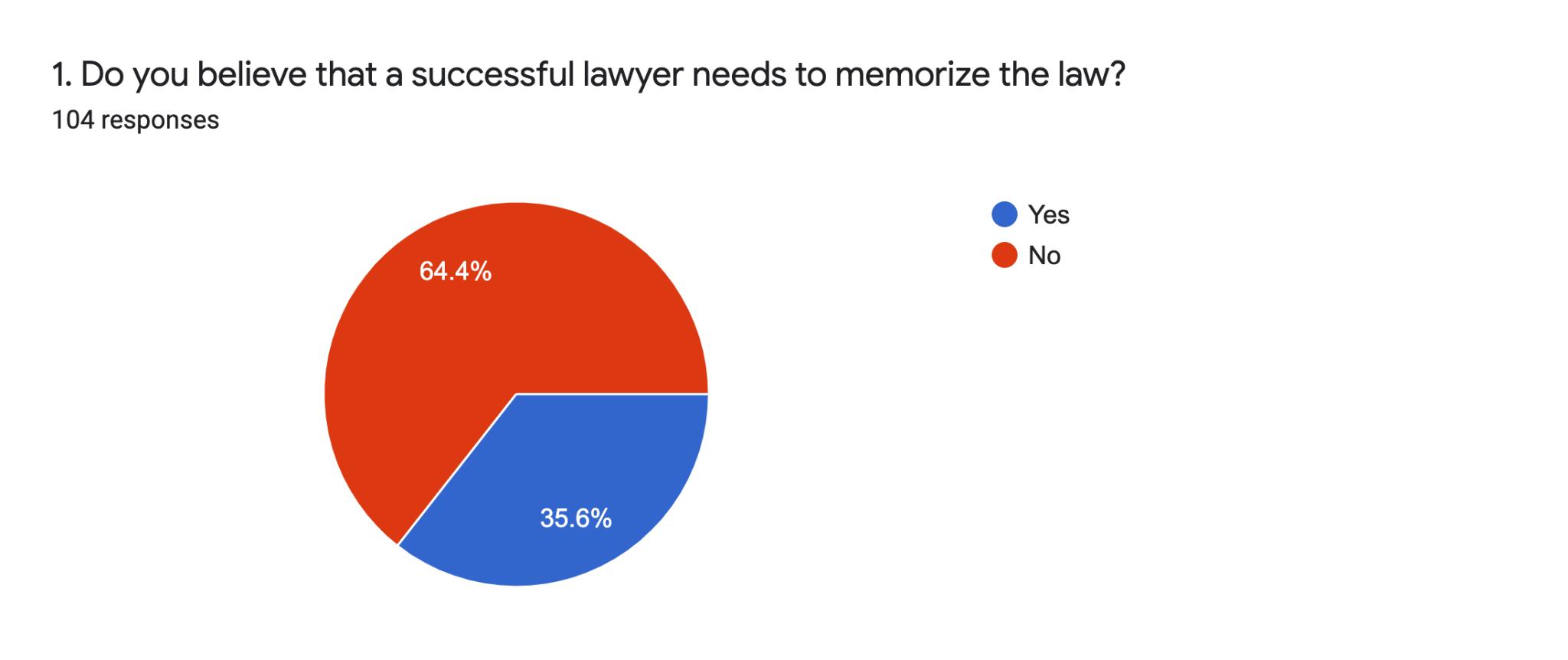
68. Amanda Fisher & Matthew Marin, Memory: Past, Present, & Future of Law School Exams Responses (last visited Jan. 22, 2023) (Google Sheets unpublished original data collected by the authors for this paper)(on file with authors).

2023] LAW SCHOOL EXAMS 39
For example, people wanted to differentiate between rote memorization and having a working knowledge of an area of practice. One respondent stated, in part, “I believe that lawyers should know the law. The word ‘memorization’ implies rote learning, rather than actual knowledge. But yes, lawyers should be capable of learning and remembering something about the law.”69 This was a common theme that arose in several of the comments after question one, suggesting that rote memorization is not necessarily a hallmark of a successful attorney but that a working knowledge is necessary to the practice of law.
Another theme was the difference between memorization of substantive principles versus procedure. One respondent clarified this distinction by stating, “I think lawyers need a familiarity with many legal principles, I don’t think they need pure memorization necessarily. (There are exceptions–thinking about the rules of Evidence during a trial.)”70 Another stated, “In the area of their expertise, tha[t] attorney should immediately know the relevant standards. A litigator must know [the] Federal Rules of Civil Procedure. A trial attorney must know [the] Federal Rules of Evidence.”71
The comments from respondents who do not believe memorization is necessary for success as a lawyer largely revolved around the fact that law changes and memories fail. One respondent indicated that lawyers’ training is focused on research, not memory. This person stated, “We are trained to conduct research. Even if we know the law it is always changing and you need to verify what you believe to be correct.”72 Another indicated that, “When practicing in real life, lawyers always have the necessary references to the law available to them. Practicing is an open book experience.”73
Based on the respondents’ answers about whether successful lawyers needed to memorize the law, we asked whether law schools should use closed-book exams. Although the majority of respondents answered that they do not believe lawyers need to memorize the law to be successful, the majority answered that law schools should use closed-book exams. Specifically, 58.7% of respondents answered that
40 W. MICH. U. COOLEY LAW REVIEW [Vol. 38:1
69. Id. 70 Id. 71 Id. 72 Id. 73 Id.
law schools should test with closed-book exams compared with 41.3% who said no.74
The comments of those who responded in favor of closed-book exams revolved largely around the format of the bar exam. Out of 35 comments in favor of closed-book exams for law schools, 20 of them directly cited the bar exam being closed-book as the reason for their response.75 Representative comments included, “Unless the bar exam becomes an open book exam we would not be preparing students by allowing open book exams in school,” and,
As long as the bar exam is administered as a closed-book exam, law schools have to teach students to be able to perform on the bar exam as a threshold performance before getting to practice. This creates an inherent disconnect between the academic world of law schools and bar exams and the actual applications when practicing.76
For responses coded as mixed between “yes” and “no,” 5 of the 28 comments also cited the bar exam as a reason for incorporating closed-book tests.77 The majority of these responses seem to favor a mixed-modalities approach where law school would include both open- and closed-book exams. Of the respondents who commented against using closed-book exams, the reasoning related back to
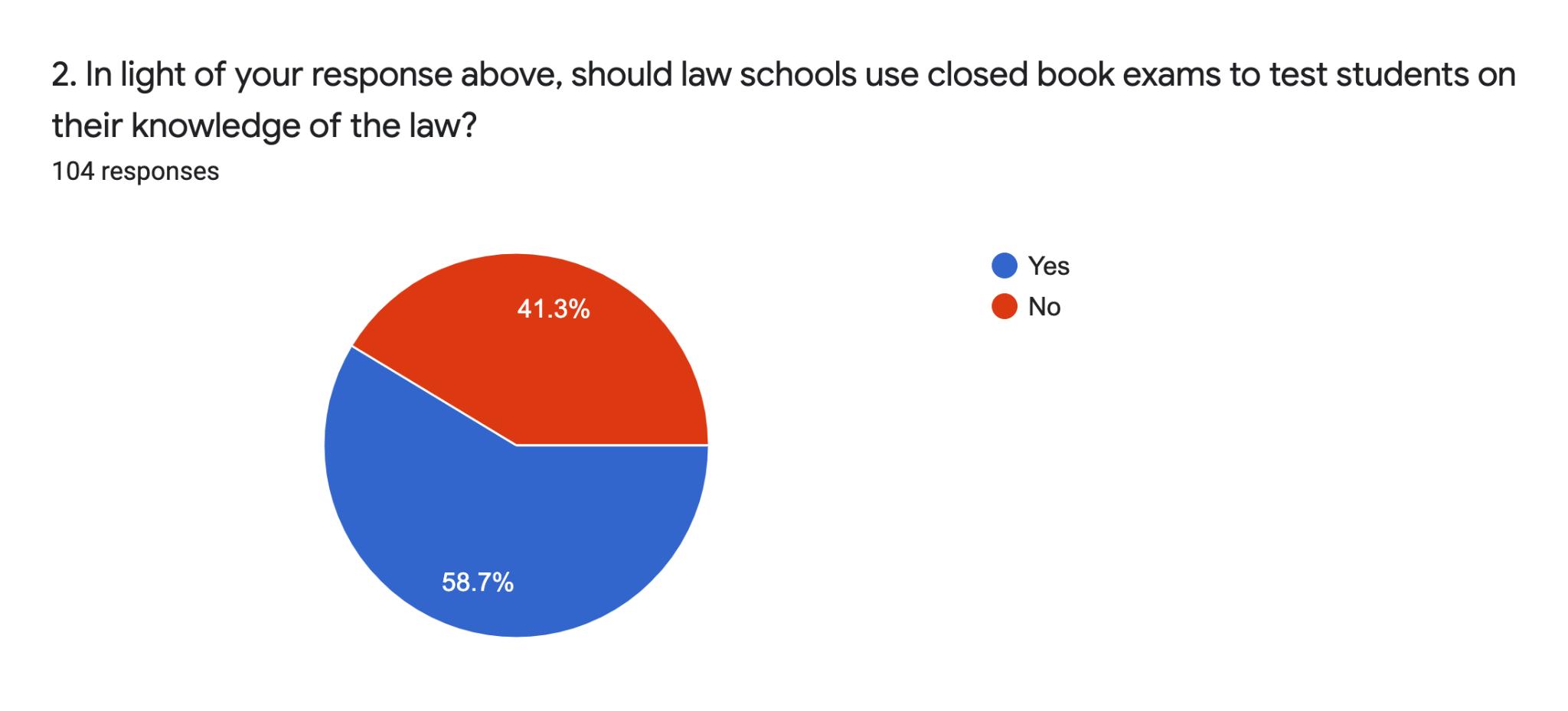
2023] LAW SCHOOL EXAMS 41
74 Id. 75 Id. 76 Id. 77 Id.
memorization being an unnecessary skill in practice and the unfair nature of closed-book exams to students with learning disabilities. Representative comments include, “Not every class needs a closed book exam. I think first year courses should still have closed book exams, but upper-level courses can use open-book take-home or timed exams,” and,
Question #2 is not a black and white answer in my opinion. It IS important to know and understand certain principles of the law; those could certainly be tested in a closed book exam. But to require them to memorize details of intricate statutes like the IRC, FRCP, the Michigan Probate Code, etc. is not beneficial. Those types of matters should be tested in an open book exam.78
The final question on the survey was whether bar exams should be closed-book. Although we could not have predicted that the reasoning for many of the respondents in question two would be related to the bar exam, this last question provided an opportunity to explore respondents’ thoughts on the bar-exam’s format. The majority of respondents, 60.6%, said that bar exams should not use a closed-book format compared with 39.4% who said that it should.79
The comments after this question brought out several concerns about inequities in the bar-exam’s procedure. One respondent stated, “It’s an old-fashioned way of looking at what makes a minimally
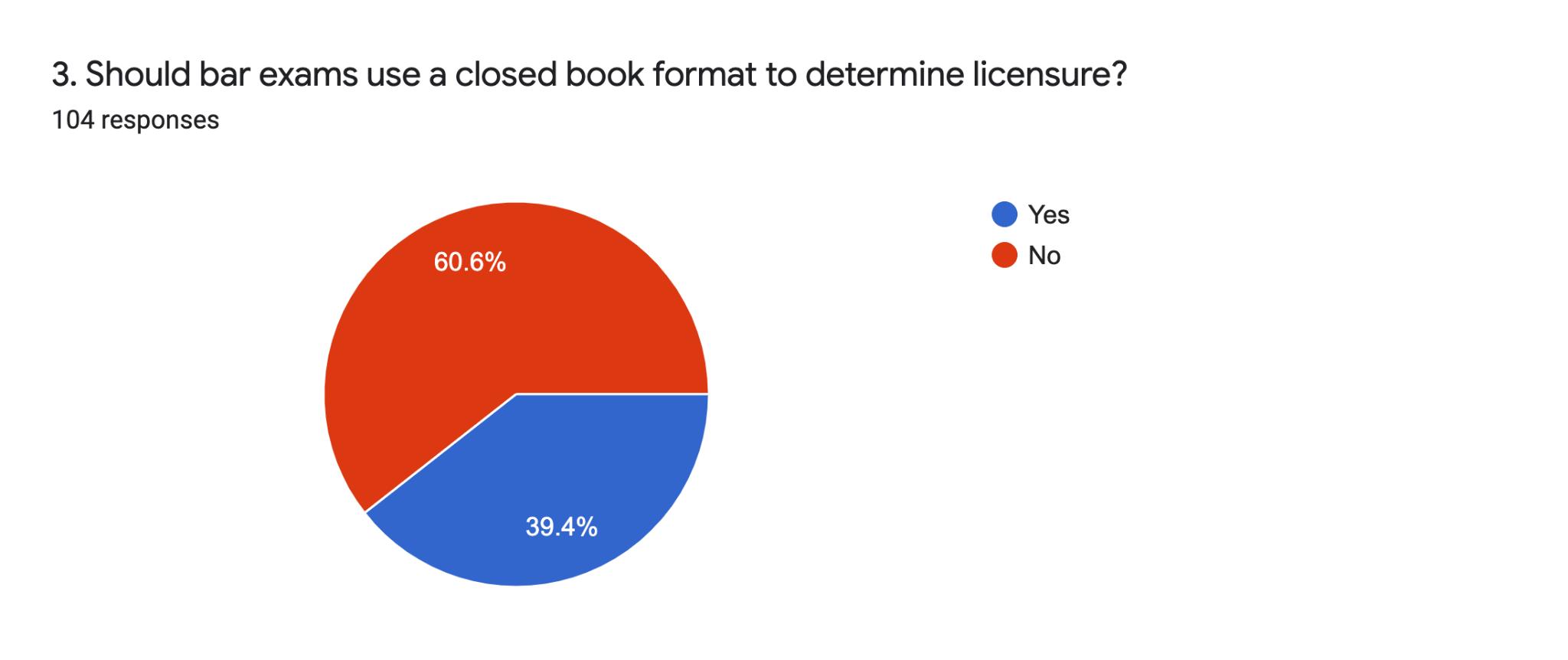
42 W. MICH. U. COOLEY LAW REVIEW [Vol. 38:1
78 Id. 79 Id.
competent attorney. It’s biased against brilliant legal minds who might not be able to memorize obscure rules of obscure subjects that they won’t need in practice.”80 Another participant stated the following:
If bar examiners of any state actually cared about licensing people who were capable of practice, then bar exams (if administered at all instead of putting an apprenticeship model in place) would consist of a series of MPTs and wouldn’t rely on essays or multiple choice to test minimum competency. And MPTs are essentially closed-universe, but open-book, exams because the test itself provides all of the necessary materials for performance.81
Another respondent stated this:
[I]t is unnecessary, inappropriate, and harmful gatekeeping; an exclusionary hazing exercise based on outdated beliefs that have absolutely nothing to do with the excellent practice of law. [N]o one in the history of the world has ever said, “[I] remember what [I] studied for the bar and that helped me serve my client today.” [A]ll of that rote memorization exits the memory the day after the bar exam. [I]t serves no useful purpose; it serves only harmful purposes.82
Within this data, themes emerged separately within the comments but also interacted between the survey questions in intriguing ways. The next section explores these outcomes in more detail.
IV. DISCUSSION
During the COVID-19 pandemic, Western Michigan University Thomas M. Cooley Law School (“WMU-Cooley”) chose to largely give open-book exams. These exams often allowed students to use their course materials, including books and notes, but did not allow collaboration between students. Students were generally given a longer block of time to complete their exams as well. These decisions were a result of navigating the complications of online law school during a pandemic and how to maintain academic rigor. Once classes resumed in-person, students who entered WMU-Cooley during the pandemic were panicked about the thought of closed-book examinations because they had come to rely on their ability to consult books and notes when necessary. They also were used to
2023] LAW SCHOOL EXAMS 43
80 Id. 81 Id. 82 Id.
having a longer time frame to answer questions and thus had not felt the time-pressure of a traditionally timed, closed-book, closed-note law school exam. With the return to primarily in-person exams, certain procedures were put in place to begin preparing students for that testing modality. For example, many faculty members offered mock exams and study tips to help students feel prepared for testing in the traditional format.
Meanwhile, the faculty were having impassioned conversations about which testing option was the “best.” Several faculty members were concerned about the increased ability for students to cheat during open-book exams. There were added concerns that our administrative process for honor-code violations would be overburdened, investigating every possible incident of collaboration. Some also thought that there was more collaboration happening than we might even know about, and the students would not be really learning the material that they needed to be learning. In reality, the deans reported that the incidents of honor-code violations were about the same as when the institution only administered closed-book exams. On the other hand, there were faculty members who pointed to the fact that open-book exams could result in better learning of the legal concepts because students would not be focused primarily on rote memorization for expressing verbatim rule statements back into an essay response.
These conversations about exam format often devolved into concerns about bar exam preparation. Although the goals of law school exams and bar exams are different, there seemed to be immense concern that if law schools did not administer closed-book exams, students would not be prepared to successfully pass a bar examination after graduation. These concerns formed the basis of our preliminary survey: do lawyers need to memorize law to be successful? If not, then should exams mirror the skills necessary in the profession, or is there a benefit to memorization of several areas of law through law school and on the bar exam?
Question 1
The variety of comments in response to question 1 leads one to believe that there is a spectrum between someone who knows absolutely nothing about the law and must look up every detail (“Neither a client nor a judge wants to hear ‘I don’t know the law, let me look up.’ While, in some areas, the law constantly changes, it is
44 W. MICH. U. COOLEY LAW REVIEW [Vol. 38:1
important to have a working knowledge committed to memory.”) to another having every bit of law memorized (“Practicing attorneys rarely, if ever, need to know the law verbatim off hand.”83). While the responses ranged from one end to the other, the consensus seemed to fall somewhere in the middle. Lawyers need to have foundational knowledge of the basics of law and a working knowledge of their specific area of law in order to be successful. One comment sums up this perspective: “A successful lawyer must have internalized enough law to know what framework to apply or what questions to ask. Strictly speaking, this involves some memorization. However, I don’t believe that the extent of the memorization needs to be as great as law school and bar testing would suggest.”84
Question 2
Interestingly, despite the majority response to question 1 that memorization is not crucial to being a successful attorney, the opposite response was the majority for question 2. Most respondents still believe that law schools should use closed-book examinations. While there were comments indicating that people feel strongly about closed-book testing being the superior testing modality because it forces deeper learning, about 57% of the comments supporting closed-book examinations cited their main reasoning as the bar being closed-book.85 This pattern of responses leads directly to our analysis of question 3.
Question 3
The comments in this question revealed two primary themes to be examined in more detail. One is a preference for closed-universe exam exercises such as the MPT rather than strictly open- versus closed-book exercises. Additionally, several comments to this question mention inequities. For example, one respondent wrote, “The only reason that I hesitate here is that open-book bar exams might introduce inequities not currently present in the testing system. Do we think that all exam takers actually have equal access to the
2023] LAW SCHOOL EXAMS 45
83 Id. 84 Id. 85 Id.
same books and resources?”86 But even with the current testing modalities of the bar exam in all jurisdictions there is a problem with access to resources. Under the current system, many bar takers cannot afford the thousands of dollars it costs to procure a commercial, comprehensive bar prep course. Passing a bar exam without having taken one of these courses is rare, and it is largely impossible for many law school graduates given the differing goals of law school classes and the bar exam.
The juxtaposition of these three survey questions provided for an interesting colloquy of themes that emerged from the comment sections. A majority of the respondents believed that memorization is not needed for a lawyer to be a successful practitioner. However, most of the respondents seemed to agree that law school exams should emulate what is required on the bar exam. In addition, many respondents expressed strong favor for bar-exam reform. With the current discontinuity between the skills tested on the bar exam and the skills used in practice, there seems to be plenty of room to bridge the gap.
V. CONCLUSION
Our survey questions were intentionally broad to encourage further explanations in the qualitative components, but this left several questions unanswered. Moreover, due to our recruitment methods, we had many more academic participants (faculty and staff within law schools) than people squarely within the legal profession (current practitioners or judges). Because of those known and expected limitations in the way the preliminary survey questions were drafted, we plan to conduct a follow-up survey developed based on the predominant themes that came out of the preliminary survey. The follow-up survey will include more detailed demographics of individual respondents. Further, we will recruit participants from more diverse places. Considering our own positionality as academics, we will actively seek to recruit from the legal profession. We will connect with local judges and lawyers and ask them to share with their colleagues, too (snowball sampling87).
86 Id.
87. Toni Crouse & Patricia A. Lowe, Snowball Sampling, SAGE PUBLICATIONS, INC. (2018) (“Snowball sampling is a sampling method used by researchers to generate a pool of participants for a research study through referrals made by individuals who share a particular characteristic of research interest with the target population”).
46 W. MICH. U. COOLEY LAW REVIEW [Vol. 38:1
One of the largest areas of cognitive dissonance when considering open- versus closed-books exams both during law school and for the bar exam is when one considers that the goals of each of these exams are different. How, then, can law school achieve the goals of teaching the foundational basics in order to provide the framework needed for successful practice while also ensuring that the graduates of the law school are prepared to take a bar exam? Moreover, another pressing question is whether law schools higher in the hierarchy concern themselves with the goal of preparing graduates for the bar exam or if they, instead, believe bar preparation is the responsibility of bar preparation courses and not the law school?88 The American Bar Association sets the standards for all accredited law schools, but each school has to create its own pathway to reaching those goals.89
Testing during law school may be the responsibility of individual professors or institutions, but the responsibility of the bar exam is to all applicants.90 Ensuring a path to licensure that is equitable and fair is daunting, but necessary. With applicants having unequal access to preparation materials, having differing strengths and weaknesses, and
88. See Gabriel Kuris, Law School Applicants and the Bar Exam, U.S. NEWS (July 19, 2021), https://www.usnews.com/education/blogs/law-admissionslowdown/articles/what-law-school-applicants-should-know-about-the-bar -exam#:~:text=Most%20law%20schools%20try%20to,a%20high%20bar %20passage%20rate (“Most law schools try to help their students prepare for the bar exam [and] some focus intently on ensuring their students pass, because a school’s bar passage rate can affect its ranking and reputation”).
89. See 2021-2022 Standards and Rules of Procedure for Approval of Law Schools, A.B.A., https://www.americanbar.org/groups/legal_education /resources/standards/ (last visited June 8, 2022).
90 See Christina Shu Jien Chong, Battling Biases: How Can Diverse Students Overcome Test Bias on the Multistate Bar Examination, 18 U MD. L.J. 31, 32 (2018) (“The American Bar Association (ABA) claims the bar exam is a valid licensure test because it uses an objective standard to evaluate students and requires a comprehensive review of the law that motivates students to work hard in law school to obtain the skills necessary to pass the exam.”). But see Valerie Strauss, Why This Pandemic Is a Good Time to Stop Forcing Prospective Lawyers to Take Bar Exams, WASH. POST (July 13, 2020), https://www.washingtonpost.com/education/2020/07/13/whythis-pandemic-is-good-time-stop-forcing-prospective-lawyers-take-bar -exams/ (“The exam is equal parts a standardized test and hazing ritual” and “[s]tudies linking the bar exam to protection of the public or success as a lawyer are scare[;] in California, a state with a notoriously low bar passage rate, the state bar has admitted that what constitutes minimum competency has never even been identified.”).
2023] LAW SCHOOL EXAMS 47
the general push for more diverse demographics in the profession, reconsidering whether closed-book examinations are achieving these goals is imperative.91 COVID-19 allowed an opportunity for legal education and licensure to be re-examined and for new methods to be tested. But it seems that for as long as the bar exam is primarily being tested in a closed-book format, then law schools should also be testing in closed-book format.92 However, based on the responses to our preliminary survey, it seems that many respondents feel that if the bar-exam format changes, then law school testing modalities can follow suit. The climate may be ripe to not go back to “business as usual,” but instead embrace the opportunity to align both law-school and bar examinations with the practice of law.
91 Lerman et al., supra note 31, at 46 (stating that it has not always been that “[w]hen you look around . . . law school classrooms [that] you may see men and women, people of all races and many nationalities, people with diverse religious affiliations (or with no affiliation), gay and straight people, old and young people, and people with disabilities.”). See also Council Moves to Strengthen Law School Diversity Mandates, A.B.A., https://www.americanbar.org/news/abanews/aba-newsarchives/2021/11/law-school-diversity/ (last visited June 8, 2022).
92. The National Conference of Bar Examiners is designing and implementing the NextGen bar exam to address some of the critiques mentioned in our study. Even the NextGen bar exam, however, is designed as a closed-book metric, so much of the commentary will still apply.
48 W. MICH. U. COOLEY LAW REVIEW [Vol. 38:1
READING BETWEEN THE WINES: GRANHOLM V. HEALD’S IMPLICATIONS FOR OTHER INDUSTRIES
TYLER R. SMOTHERMAN1 ABSTRACT
Almost two decades have passed since the Supreme Court decided Granholm v. Heald, in which the Court held that states cannot discriminate against interstate commerce by allowing in-state wineries to ship wine directly to consumers but prohibiting out-ofstate wineries from doing the same. Yet, the Granholm Court’s reasoning and application of the dormant Commerce Clause remain eminently relevant today – and not just for wine lovers. Indeed, Granholm’s legal, economic, and constitutional implications now reach far beyond wine law and the wine industry.
This Article is the first to apply Granholm v. Heald to multiple nonwine-related industries. By recontextualizing Granholm, this Article shows this seminal “wine law” case to have significant implications for the craft-beer industry, the meat industry, and the budding marijuana industry. Specifically, this Article argues that Granholm’s dormant Commerce Clause holdings about wine should be applied equally to craft beer. It also argues that Granholm makes it unlikely
1. Prosecutor, Lubbock County, Texas Criminal District Attorney’s Office (Practicing Under Supervision); J.D., Texas Tech University School of Law, 2023; M.A. Political Science, Washington State University, 2018; B.A. Political Science & International Studies, University of Idaho, 2014. For introducing me to wine law and the dormant Commerce Clause, respectively, I would like to thank Professors Alyson Outenreath and Rick Rosen. For their patience, love, and support, a special thank you to Rachel, Raegan, and Callan. And finally – for making law school a little looser and less laborious – this Article is dedicated to my friends and fellow wine scholars (and drinkers): Jacey, Nathan, AJ, Brad, Victor, Alexandra, Travis, and Morgan. The opinions and analysis in this Article are the Author’s alone and do not represent the views of any other person or organization, particularly the Lubbock County District Attorney’s Office.
that California and Mississippi will ultimately succeed in their ongoing attempts to restrict out-of-state meat products. Finally, this Article makes the case that Granholm’s holdings complicate any future national legalization of marijuana and must be considered if commercial marijuana is to be regulated effectively. Just as Granholm was a boon to wine companies and consumers, so too do Granholm’s principles have the potential to transform other markets and industries. Thus, to harness the power of Granholm for their clients’ benefit, attorneys representing the beer, meat, and marijuana industries need only read between the wines.
I. INTRODUCTION
Eighteen years have passed since the Supreme Court decided every wine lover’s favorite case, Granholm v. Heald. 2 There, the Court held that states cannot discriminate against interstate commerce by allowing in-state wineries to ship wine directly to consumers while prohibiting out-of-state wineries from doing the same.3 Wine connoisseurs were more excited about this wine case than they were about their favorite case of wine.4 No doubt Granholm is a seminal case for wine-law students and winos; however, its legal, economic, and constitutional implications extend far wider than the wine industry.5
This Article is the first to apply Granholm v. Heald to multiple non-wine-related industries. Several academic articles have analyzed Granholm and its effects on the wine industry – or on alcohol regulations – over the last eighteen years.6 At least one article applied
2 Granholm v. Heald, 544 U.S. 460 (2005).
3 Id. at 466.
4. See CAROL ROBERTSON, THE LITTLE RED BOOK OF WINE LAW: A CASE OF LEGAL ISSUES 107 (2008).
5 See infra Part III.
6 See, e.g., Aaron Nielson, Good History, Good Law (and by Coincidence Good Policy Too): Granholm v. Heald, 29 HARV. J. L. & PUB. POL’Y 743 (2006); Noah Stanzione, Granholm v. Heald: Wine in, Wit out, 17 WIDENER L. REV. 95 (2011); Desiree Slaybaugh, A Twisted Vine: The Aftermath of Granholm v. Heald, 17 TEX. WESLEYAN L. REV. 265 (2011); Kendall Dicke, Wait or Discriminate? Implications of Tennessee Wine & Spirits Retailers Ass’n v. Thomas on the Alcohol Market, 81 LA. L. REV. 581, 602-04 (2021); Alyson Outenreath, Battle Against Liquor: Will Wal-Mart Soon Be at the U.S. Supreme Court?, 90 MISS. L. J. 347,
50 W. MICH. U.
COOLEY LAW REVIEW [Vol. 38:1
Granholm to a different area of law, and another examined Granholm’s implications for the beer industry 7 But this Article is the first in-depth application of Granholm’s holding and reasoning to several non-alcohol-related industries. By recontextualizing Granholm, this Article shows that this seminal “wine-law” case has significant implications for the craft-beer industry, the meat industry, and the budding marijuana industry.8
Part I introduces Granholm and its importance.9 Part II provides background and context related to the Commerce Clause, the Twenty-first Amendment, and Granholm itself.10 Part III discusses Granholm’s importance and implications for the craft-beer, meat, and marijuana industries, respectively.11 Specifically, Part IIIA argues that Granholm’s holdings about wine should be applied equally to craft-beer.12 Part IIIB argues that Granholm makes it unlikely that California and Mississippi will succeed in their attempts to restrict out-of-state meat products.13 Part IIIC argues that Granholm’s holdings complicate any future national legalization of marijuana and must be considered if commercial marijuana is to be regulated effectively.14 Part IV concludes the Article.15
II. GRANHOLM V HEALD: THE COMMERCE CLAUSE, THE TWENTY-FIRST AMENDMENT, AND THE CASE IN CONTEXT
The Commerce Clause of the Constitution provides that “[t]he Congress shall have the power . . . [t]o regulate commerce with foreign nations, and among the several states, and with the Indian tribes.”16 According to Supreme Court decisions dating as early as
368-70 (2021).
7 See Alyson Outenreath, Cheers! Ending Quill. . .What Can Be Learned from the Wine Industry, 48 N.M.L. REV. 372, 404-14 (2018); Daniel Croxall, Delirium of Disorder: Tension Between the Dormant Commerce Clause and the Twenty-First Amendment Stunts Independent Craft Brewery Growth, 126 PENN ST. L. REV. 435 (2022).
8 See infra Part III.
9 See supra Part I.
10 See infra Part II.
11 See infra Part III.
12. See infra Part IIIA.
13 See infra Part IIIB.
14 See infra Part IIIC.
15 See infra Part IV.
16 U.S. CONST. art. I, § 8, cl. 3.
2023] READING
BETWEEN THE WINES 51
1824, the Commerce Clause contains an implied negative corollary, the dormant Commerce Clause (DCC).17 Because the Constitution explicitly grants Congress the power to regulate interstate commerce, the implication is that absent congressional approval state laws violate the unwritten rules of the dormant Commerce Clause “by imposing an undue burden on both out-of-state and local producers engaged in interstate activities or by treating out-of-state producers less favorably than their local competitors.”18 Specifically, states violate the DCC if they mandate “differential treatment of in-state and out-of-state economic interests that benefits the former and burdens the latter.”19 This includes enacting laws “that burden out-ofstate producers or shippers simply to give a competitive advantage to in-state businesses.”20 The principle behind the dormant Commerce Clause was a primary justification for the Constitution.21 The DCC’s mandate of economic nondiscrimination between states reflect[s] a central concern of the Framers that was an immediate reason for calling the Constitutional Convention: the conviction that in order to succeed, the new Union would have to avoid the tendencies toward economic Balkanization that had plagued relations among the Colonies and later among the States under the Articles of Confederation.22
The regulation of alcoholic beverages has long played a central role in the development of the dormant Commerce Clause doctrine.23 Before Prohibition in 1920, states made persistent efforts to control or ban alcohol, and courts were frequently called upon to determine if state liquor laws constituted an impermissible burden on interstate commerce.24 When the ratification of the Eighteenth Amendment essentially banned alcohol nationwide, this became a non-issue 25 But
17 Margot Mendelson, The Commerce Clause and the Twenty-First Amendment: An Evolving Constitutional Puzzle, WINE IN AMERICA: LAW AND POLICY 183, 184 (Richard Mendelson ed., 2011).
18. Granholm v. Heald, 544 U.S. 460, 493 (2005) (Stevens, J., dissenting); see also Pike v. Bruce Church, Inc., 397 U.S. 137 (1970); Philadelphia v. New Jersey, 437 U.S. 617 (1978).
19 Or. Waste Sys., Inc. v. Dep’t of Env’t Quality, 511 U.S. 93, 99 (1994).
20 Granholm, 544 U.S. at 472 (majority opinion).
21 Id.; Mendelson, supra note 17, at 184.
22. Hughes v. Oklahoma, 441 U.S. 322, 325-26 (1979); see also Mendelson, supra note 17, at 184.
23 Mendelson, supra note 17, at 185.
24 Id.
25 U.S. CONST. amend. XVIII (repealed 1933).
52 W. MICH. U. COOLEY LAW REVIEW [Vol. 38:1
when Prohibition was repealed by the Twenty-first Amendment thirteen years later, “a new field of constitutional analysis specific to ‘intoxicating liquors’” was born.26 Section One of the Twenty-first Amendment repealed the Eighteenth Amendment and ended Prohibition.27 Section Two stated that “[t]he transportation or importation into any State, Territory, or possession of the United States for delivery or use therein of intoxicating liquors, in violation of the laws thereof, is hereby prohibited.”28 The Twenty-first Amendment and dormant Commerce Clause appear at odds because Section Two seemed “to give states the freedom to regulate alcoholic beverages, even when those regulations clearly discriminated against interstate commerce, such as by imposing costly license fees or taxes on alcoholic beverages from out of state.”29 It is in the context of this tension between two constitutional provisions that Granholm v. Heald was born.30
Granholm v. Heald was a unique case in that it “pitted the protective language of the Twenty-first Amendment . . . against the principles of economic unity among states espoused by the Commerce Clause.”31 Following the U.S. wine renaissance and the technological revolution, American consumers began clamoring for direct access to wines nationwide 32 Online commerce became commonplace in the early 2000s, and consumers expected to be able to order out-of-state wines over the internet.33 Unfortunately, about half the states allowed no direct-to-consumer (DtC) shipments of wine whatsoever.34 Several other states placed significant restrictions on interstate shipments by out-of-state wineries that were not applied to in-state wineries.35 Granholm concerned exactly this type of unequal treatment 36
In Granholm v. Heald, a 5-4 Supreme Court held that allowing in-state wineries to ship wine directly to consumers – while prohibiting out-of-state wineries from doing the same –
26. Mendelson, supra note 17, at 185; U.S. CONST. amend. XXI.
27 U.S. CONST. amend. XXI, § 1.
28 U.S. CONST. amend. XXI, § 2.
29 Mendelson, supra note 17, at 185.
30 Id.
31 Id. at 183.
32. Id. at 206.
33 Id.
34 Id. at 208.
35 Id. at 207-08.
36 Robertson, supra note 4, at 107.
2023] READING BETWEEN THE WINES 53
“discriminate[s] against interstate commerce in violation of the Commerce Clause, and that the discrimination is neither authorized nor permitted by the Twenty-first Amendment.”37 There, the Court addressed consolidated challenges against direct-shipment prohibitions in both Michigan and New York.38 The Supreme Court also settled a circuit split because the Sixth Circuit had struck down Michigan’s law while the Second Circuit had upheld New York’s law.39 In affirming the Sixth Circuit and reversing the Second Circuit, the Supreme Court acknowledged that most states in exercising their authority under the Twenty-first Amendment regulate the importation and sale of alcohol through a three-tier distribution system (separate licenses are required for producers, wholesalers, and retailers).40 The Court recognized the legitimacy of the three-tier system and other state alcohol regulations under the Twenty-first Amendment.41 But the Court rejected the argument that the Amendment gave states “the authority to pass nonuniform laws in order to discriminate against out-of-state goods, a privilege they had not enjoyed at any earlier time.”42 On the contrary, Section Two merely “restored to the States the [pre-Prohibition] powers they had under the Wilson and Webb-Kenyon Acts,” which never included the ability to “give a discriminatory preference to their own [alcohol] producers.”43 The Court clarified that the Twenty-first Amendment grants states “virtually complete control” over alcohol regulation (even permitting a total ban on all sale, consumption, and importation), but states must “treat liquor produced out of state the same as its domestic equivalent.”44
The Court rejected Michigan’s and New York’s arguments that restricting DtC shipments from out-of-state wineries was necessary to keep alcohol out of the hands of minors and facilitate tax collection.45
37 Granholm v. Heald, 544 U.S. 460, 466 (2005).
38. Id. at 465-66; Robertson, supra note 4, at 107.
39. See Granholm, 544 U.S. at 466; Robertson supra note 4, at 107.
40 Granholm, 544 U.S. at 466.
41 Id. at 484-85 (“The aim of the Twenty-first Amendment was to allow States to maintain an effective and uniform system for controlling liquor by regulating its transportation, importation, and use.”).
42 Id. (emphasis added).
43. Id. at 484-86.
44 Id. at 488-89.
45 Id. at 489-92 (“[T]he States provide little concrete evidence for the sweeping assertion that they cannot police direct shipments by out-of-state wineries.”).
54 W. MICH. U.
COOLEY LAW REVIEW [Vol. 38:1
It also rejected their secondary rationales related to “facilitating orderly market conditions, protecting public health and safety, and ensuring regulatory accountability” because these goals can all “be achieved through the alternative of an evenhanded licensing requirement.”46 The Court reasoned that the burden is on states to show the economic discrimination is justified and that none of Michigan’s or New York’s arguments “justified treating out-of-state producers differently from in-state vintners.”47
In short, the Granholm Court held that “states were free to regulate the direct shipment of wine as they saw fit, as long as they treated in-state and out-of-state wineries equally and uniformly.”48 The Court “did not mandate any particular direction for states to take. A state may ban or allow direct shipments of wine as long as the decision applies equally to all wineries.”49
As illustrated most prominently by Granholm, wine has occupied a central role in dormant Commerce Clause jurisprudence.50 Whereas beer and spirits dominated earlier cases, wine has become the focal point of recent DCC and Twenty-first Amendment debates postGranholm. 51 “Not only is wine shaping the dormant Commerce Clause jurisprudence, but the jurisprudence, in turn, is shaping the wine industry.”52 But it is not only the wine industry that Granholm has been shaping over the last eighteen years.53 Despite its reputation as a wine-law case, Granholm has significant implications for other products and industries as well.54
III. GRANHOLM’S IMPLICATIONS FOR OTHER INDUSTRIES
In Granholm v. Heald, the Court certainly “made waves among court watchers and wine lovers alike[]” for its significant holdings related to both the dormant Commerce Clause (DCC) and the wine industry.55 Granholm represented another significant brick in the
46 Id. at 492.
47 Id. at 492-93; Robertson supra note 4, at 112.
48 Robertson, supra note 4, at 112.
49 Id.
50. Mendelson, supra note 17, at 186.
51. Id.
52 Id.
53 See infra Part III.
54 See infra Part III.
55 Mendelson, supra note 17, at 183.
2023] READING
BETWEEN THE WINES 55
Supreme Court’s dormant Commerce Clause wall and a boon to wine producers and consumers alike.56 In general, it caused most states to “level up,” allowing both in-state and out-of-state wine producers to ship their products directly to consumers within the state.57 Contrary to many predictions and much to the disappointment of some Granholm did not spell the demise of the three-tier distribution system.58 Nor is there evidence that Granholm caused increased rates of underage drinking, driving-under-the-influence cases, or other alcohol-related problems.59
Although Justice Thomas continues to be no fan of Granholm (or the dormant Commerce Clause in general), it is unlikely the Supreme Court as a whole will back away from its holdings in Granholm
56. See Mitchell Zolton, Direct Shipping for Michigan Beer? Wine Not, 2020 MICH. ST. L. REV. 509, 530-31 (2020) (explaining that direct shipment comprised only 3% of wine sales pre-Granholm, but had increased to over 10% of total U.S. wine sales by 2017); 15 Years After Winery DTC Shipping’s Milestone Day, FREE THE GRAPES! (May 12, 2020), https://freethegrapes.org/15-years-after-winery-dtc-shippings-milestoneday/ (“The number of wineries in the U.S. has more than doubled [since Granholm].”).
57. Outenreath, supra note 7, at 410-11; Direct-to-Consumer Shipping Laws for Wineries, WINE INSTITUTE, https://wineinstitute.compliancerules.org /state-map/ (last visited Nov. 18, 2022) (showing forty-five states and D.C. allow DtC shipping for wineries); 15 Years After Winery DTC Shipping’s Milestone Day, supra note 56 (“In 2004, only 27 states allowed winery DTC. Today: 45 do. In 2004, wineries had the option of direct shipping to 51% of consumers. Today: legal states comprise 95%+ of the U.S. population.”).
58 Granholm v. Heald, 544 U.S. 460, 488-89 (2005) (quoting North Dakota v. United States, 495 U.S. 423, 432 (1990)) (explaining that “the three-tier system is ‘unquestionably legitimate’” and that states can even ban the sale, consumption, and importation of alcohol altogether).
59. See Matthew Chambers et al., Drunk Driving by the Numbers, BUREAU OF TRANSP. STAT., U.S. DEP’T OF TRANSP. (Mar. 7, 2013), https://www.bts.gov/archive/publications/by_the_numbers/drunk_ driving/index; Underage Drinking, CTRS. FOR DISEASE CONTROL AND PREVENTION, https://www.cdc.gov/alcohol/fact-sheets/ underagedrinking.htm (last visited Nov. 19, 2022) (stating underage drinking has “been declining in recent decades”). But see Elyse R. Grossman, The Changing Legal Landscape of Direct-to-Consumer Shipping of Alcohol Products: What Does the Future Hold for Public Health?, 16 HEALTH L. & POL’Y BRIEF 7, 10 (2022) (“Research shows that direct-to-consumer (DTC) shipping practices often result in increased underage alcohol consumption and, in turn, increased alcohol-related harms.”).
56 W. MICH.
U. COOLEY LAW REVIEW [Vol. 38:1
anytime soon.60 In fact, the Court recently doubled down on Granholm in Tennessee Wine & Spirits Retailers Ass’n v. Thomas, which many consider to be Granholm’s successor.61 In Tennessee Wine, a 7-2 Court (with Justices Gorsuch and Thomas dissenting) held that Tennessee’s two-year residency requirement to obtain a retail liquor store license violated the dormant Commerce Clause and was not saved by the Twenty-first Amendment.62 Tennessee Wine clarified that the Court’s dormant Commerce Clause analysis in Granholm applies not only to alcohol producers but retailers as well.63 Essentially, Tennessee Wine “built upon the groundwork that Granholm laid toward a free-market” and suggests that Granholm “appl[ies] to all three levels of the three-tier distribution system.”64
While Granholm undoubtedly left its mark on the Court’s dormant Commerce Clause jurisprudence and had a profound effect on the wine industry, these topics have already been discussed in the academic literature.65 The focus of this Article is more unconventional: Granholm v. Heald’s implications and potential effects on other industries.66 Granholm’s analysis and holdings likely have legal and economic implications for several non-wine-related industries.67 This Article explores three examples: craft beer, meat and meat alternatives, and commercial marijuana.68
60 See Granholm, 544 U.S. at 497 (Thomas, J., dissenting); Camps Newfound v. Town of Harrison, 520 U.S. 564, 610 (1997) (Thomas, J., dissenting) (“The negative Commerce Clause has no basis in the text of the Constitution, makes little sense, and has proved virtually unworkable in application.”). See generally James M. McGoldrick, Jr., Why Does Justice Thomas Hate the Commerce Clause?, 65 LOY. L. REV. 329 (2019).
61. See Tenn. Wine & Spirits Retailers Ass’n v. Thomas, 139 S. Ct. 2449, 2457 (2019); Dicke, supra note 6, at 606.
62 Tenn. Wine, 139 S. Ct. at 2476; Id. at 2477 (Gorsuch, J., dissenting).
63 Dicke, supra note 6, at 606-07.
64 Id. at 615-16.
65 See, e.g., Nielson, supra note 6, at 743; Stanzione, supra note 6, at 95; Slaybaugh, supra note 6, at 265; Dicke, supra note 6, at 601-05, at 581; Outenreath, supra note 6, at 367-70.
66 See infra Parts IIIA, IIIB, and IIIC.
67 See infra Parts IIIA, IIIB, and IIIC.
68 See infra Parts IIIA, IIIB, and IIIC.
2023] READING BETWEEN THE WINES 57
A. The Craft-Beer Industry
Perhaps the most obvious non-wine industry affected by Granholm is the “booming” craft-beer industry in the United States.69 To qualify as a craft brewer, one must generally be small (producing under 6 million barrels of beer annually), independent (no more than 25% ownership by a non-craft brewer), and a brewer by law (recognized by the Alcohol and Tobacco Tax and Trade Bureau).70 Brewing beer was an American tradition over a century before the founding; the first known brewery was started in modern-day New York City in 1612.71 Modern “home brewing of craft beers began as early as the 1980s” in the United States, but has seen a resurgence in recent years due to do-it-yourself mentalities, “buy local” and sustainability initiatives, and “hipster” trends.72 Frustrated by “massproduced beer made from cheap ingredients” and seeking a more enjoyable social atmosphere, many “consumers have shifted towards [the] quality and experience” of craft breweries and taprooms.73 From 2018–2019, the number of operational craft breweries in the United States increased from 6,464 to 8,275.74 Likewise, from 2017–2019, the amount of craft beer produced increased 5% every year.75 The craft-beer industry contributes over $83 billion to the U.S. economy each year, and the global craft-beer industry is soon expected to exceed $500 billion per year.76 While the industry’s growth may be peaking and continues to confront significant opposition from the major breweries (e.g., MillerCoors and Anheuser-Busch), craft beer is undoubtedly here to stay.77
Like the small wineries in Granholm, many smaller craft breweries rely on direct-to-consumer (DtC) shipping of their products to survive.78 This was especially true during the COVID-19
69 Michaela A. Hendricks, Wisconsin’s Craft Beer Industry: Crafting Better Law for a More Competitive Market, 104 MARQ. L. REV. 913, 924 (2021).
70. Id. at 922-23.
71 Zolton, supra note 56, at 513.
72 Shirley Chen, Craft Beer Drinkers Reignite the Wine Wars, 26 LOY. CONSUMER L. REV. 526, 539-40 (2014).
73 Hendricks, supra note 69, at 924.
74 Id.
75. Id. at 925.
76 Id.
77 Id.
78 Croxall, supra note 7, at 435; Outenreath, supra note 7, at 399 (“[S]mall wineries . . . needed to depend on online sales as part of their business
58 W. MICH.
U. COOLEY LAW REVIEW [Vol. 38:1
pandemic when “the pandemic closed two of the three main revenue sources for craft breweries: taproom sales and sales to bars and restaurants. This left DtC sales as the only revenue source for many small and independent breweries.”79 Unfortunately, “[d]espite the Supreme Court seemingly reconciling this issue in 2005 in Granholm v. Heald, the states have been anything but consistent” in applying DtC shipping laws to craft breweries.80 Inconsistent application and interpretation of Granholm has led to a federal circuit split and conflicting conclusions as to whether states can still discriminate against out-of-state breweries by prohibiting their beer shipments into the state while allowing in-state breweries to ship within the state 81 While there is little reason to treat beer differently than wine under Granholm, states are doing just that.82 Although forty-five states allow out-of-state wineries to ship wine directly to consumers, only twelve states allow out-of-state breweries to do the same.83
While states’ attempts to retain as much control as possible postGranholm are perhaps understandable, one would expect federal circuit courts to interpret and apply Granholm’s binding precedent faithfully.84 Unfortunately, most have not done so when considering DtC shipping of craft beer.85 A few circuit courts – namely the Second, Fourth, and Sixth Circuits – have applied Granholm’s nondiscrimination principle only to producers of alcohol but not to retailers or wholesalers of alcohol.86 However, most of these decisions were pre-Tennessee Wine, and they are likely now invalidated by that Supreme Court holding.87 Most circuits affirm Granholm’s nondiscrimination principle but apply it differently depending on which aspect of the three-tier system is at issue.88 This approach does not refuse to apply Granholm to wholesalers and retailers entirely, but instead only “to [those] parts of the three-tier
model.”).
79. Croxall, supra note 7, at 435.
80. Id.
81 Id.
82 Id. at 437.
83 Id.
84 Id. at 451-52.
85 Id.
86. Id. at 452; see, e.g., Arnold’s Wines, Inc. v. Boyle, 571 F.3d 185, 190–91 (2d Cir. 2009); Brooks v. Vassar, 462 F.3d 341, 352 (4th Cir. 2006); Lebamoff Enter., Inc. v. Whitmer, 956 F.3d 863, 875 (6th Cir. 2020).
87 See Croxall, supra note 7, at 452-53.
88 Id. at 453-54.
2023] READING
BETWEEN THE WINES 59
system that are not ‘inherent’ or ‘essential.’”
89 Finally, a few circuits, such as the Seventh Circuit, have faithfully applied Granholm to all out-of-state alcoholic beverage shipping.90 In short, because Granholm only explicitly concerned wine producers, some “courts have not felt compelled to follow the nondiscrimination principle when it comes to retailers” or other types of alcohol like craft beer.91 At best, this is a misunderstanding of Granholm; at worst, it is defying the Supreme Court’s holding.92
Discriminating against craft breweries is not just legally problematic; it has ironically weakened the three-tier system and had real public-policy consequences.93 Because many states have not allowed craft breweries to ship their beers to consumers, “companies [like Drizly, Instacart, Bevv.com, and Saucey] have sprung up and expanded rapidly to fill the unmet need for DtC shipping.”94 These ecommerce companies are essentially unregulated, unlicensed middlemen operating in a legal gray area.95 By prohibiting out-ofstate craft beer producers and retailers from shipping their products to in-state consumers, states have unwittingly facilitated the formation of “a fourth tier,” which operates outside the three-tier system and prevents the state from monitoring and controlling these alcohol sales within its borders.96 Additionally, the popularity of eBay and other ecommerce sites “has bred an underground black market for craft brews.”97 Due to discriminatory DtC shipping laws, craft beer
89 Id. at 454; see, e.g., Sarasota Wine Mkt., LLC v. Schmitt, 987 F.3d 1171, 1184 (8th Cir. 2021) (“The Missouri laws at issue in this case are an essential feature of its three-tiered scheme. . .We conclude we should be no more invasive of the ‘unquestionably legitimate’ three-tiered system than the Supreme Court has mandated.”); Wine Country Gift Baskets.com v. Steen, 612 F.3d 809, 818-20 (5th Cir. 2010) (arguing that because Granholm approved of the three-tier system, “discrimination that would be questionable, then, is that which is not inherent in the three-tier system itself”).
90. Croxall, supra note 7, at 456-58; see Lebamoff Enters., Inc. v. Rauner, 909 F.3d 847, 854-56 (7th Cir. 2018) (explaining that Granholm’s nondiscrimination principles fully apply to alcohol producers, wholesalers, and retailers).
91 Mendelson, supra note 17, at 215.
92 See Croxall, supra note 7, at 457-58.
93. Id. at 461-63.
94 Id. at 462.
95 Id. at 462-63.
96 Id.
97 Chen, supra note 72, at 542.
60 W. MICH. U.
COOLEY LAW REVIEW [Vol. 38:1
“consumers have no other alternative but to turn to illegal Internet commerce as a result of the restriction as well as the impracticality of traveling to other states just to purchase the beverage.”98 This has led to craft beers being illegally sold over the internet at exorbitant prices to consumers who are vulnerable to scams and unsafe counterfeit products.99
Rather than cracking down on these gray and black markets, a better approach would be for states to address their root cause, honor the spirit of Granholm, and allow DtC shipping of craft beer by recognized, licensed producers and retailers.100 This would allow states to monitor the amount of alcohol coming into the state, prevent it from going to minors, tax it, and ensure it comes from a safe, reputable source.101 In Granholm, both Michigan and New York invoked their interests in collecting tax revenue, regulating the market, and preventing alcohol consumption by minors as justifications for outlawing out-of-state DtC shipping of wine.102 The Supreme Court dismissed these concerns, finding that “the States provide[d] little concrete evidence for the sweeping assertion that they cannot police direct shipments by out-of-state wineries.”103 Except for Granholm’s dicta that minors may be more likely to consume beer than wine, all of these same arguments against prohibiting DtC shipping of wine also apply to craft beer.104 With modern technology, states can now license, regulate, and tax out-ofstate breweries more easily than in 2005.105 States that allow DtC shipping of craft beer “have reported little to no problems with tax collection.”106 Likewise, states can require a valid form of identification and adult signature for craft-beer shipments just as they can for wine shipments.107 States can also impose strict penalties if a
98 Id. 99. Id. at 542-43.
100. Id. at 543 (“[I]t is in the best interest of all parties that regulations better attack the root causes of this growing black market [in craft beer].”); Croxall, supra note 7, at 463.
101 See Croxall, supra note 7, at 463.
102 Granholm v. Heald, 544 U.S. 460, 490-92 (2005).
103 Id. at 492.
104. Id. at 490-92.
105 Id. (arguing states can tax, regulate, license, and monitor out-of-state wineries via mail, fax, and email).
106 Chen, supra note 72, at 544.
107 Granholm, 544 U.S. at 490-91; Chen, supra note 72, at 544.
2023] READING
BETWEEN THE WINES 61
producer, retailer, or shipper violates this requirement.108 In short, allowing out-of-state craft breweries to self-distribute (or direct ship via a carrier) would solve the problem of the craft-beer black market, increase state oversight and tax revenue, and better protect consumers.109
As outlined above, although Granholm should have settled this matter, “subsequent case holdings have illustrated that confusion surrounding the extent of the states’ power in alcohol regulation still exists[,] and that the courts’ decisions are dependent upon a narrow or broad interpretation of Granholm.”110 To be sure, Granholm acknowledged that the three-tier system is “unquestionably legitimate.”111 But the three-tier system was implemented almost a century ago largely to prevent the formation of monopolies between alcohol manufacturers, distributors, and retailers.112 The rigid application of a system “once designed to protect small players in the brewing industry is now ironically hurting them” because it is “preventing craft brewers from entering the brewing industry and remaining competitive.”113
One of Granholm’s effects was making direct-to-consumer shipping of alcohol the expectation rather than the exception.114 Now that most wineries have it, craft breweries want it too 115 If the states won’t give it to them, the courts should.116 Ideally, “the Supreme Court should weigh in and clearly annunciate the meaning of Granholm,” namely that it applies to all types of alcohol and each level of the three-tier system.117 In the alternative, lower courts should follow the Seventh Circuit’s approach in Lebamoff v. Rauner and apply the Commerce Clause equally across all tiers of the
108 Chen, supra note 72, at 544.
109 Id.
110 Id. at 526.
111. Granholm, 544 U.S. at 489 (quoting North Dakota v. United States, 495 U.S. 423, 432 (1990)).
112 Hendricks, supra note 69, at 937.
113 Id.
114 Cf. Zolton, supra note 56, at 543-44 (arguing Michigan should extend beer manufacturers the same shipping opportunities as it extends to wineries).
115 Id. (arguing Michigan should extend beer manufacturers the same shipping opportunities as it extends to wineries); Hendricks, supra note 69, at 937 (arguing Wisconsin should reduce regulations and restrictions on craft breweries).
116 See Croxall, supra note 7, at 463-64.
117 Id.
62 W. MICH. U.
COOLEY LAW REVIEW [Vol. 38:1
alcoholic beverage industry.118 This would increase market opportunities for both in-state and out-of-state craft breweries, balance the dormant Commerce Clause and the Twenty-first Amendment, and adhere to the most faithful interpretation of the Court’s pronouncements in Granholm v. Heald. 119
B. The Meat Industry and Meat Alternatives120
Perhaps less expected than Granholm’s implications for the craftbeer industry is how the case might affect state attempts to regulate meat and meat alternatives.121 In 2018, California voters approved Proposition 12, a ballot initiative that bans the sale of pork even pork produced outside California unless pregnant pigs are allowed at least twenty-four square feet of space (considered a humane amount of space because it allows the pig to lay down and turn
118 Id. at 464; see Lebamoff Enters., Inc. v. Rauner, 909 F.3d 847, 855-56 (7th Cir. 2018).
119 Croxall, supra note 7, at 464.
120. Author’s Note on Nat’l Pork Products Council v. Ross, 143 S. Ct. 1142 (2023): This Article was submitted in final form prior to the Supreme Court’s decision in National Pork Producers Council v. Ross. See generally, Nat’l Pork Producers Council v. Ross, 143 S. Ct. 1142 (2023). There, [i]n a deeply splintered vote that did not break down on traditional ideological lines,” a 54 majority (consisting of Justices Gorsuch, Thomas, Sotomayor, Kagan, and Barrett) declined to strike down Proposition 12 as a violation of the dormant Commerce Clause. Amy Howe, Court Upholds California Animal-Welfare Law, SCOTUS BLOG (May 11, 2023, 2:35 PM), https://www.scotusblog.com/2023/05/court-upholds-california-animalwelfare-law/; see Ross, 143 S. Ct. at 1149. Time and space considerations prevent an analysis of this fractured decision or its various concurrences, dissents, and coalitions of odd bedfellows. While accurate on some points and principles, the Author candidly admits that his prediction of Ross’s outcome was incorrect. And apart from Justice Kavanaugh’s solo opinion Granholm was not as important to most Justices as the Author predicted. See id. at 1172–76 (Kavanaugh, J., concurring in part and dissenting in part). Indeed, there was no citation to Granholm v. Heald in any of Ross’s five written opinions.
121 See generally Emma Horne, Eating High on the Humanely Raised Hog: State Bans on Selling Food Produced Using Cruel Animal Farming Methods Do Not Violate the Dormant Commerce Clause, 107 CORNELL L. REV. 1137, 55 (2022); Tanner Hendershot, The United States of California: Ninth Circuit Tips the Dormant Commerce Clause Scales in Favor of the Golden State’s Animal Welfare Legislation, 49 PEPP. L. REV. 469 (2022); James Sheppard, The Dormant Right to Plant-Based Food, 39 MISS. C. L. REV. 309 (2021).
2023] READING BETWEEN THE WINES 63
around).122 “Since more than 99% of pork sold in California is produced outside the state, the law has almost completely extraterritorial effects, which the pork producers say violates the Dormant Commerce Clause.”123 While California argues that its law is designed to protect consumers in the state, many industry and business organizations believe it is “blatantly obvious that California is attempting to impose its policy preferences [regarding animal rights] on 49 other states.”124
Regardless of California’s intentions, because almost no commercially bred sows are housed in compliance with Proposition 12, the law is guaranteed to have significant extraterritorial effects.125 Those extraterritorial effects undoubtedly implicate the dormant Commerce Clause.126 The Supreme Court granted certiorari in National Pork Producers Council v. Ross last year.127 When the Court heard oral arguments, several justices “worried aloud about the implications of [the law], asking whether it might open the way for other states to try to impose their moral values beyond their borders.”128 As several amicus briefs argued, states on either side of the political spectrum could theoretically use the same regulatory scheme to control conduct in other states.129 As one brief argued, “[s]tates that disapprove of their neighbors’ policies on any variety of social or political issues guns, abortion, or voting procedures, etc. can simply condition access to their markets on correction of the perceived flaw.”130 Certainly, this problem was on Justice Kagan’s mind when she pointed out during oral arguments that “we live in a divided country Do we want to live in a world where we’re constantly at each others’ throats and, you know, Texas is at
122 Greg Stohr, Supreme Court Voices Worries over California Humane-Pork Law, BLOOMBERG LAW (Oct. 11, 2022, 1:13 P.M.), https://www bloomberglaw.com; Kimberly Robinson, Supreme Court Pork Case Could Provide Roadmap for Moral Warfare, BLOOMBERG LAW (Oct. 11, 2022, 4:45 A.M.), https://www.bloomberglaw.com.
123 Robinson, supra note, 122
124 Id.
125 Id.
126 Id.
127. Nat’l Pork Producers Council v. Ross, 142 S. Ct. 1413 (2022).
128. Stohr, supra note 122; see also Tr. of Oral Ar. at 91-118, Nat’l Pork Producers, No. 21- 468 (U.S. argued Oct. 11, 2022).
129 Robinson, supra note 122
130 Id.
64 W. MICH. U. COOLEY LAW REVIEW [Vol. 38:1
war with California and California at war with Texas?”131 Likewise, Chief Justice Roberts pointed out that while Californians may see themselves as regulating “morally objectionable and potentially unsafe” products, people in other states likely see higher “moral value in providing a low-cost source of protein to people, maybe particularly at times of rising food prices.”132 He questioned why California’s view of morality should prevail over the opinions of people in other states merely because of the size of California’s economy and the amount of market power it has (Californians consume about 13% of America’s pork).133 On the other hand, Justices Thomas and Gorsuch were skeptical of the dormant Commerce Clause arguments, and Justice Sotomayor argued California has a “reasonable basis” to believe that more humane conditions for pigs might reduce the spread of disease.134 This indicates that the decision in Ross “is likely to cut across the court’s left-right divide.”135 In deciding the issue, Granholm v. Heald will likely come into play.
First, Granholm is a recent landmark case in which the Supreme Court confirmed that “[s]tate laws that discriminate against interstate commerce face ‘a virtually per se rule of invalidity.’”136 Granholm also reinforced the Court’s consistent holding that “a state law may violate the unwritten rules described as the ‘dormant Commerce Clause’. . . by imposing an undue burden on both out-of-state and local producers engaged in interstate activities” even if it does not technically “treat[] out-of-state producers less favorably than their local competitors.”137 This does not bode well for California’s attempt to completely upend the trade practices of an industry with ninety-nine percent located out of state, all in the name of intangible moral interests.138 Even those who see California’s law as “a beacon
131 Stohr, supra note 122; Tr. of Oral Ar., supra note 128, at 95.
132. Stohr, supra note 122; Tr. of Oral Ar., supra note 128, at 91, 130.
133. Stohr, supra note 122; Horne, supra note 121, at 1150-51.
134 Stohr, supra note 122; Tr. of Oral Ar., supra note 128, at 22-23, 34-37, 9294.
135 Stohr, supra note 122
136 Granholm v. Heald, 544 U.S. 460, 476 (2005) (quoting Philadelphia v. New Jersey, 437 U.S. 617, 624 (1978)).
137. Id. at 493 (citing Pike v. Bruce Church, Inc., 397 U.S. 137 (1970)).
138 See Hendershot, supra note 121, at 530 (“California provided no legislative findings showing [Proposition 12’s] benefits to public health, and its legislators knew that the state’s economic influence is so expansive that most businesses cannot afford to leave the California market.”).
2023] READING BETWEEN
THE WINES 65
for meaningful change in the realm of animal welfare” acknowledge that California is essentially “strong-arming states to comply with its policy decisions in order to avoid significant economic loss.”139 A Court that refused to allow states to impose relatively minor burdens on the interstate sale of an inessential good like alcohol even despite a constitutional amendment supporting their authority to do so is unlikely to allow one state to fundamentally alter the practices of a national industry engaged in the provision of food throughout the country.140 If the Court follows and applies its dormant Commerce Clause jurisprudence, as outlined in Granholm, California’s law will likely be ruled unconstitutional.
Second, the Granholm Court’s prioritization of free-market principles over social morality spells defeat for California.141 Although California and proponents of Proposition 12 argue the law is justified by public-health concerns (related to disease among densely packed animals), the law is clearly aimed at ending what they view as “cruel animal farming methods” for moral reasons.142 The Granholm Court acknowledged the history of the temperance movement, the moral underpinnings and explicit text of Section Two of the Twenty-first Amendment, and states’ legitimate interest in keeping alcohol out of the hands of minors.143 Still, the Court dismissed or minimized these powerful concerns in the name of interstate commerce and the free market.144 If the Court was unwilling to allow economic discrimination between states for a moral issue like temperance which even had the Twenty-first Amendment in its corner it is unlikely to do so for another moral issue like animal rights.145 Also, in Granholm, the crucial split among the justices was not the “typical liberal-conservative split on the Bench.”146 Rather, the “case would pit two brands of conservatives against each other: free marketers and social conservatives. This odd balance in the court was apparent as attorneys viewed Justice Scalia
139. Id.
140 Cf. Transcript of Oral Argument, supra note 128, at 130-32 (questioning California’s right to deny Americans “a low-cost source of protein” by exerting control over out-of-state pork producers for moral reasons).
141 See Stanzione, supra note 6, at 98-99.
142. Horne, supra note 121, at 1166.
143. Granholm v. Heald, 544 U.S. 460, 476, 490-91 (2005).
144 Id. at 492-93.
145 Cf. Transcript of Oral Argument, supra note 128, at 91-118 (questioning California’s moral arguments for Proposition 12).
146 Stanzione, supra note 6, at 99. Id.
66 W. MICH. U. COOLEY LAW REVIEW [Vol. 38:1
as the proverbial swing vote.”147 Obviously, Justice Scalia voted with the majority in Granholm, and the free-marketers won 148
It will be the same with Ross. As described above, Justice Thomas and Justice Gorsuch will likely vote to uphold California’s law, which should be no surprise given their positions on the dormant Commerce Clause in Granholm and Tennessee Wine. 149 However, given that the Twenty-first Amendment is no obstacle and the animal rights issue is a “liberal” one whereas temperance and alcohol are more “conservative” causes even Justices Thomas and Gorsuch may not fully support California’s Proposition 12.150 Justice Sotomayor may vote to uphold the law for essentially political and public-policy reasons; on the other hand, she did vote with the majority in Tennessee Wine. 151 Justices Alito, Roberts, Kagan, and Kavanaugh were all in the majority in Tennessee Wine, and Justice Barrett is likely Justice Scalia’s most devoted acolyte on the Court.152 Therefore, Granholm and its progeny weigh in favor of the Court ruling against California perhaps by a 5-4 or even 6-3 margin.153
Third, the Granholm Court gave even less credence to Michigan’s and New York’s arguments based on public health and safety than those based on morality.154 The Court summarily dismissed them.155 Although more likely motivated by animal-rights concerns, Proposition 12 purportedly aims “to prevent infectious and antibiotic-resistant diseases that are spread among densely packed
147 Id.
148. See generally, 544 U.S. 460.
149. Cf. Tr. of Oral Ar., supra note 128, at 6-–8, 15-–19, (questioning Pike and asking why California should not be able to regulate products within its borders). See generally 544 U.S. at 497 (Thomas, J., dissenting); Tenn. Wine & Spirits Retailers Ass’n v. Thomas, 139 S. Ct. 2449, 2477 (2019) (Gorsuch, J., dissenting); Camps Newfound v. Town of Harrison, 520 U.S. 564, 610 (1997) (Thomas, J., dissenting) (“The negative Commerce Clause has no basis in the text of the Constitution, makes little sense, and has proved virtually unworkable in application.”); McGoldrick, supra note 60, at 329.
150 See generally Daniel Glynn, Granholm’s Ends Do Not Justify the Means: The Twenty-First Amendment’s Temperance Goals Trump Free-Market Idealism, 8 J. L. ECON. POL’Y 113 (2011).
151. 139 S. Ct. at 2452; cf. Tr. of Oral Ar., supra note 128, at 22-23, 133–34 (indicating sympathy for California’s public-health arguments)
152. 139 S. Ct. at 2452.
153 See generally 544 U.S. 460; Tenn. Wine, 139 S. Ct. 2449.
154 544 U.S. at 492.
155 Id.
2023] READING
BETWEEN THE WINES 67
animals and to California consumers if they eat, or come into contact with, contaminated animal products.”156 Nevertheless, to the extent that California does have a legitimate public-health basis for its burdensome law, the Court’s analysis in Granholm makes it more likely that the law will nonetheless be invalidated.157 The Granholm Court emphasized free trade over minor-to-moderate concerns about “protecting public health and safety.”158 There is no reason to believe the Court will hold otherwise in Ross. 159 In sum, Granholm demonstrates that the Court’s composition, its dormant Commerce Clause jurisprudence, and its prioritization of free-market principles over ethical and public-health concerns all weigh in favor of California’s law being held unconstitutional.160
On a different but related note, twelve states have adopted legislation restricting plant-based meat alternatives’ advertising and sale.161 In recent years, large plant-based food brands – such as Impossible Foods, Inc. and Beyond Meat, Inc. – have grown in popularity and added their plant-based burgers and sausages to thousands of restaurants and grocery stores across the country.162 With increased market share has come increased scrutiny by states with large agricultural industries.163 For example, after lobbying by “influential slaughtered meat organizations,” Mississippi passed a food labeling law that states “plant-based food shall not be labeled as meat or a meat food product, even if the packaging clarifies the product is plant-based or 100% vegan.”164 Some scholars have argued that the Mississippi law is unconstitutional, mainly because it intended to protect in-state meat producers from economic competition by out-of-state plant-based food companies.165 They argue that “precedent [including Granholm v. Heald] illustrates that state-mandated, plant-based food labeling laws violate the Dormant Commerce Clause.”166 Granholm does not support the ethical and public-policy arguments “anti-meat” scholars make. However, it
156. Horne, supra note 121, at 1166-67.
157 See Granholm, 544 U.S. at 492.
158 Id.
159 Cf. Tr. of Oral Ar., supra note 128, at 91-118.
160 See supra Part IIIB.
161. Sheppard, supra note 121, at 309.
162. Id. at 309-10.
163 Id. at 310.
164 Id. at 311-12.
165 Id. at 312-13.
166 Id. at 316-17, 320.
68 W. MICH. U. COOLEY LAW REVIEW [Vol. 38:1
likely supports their views that these laws are vulnerable to applied challenges based on the dormant Commerce Clause.167 As these food-labeling laws are relatively new, only time will tell. However, Granholm may contribute to both “pro-meat” and “anti-meat” dormant Commerce Clause decisions in the next few years.168
C. The Commercial Marijuana Market
Granholm v. Heald also ranks high on the list of important cases for the budding commercial marijuana market.169 This is because “[m]any policy experts argue that federal cannabis prohibition mirrors the alcohol-prohibition era[,]” and “analyzing how alcohol regulations have developed could shed a great deal of light on Congress’s next move with respect to legalizing cannabis.”170 More than three dozen states allow for medical marijuana use, and more than twenty states permit the recreational use of marijuana by adults.171 Yet despite the growth of the licit marijuana market in the United States, cannabis remains illegal under federal law.172
Therefore, the American commercial marijuana “marketplace is better understood as numerous insular cannabis marketplaces, each with its own variations and unique regulatory regimes that are constantly evolving.”173 As such, “states are purposefully and regularly imposing restrictions on interstate commerce, which is tolerated [and, in fact, required] given the federal illegality of cannabis.”174 But many state marijuana laws – such as those forbidding the sale of out-of-state cannabis or giving retail-license preference to in-state minority and “social equity” applicants – will “face immediate challenge once the floodgates of interstate commerce are opened” because they “almost certainly violate the
167 Id. at 326.
168. Granholm v. Heald, 544 U.S. 460 (2005).
169. See infra Part IIIC.
170 Changdae Baek, Ending the Federal Cannabis Prohibition: Lessons Learned from the History of Alcohol Regulations, Twenty-First Amendment, and Dormant Commerce Clause Jurisprudence, 71 CASE W. RES. L. REV. 1323, 1334 (2021).
171. Tommy Tobin & Andrew Kline, A Sleeping Giant: How the Dormant Commerce Clause Looms over the Cannabis Marketplace, 40 YALE L. & POL’Y REV. INTER ALIA 23, 27 (2022).
172 Id.
173 Id. (emphasis in original).
174 Id.
2023] READING BETWEEN THE WINES 69
[dormant Commerce Clause].”175 In other words, right now there are thirty-nine (and counting) distinct state marijuana markets; “[o]nce Congress legalizes marijuana, however, the DCC will bring a swift and unexpected end to these insular state-based marijuana markets.”176
Granholm and related “battles over alcohol products [are] instructive” here.177 Even in light of the Webb-Kenyon Act and the Twenty-first Amendment, the Granholm Court invalidated state laws based on the dormant Commerce Clause because it found that “Congress did not expressly approve [the] discriminatory scheme” and the states failed to outline the need to discriminate against out-ofstate businesses explicitly.178 Therefore, before any federal legalization of marijuana, “[f]ederal lawmakers should take heed [of Granholm] as failing to speak clearly about DCC concerns now could lead to decades of litigation battles for cannabis businesses and courts around the country.”179 “Given [Granholm], if Congress were to adopt interstate cannabis reform measures with similar language to Section 2 of the Twenty-first Amendment, the Court will likely rule that the states do not have a plenary authority to regulate cannabis within [their] borders.”180 Of course, because the Constitution grants Congress the power to regulate interstate commerce, “Congress is [also] free to negate any implication of unconstitutionality that may otherwise arise under the Dormant Commerce Clause by explicitly allowing states to adopt discriminatory laws.”181 If Congress wants to legalize marijuana nationwide but still allow states to limit the influx of out-of-state cannabis (e.g., to discourage overuse by keeping prices high and/or for public health or safety concerns), it should take a lesson from Granholm and unequivocally permit states to enact marijuana laws that discriminate against interstate commerce.182 Similarly, Congress could suspend the dormant Commerce Clause as it applies to the marijuana market, at least for a few years,
175 Id. at 28.
176 Scott Bloomberg & Robert Mikos, Legalization Without Disruption: Why Congress Should Let States Restrict Interstate Commerce in Marijuana, 49 PEPP. L. REV. 839, 843 (2022).
177. Tobin & Kline, supra note 171, at 30.
178. Id. at 30-31 (emphasis added).
179 Id. at 31.
180 Baek, supra note 170, at 1346.
181 Id.
182 Id. at 1347.
70 W. MICH. U. COOLEY
LAW REVIEW [Vol. 38:1
READING BETWEEN THE WINES 71
to give state markets and policymakers time to transition.183 Many policymakers realize that “[f]ederal legalization [of marijuana] now seems almost inevitable.”184 Unfortunately, most policymakers do not recognize that upon federal legalization, Granholm, and other DCC cases will immediately “invalidate states’ import-export prohibitions and restrictions on non-resident ownership, along with an untold number of other state laws that burden interstate commerce in marijuana.”185 And the leading federal marijuana reform proposals the Strengthening the Tenth Amendment Through Entrusting States Act (STATES Act) and the Cannabis Administration and Opportunity Act (CAOA) both purport to leave marijuana regulation mainly in state hands but nevertheless “would silently unleash [the dormant Commerce Clause].”186 The STATES Act “fails to address the states’ power to regulate interstate commerce in marijuana” in any way whatsoever.187 The CAOA “would impose only a minor limitation on the DCC’s application to state marijuana regulations[,]” but it seeks to do so by “cop[ying] almost verbatim from the Wilson Act of 1890 and the Webb-Kenyon Act of 1913[.]”188 Obviously, the Supreme Court already held in Granholm that these statutes do not authorize states to discriminate against out-of-state economic interests.189 Even if Congress enacted the CAOA, Granholm v. Heald “would still prevent legalization states from banning imported marijuana or giving local residents preference in awarding marijuana licenses (say, as part of a social equity program).”190
In sum, given Granholm’s extraordinarily relevant and significant implications for any future national marijuana market, Congress should suspend (at least temporarily) the dormant Commerce Clause for marijuana before legalization.191 Then, Congress should ensure it explicitly grants states permission to violate the dormant Commerce Clause if it intends to leave marijuana regulation to the states.
183. Bloomberg & Mikos, supra note 176, at 845.
184 Id. at 853.
185 Id. at 856.
186 Id. at 853-56.
187 Id. at 884.
188 Id. at 884-85.
189. Id. at 885; see Granholm v. Heald, 544 U.S. 460, 482 (2005) (“[T]he WebbKenyon Act expresses no clear congressional intent to depart from the principle. . .that discrimination against out-of-state goods is disfavored.”).
190 Bloomberg & Mikos, supra note 176, at 885.
191 Id. at 898.
2023]
Otherwise, Granholm and its brethren will “unleash the [dormant Commerce Clause] on state marijuana laws, disrupting extant statebased markets and quickly replacing them with a national marijuana market.”192 To avoid the numerous problems this abrupt transformation would create, Congress should keep Granholm’s implications for the marijuana market at the forefront of its mind.193 If it does not, Granholm will be even more transformative for weed than it was for wine.194
IV. CONCLUSION
As this Article has demonstrated, Granholm v. Heald is more than just a wine case.195 Its holdings related to the dormant Commerce Clause also have significant implications for other products and industries.196 To be sure, thanks to Granholm, wine lovers have benefitted over the last eighteen years from increased access to a wider variety of high-quality wines from around the country.197 But the benefits of Granholm’s free-market approach need not be limited to winos; weed lovers, meat lovers (and haters), and beer lovers stand to gain just as much if their industries’ attorneys creatively apply the spirit of Granholm to other contexts.198 To harness the power of Granholm for their client’s benefit, attorneys
192 Id.
193 Id.; see also Scott Bloomberg, Frenemy Federalism, 56 U. RICH. L. REV. 367, 383-84 (2022) (“[C]ourts should tread far more carefully when applying the DCC to state marijuana laws. Invalidating laws that restrict interstate marijuana commerce could disrupt the stable, yet fragile, relationship that the federal government and legalization states have developed over marijuana.”)
194 See Bloomberg & Mikos, supra note 176, at 898.
195 See supra Part III.
196 See supra Part III.
197 Direct-to-Consumer Shipping Laws for Wineries, supra note 57 (showing forty-five states and D.C. allowing DtC shipping for wineries); 15 Years After Winery DTC Shipping’s Milestone Day, supra note 56 (“In 2004, only 27 states allowed winery DTC. Today: 45 do. In 2004, wineries had the option of direct shipping to 51% of consumers. Today: legal states comprise 95%+ of the U.S. population.”).
198 See supra Part III.
72 W. MICH.
U. COOLEY LAW REVIEW [Vol. 38:1
representing the beer, meat, and marijuana industries need only read between the wines.199
199 See supra Part III.
2023] READING BETWEEN THE WINES 73
The Distinguished Brief Award is given in recognition of the most scholarly briefs filed before the Michigan Supreme Court, as determined by a panel of imminent jurists. Each year, these winning briefs are printed in the Thomas M. Cooley Law Review. To preserve the author’s style, the brief has been reprinted in its entirety, exactly as submitted to the Michigan Supreme Court.
ROUCH WORLD, LLC, AND UPROOTED ELECTROLYSIS, LLC,
Plaintiffs-Appellees, v.
MICHIGAN DEPARTMENT OF CIVIL RIGHTS AND DIRECTOR OF THE DEPARTMENT OF CIVIL RIGHTS, Defendants-Appellants.
ABSTRACT
The Defendants-Appellants’ brief in Rouch v. MDCR addressed whether the prohibition on the basis of sex found in the Elliott-Larsen Civil Rights Act, MCL 37.2101, et seq., applies to discrimination based on sexual orientation. This brief made several arguments supporting the Michigan Department of Civil Rights’s position that discrimination on the basis of sexual orientation violated the ELCRA, based largely on the language used in the Act itself and the language used in recent Court opinions.
The brief also addressed the issue of whether the MDCR had properly opened its investigation into the plaintiffs’ violations of the ELCRA, arguing that the plaintiffs’ alleged violations of the ELCRA necessitated an investigation because they denied individuals the “full and equal enjoyment” of services and that “sex played a necessary and undisguisable role” in the decisions to do so.
BIOGRAPHICAL STATEMENT
Assistant Attorney General Tonya Celeste Jeter was admitted to the Michigan State Bar on July 3, 2000, and is an active member in good standing. She works for the Michigan Department of Attorney General, where she has, for many years, written briefs that furthered the interests of the people of the State of Michigan..
76 W. MICH. U. COOLEY LAW
[Vol. 38:1
REVIEW

78 W.MICH. U. COOLEY LAW REVIEW [Vol. 38:1

2023] DISTINGUISHED BRIEF 79
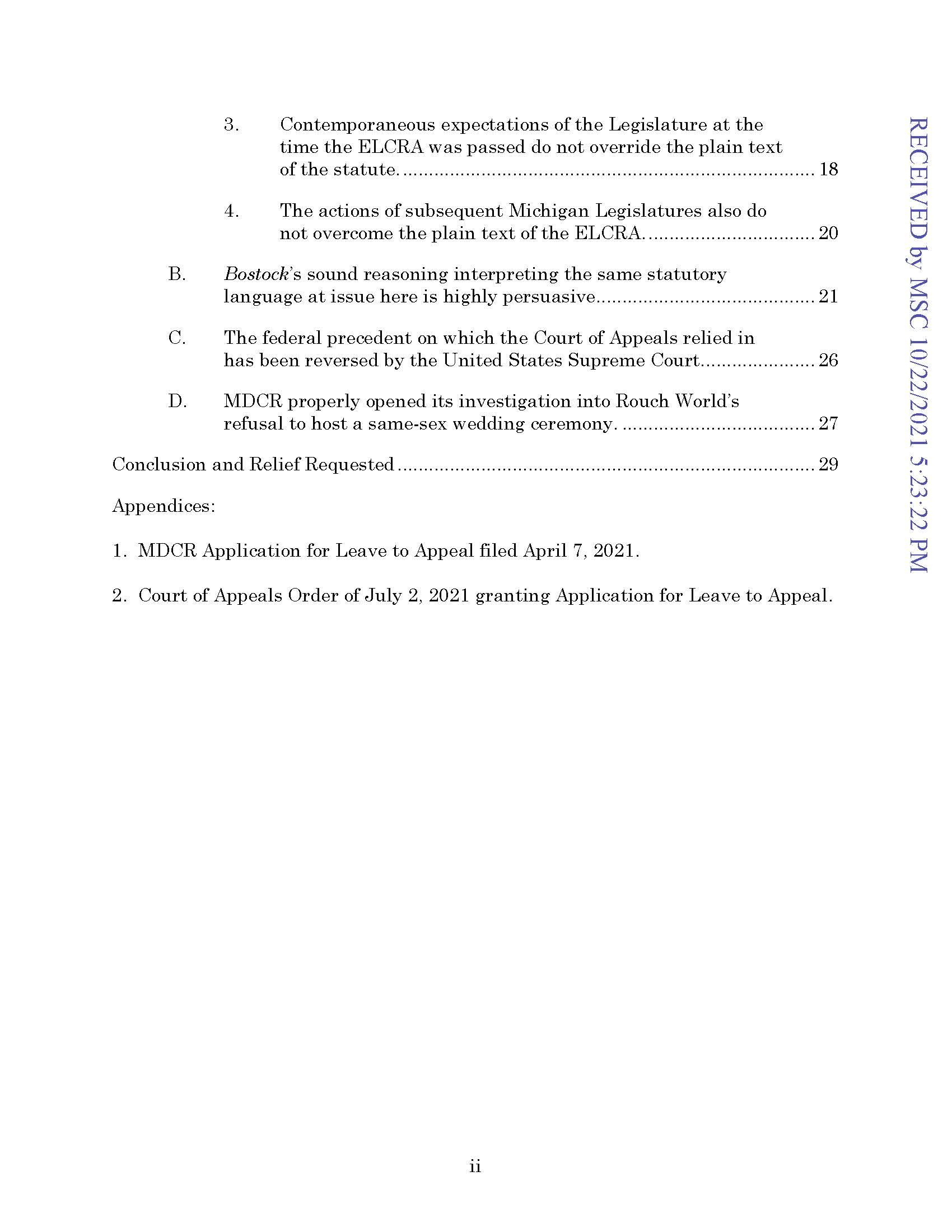
80 W.MICH. U. COOLEY LAW REVIEW [Vol. 38:1
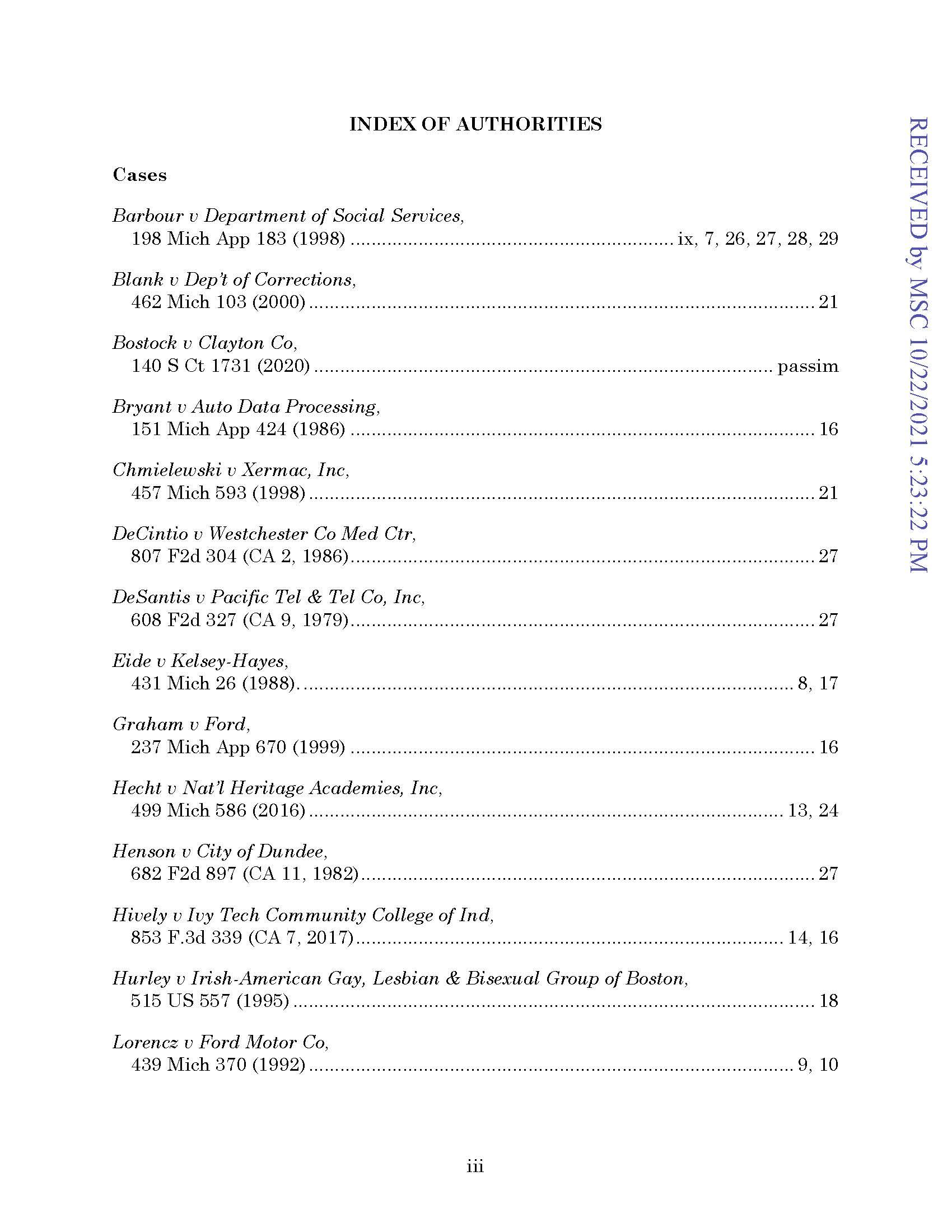
2023] DISTINGUISHED BRIEF 81
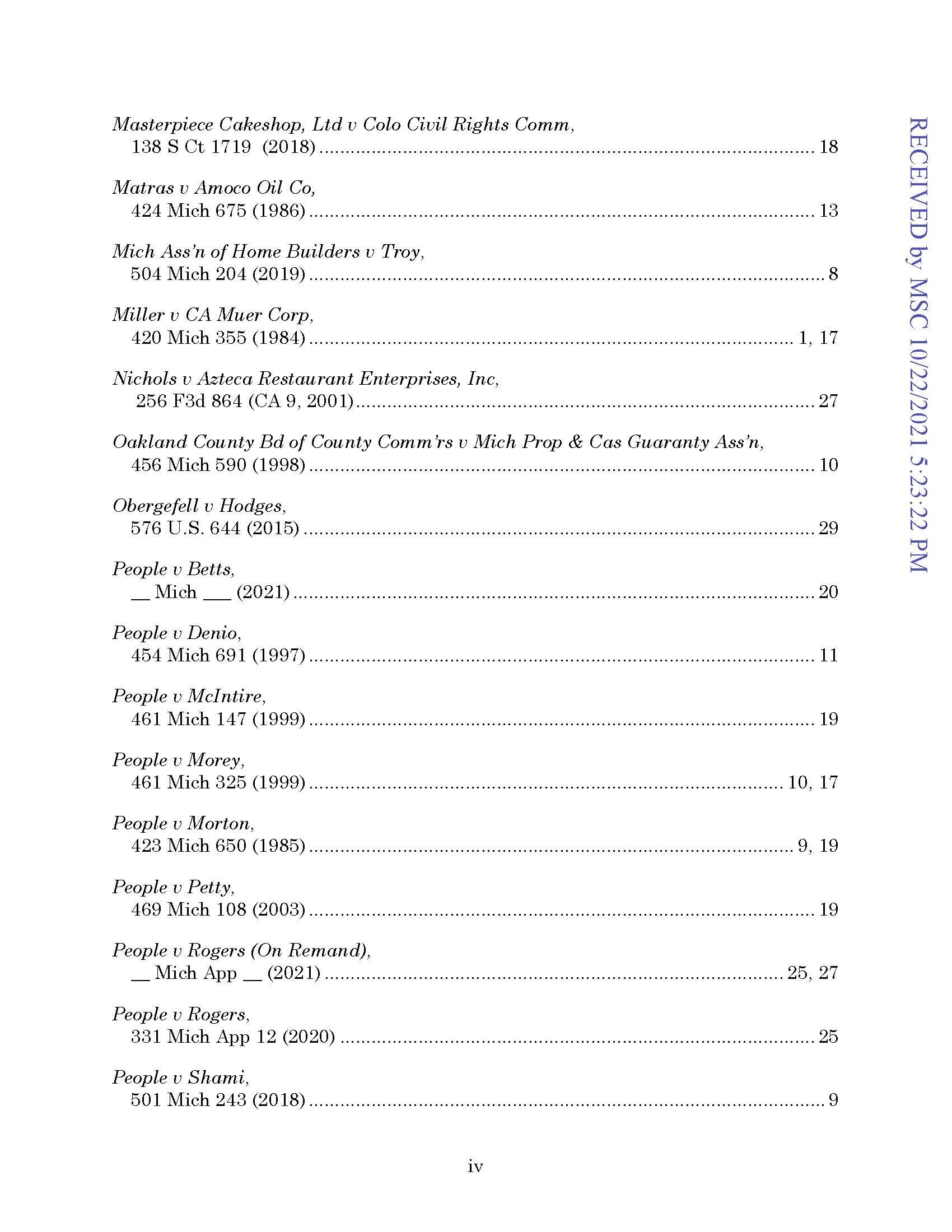
82 W. MICH. U. COOLEY LAW REVIEW [Vol. 38:1
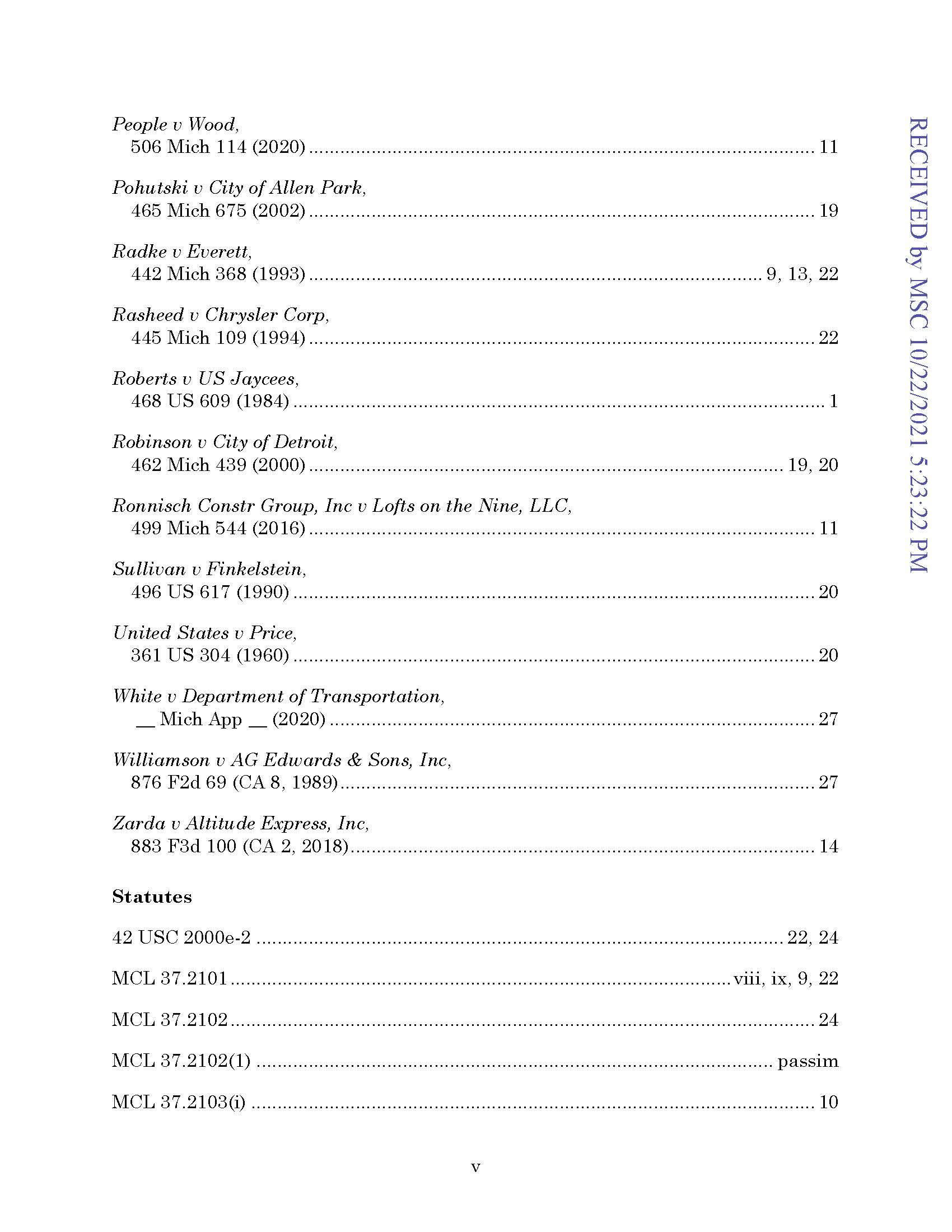
2023] DISTINGUISHED BRIEF 83
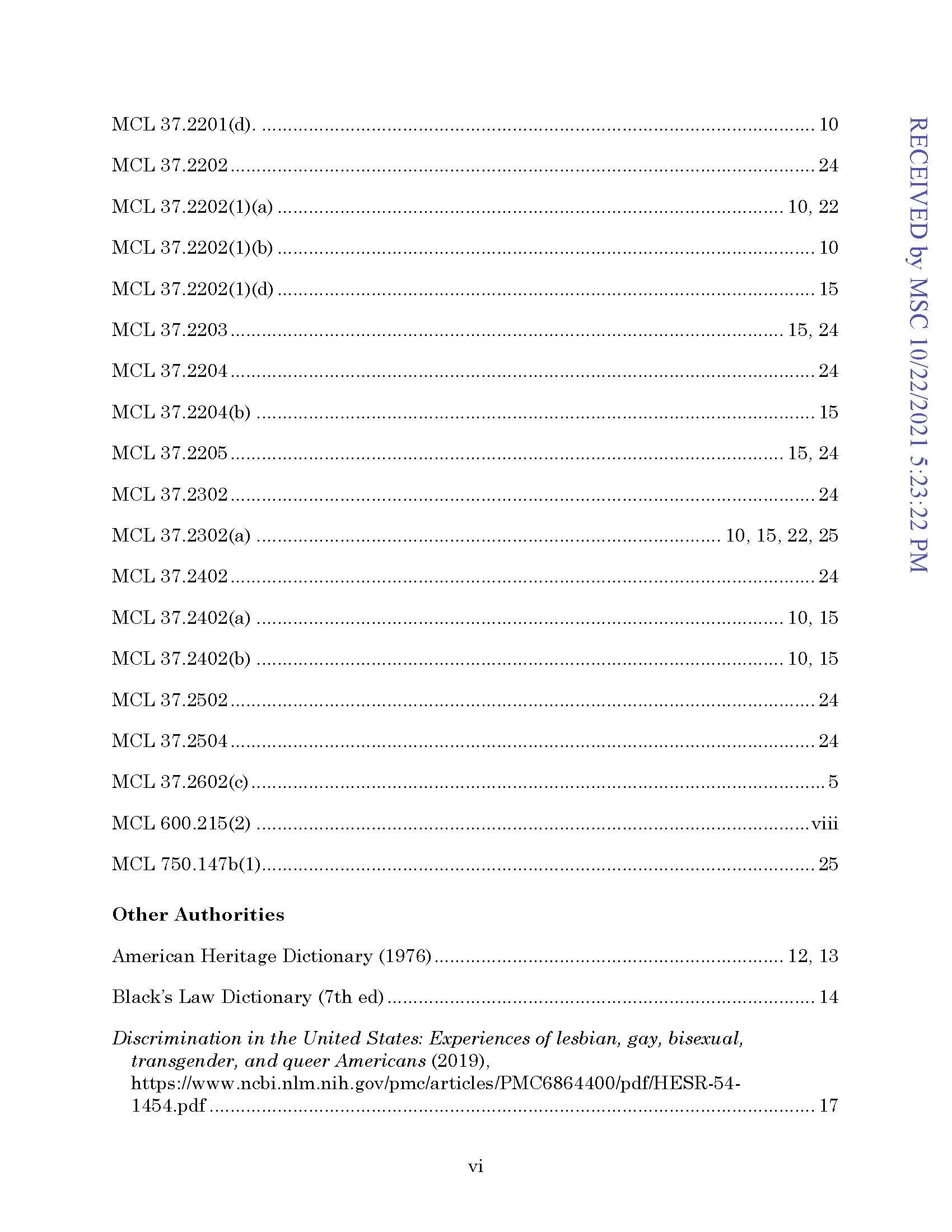
84 W. MICH. U. COOLEY LAW REVIEW [Vol. 38:1

2023] DISTINGUISHED BRIEF 85
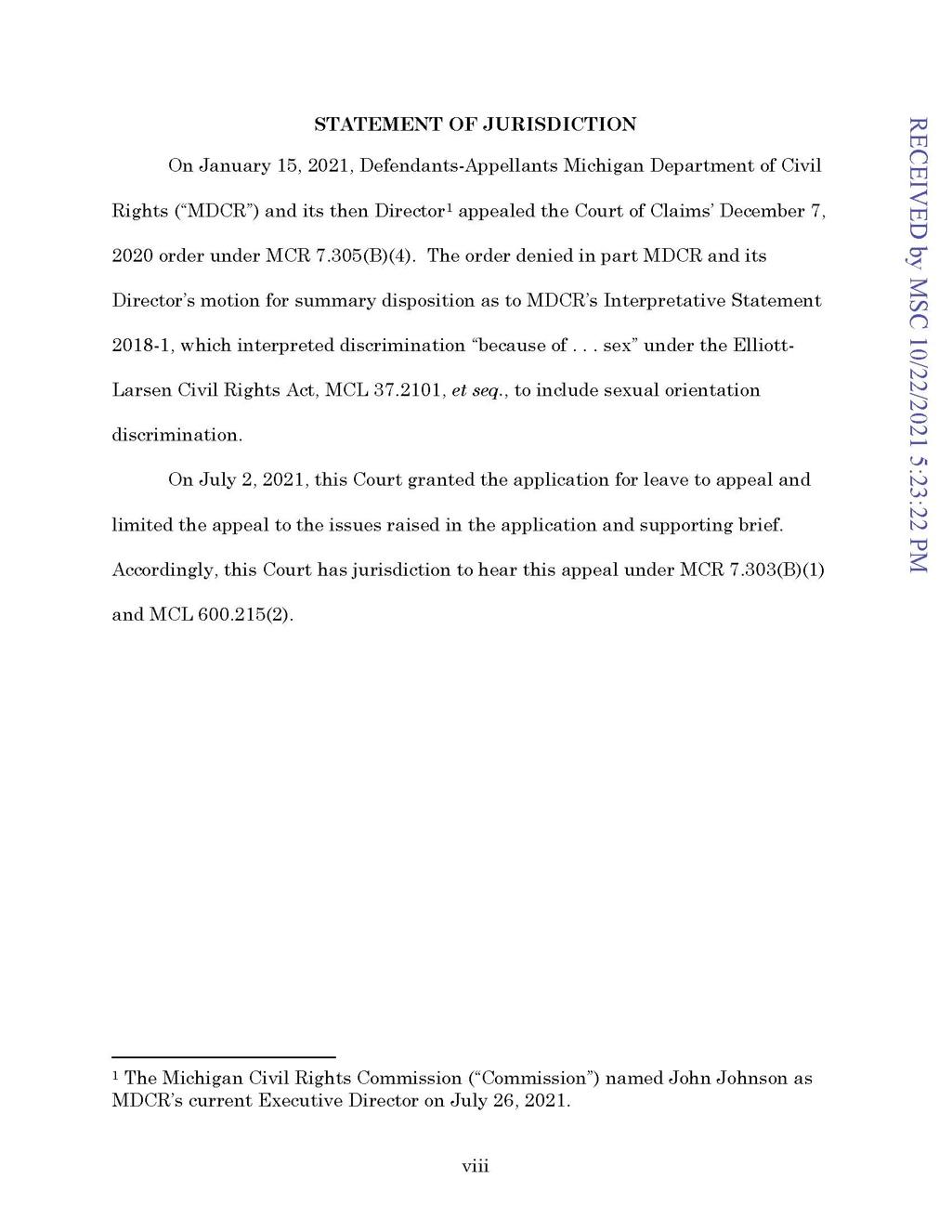
86 W. MICH. U. COOLEY LAW REVIEW [Vol. 38:1
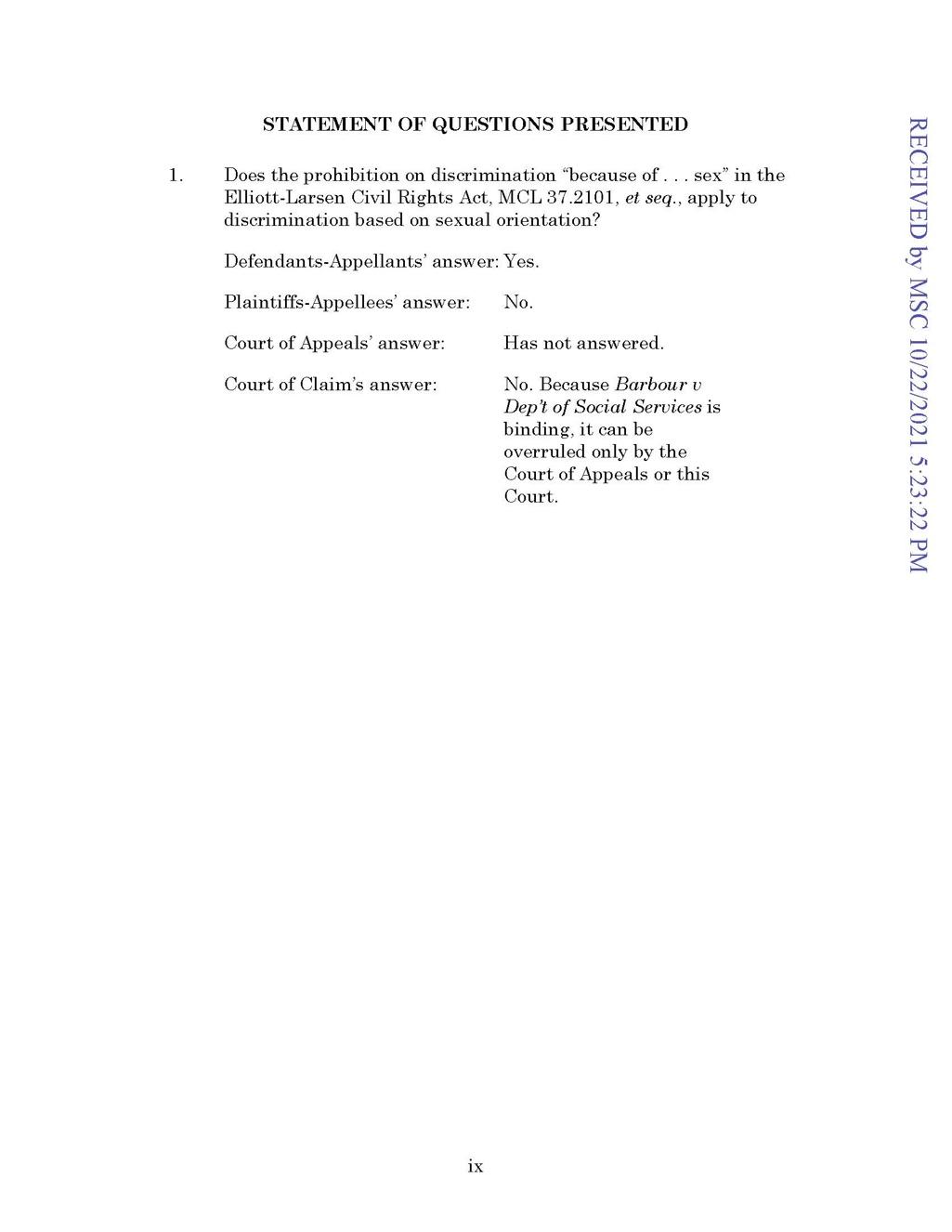
2023] DISTINGUISHED BRIEF 87
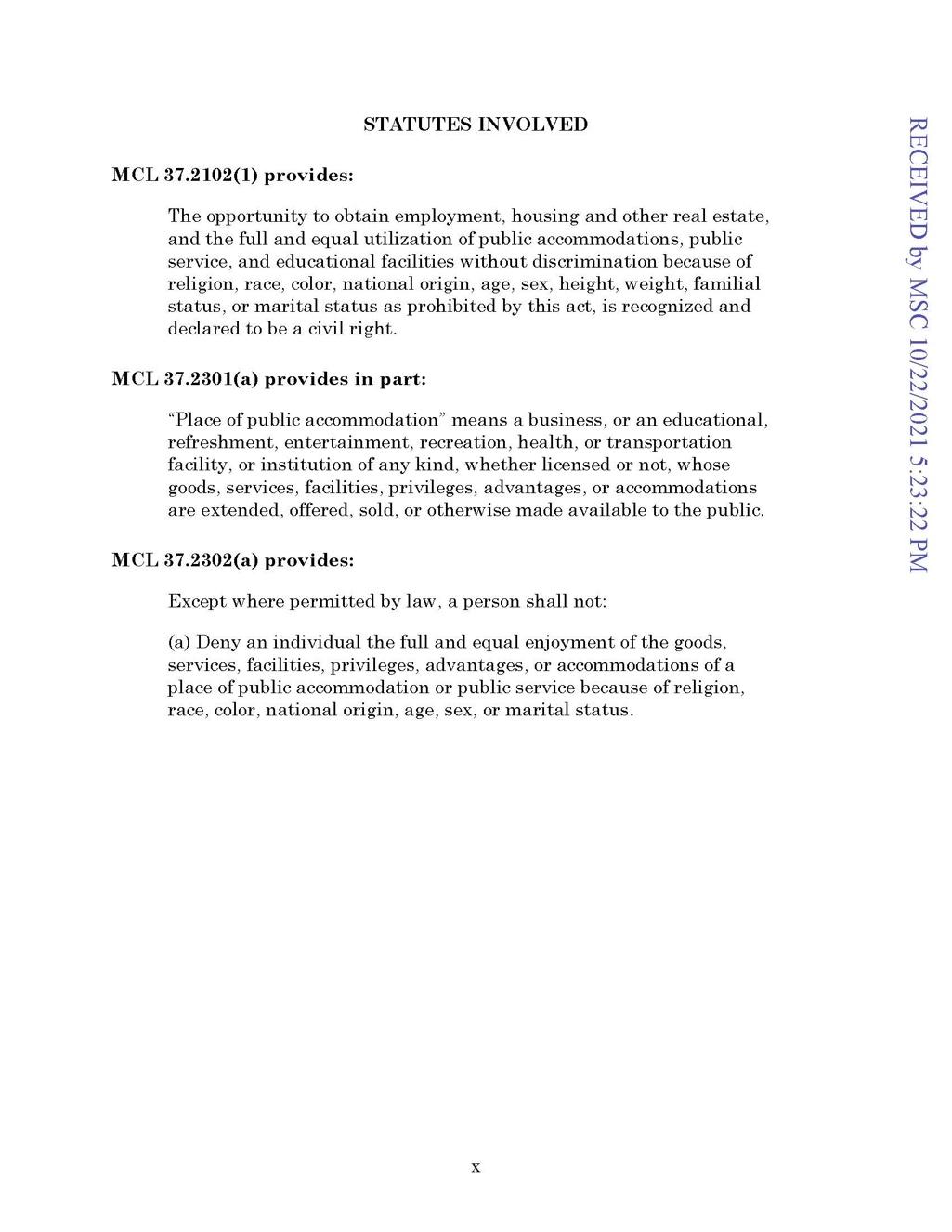
88 W. MICH. U. COOLEY LAW REVIEW [Vol. 38:1
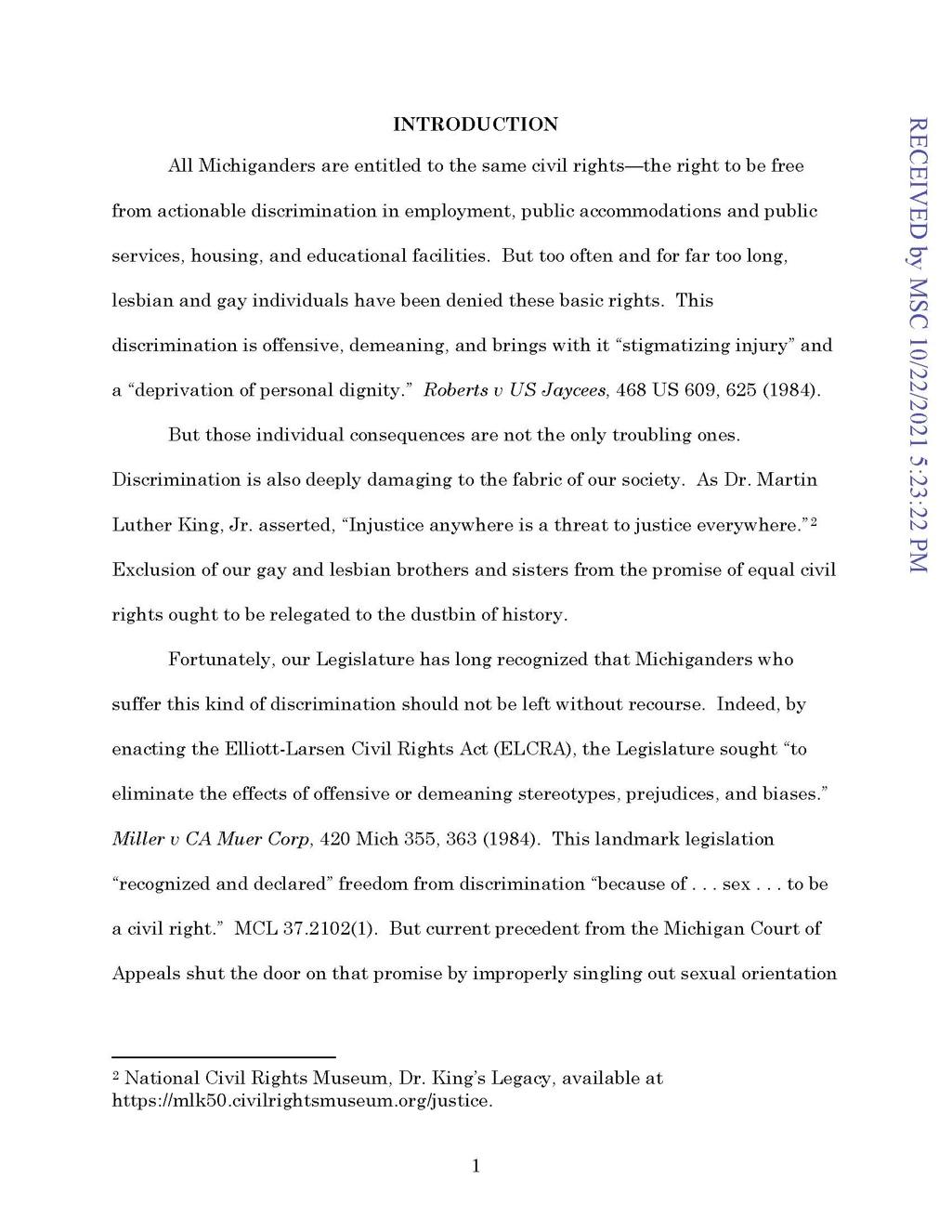
2023] DISTINGUISHED BRIEF 89

90 W. MICH. U. COOLEY LAW REVIEW [Vol. 38:1

2023] DISTINGUISHED BRIEF 91
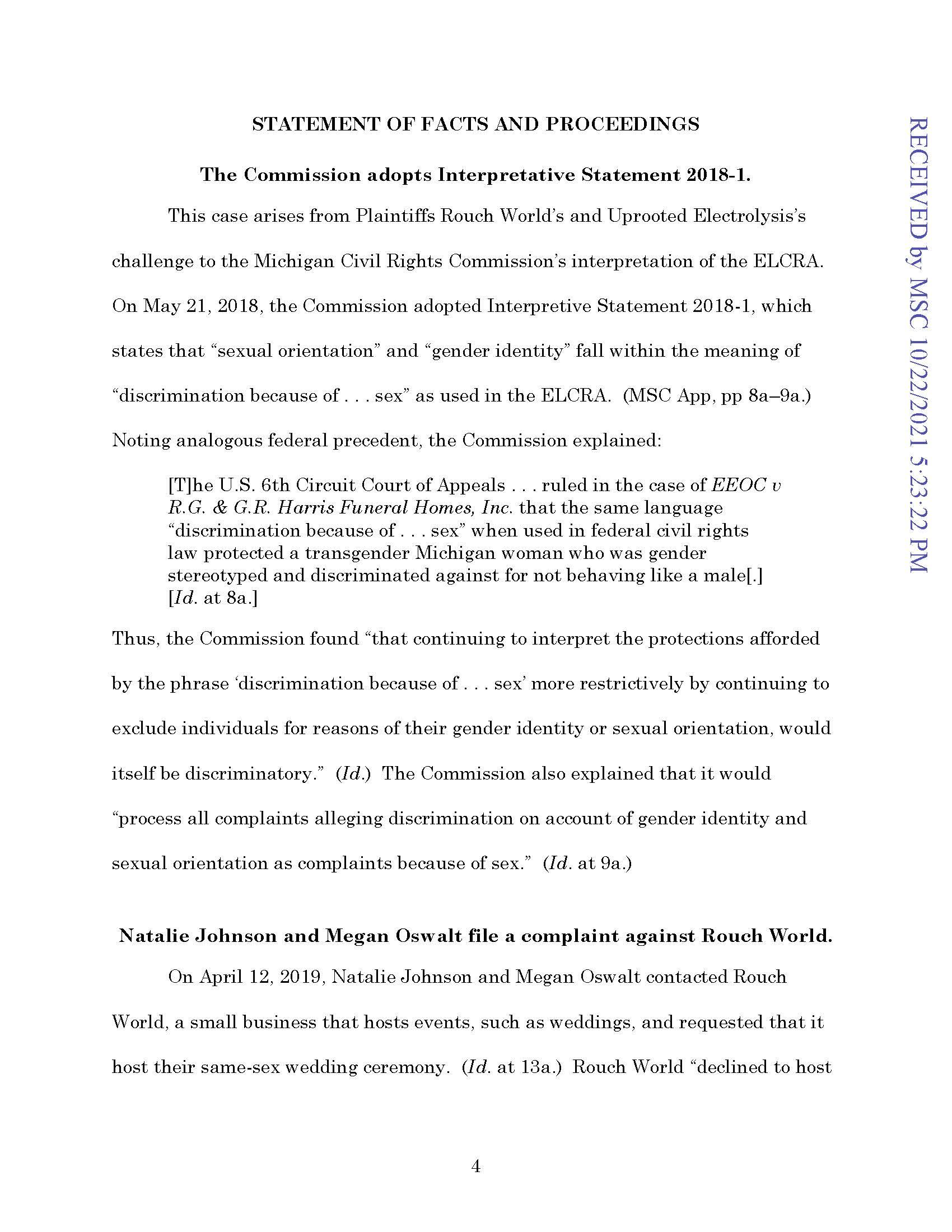
92 W. MICH. U. COOLEY LAW REVIEW [Vol. 38:1

2023] DISTINGUISHED BRIEF 93

94 W. MICH. U. COOLEY LAW REVIEW [Vol. 38:1
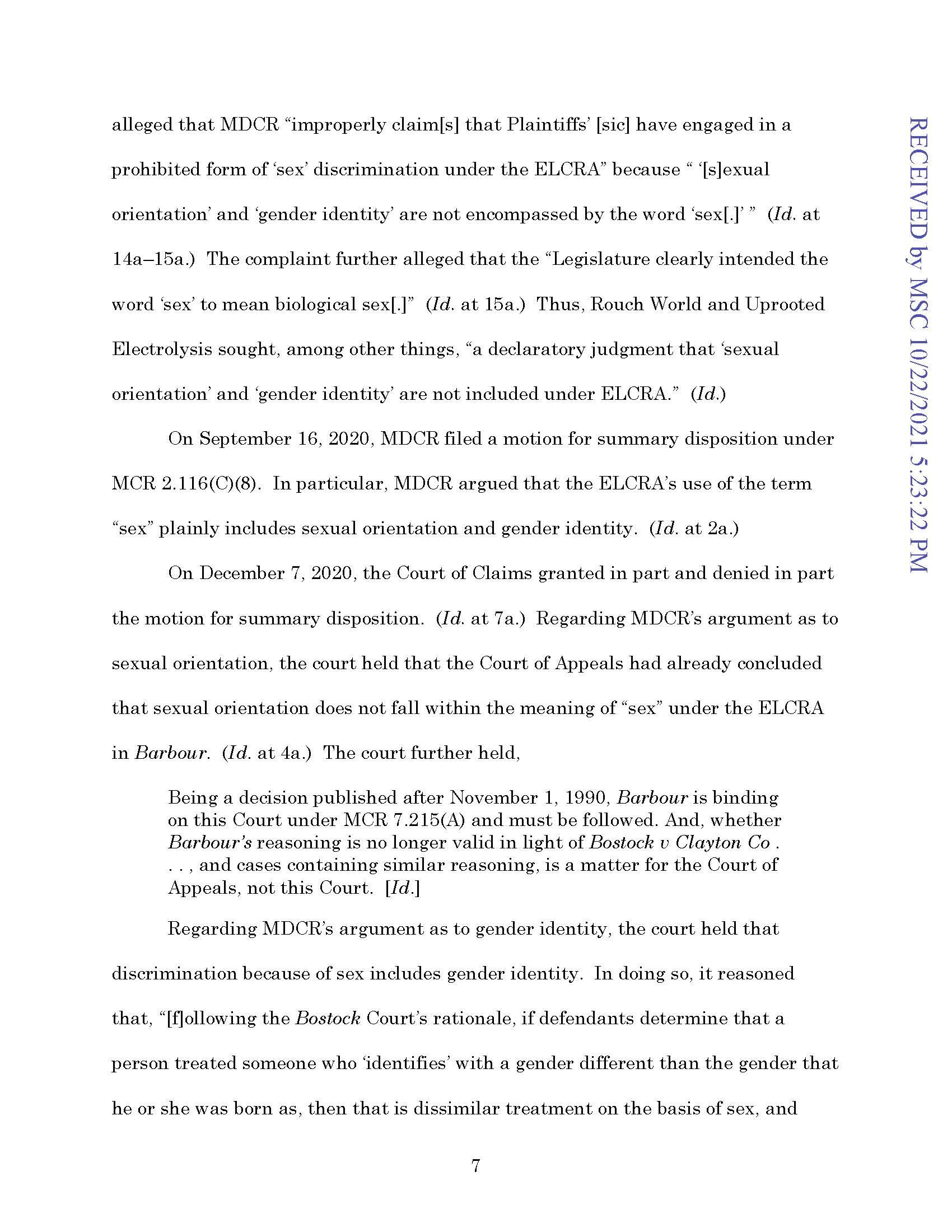
2023] DISTINGUISHED BRIEF 95

96 W. MICH. U. COOLEY LAW REVIEW [Vol. 38:1
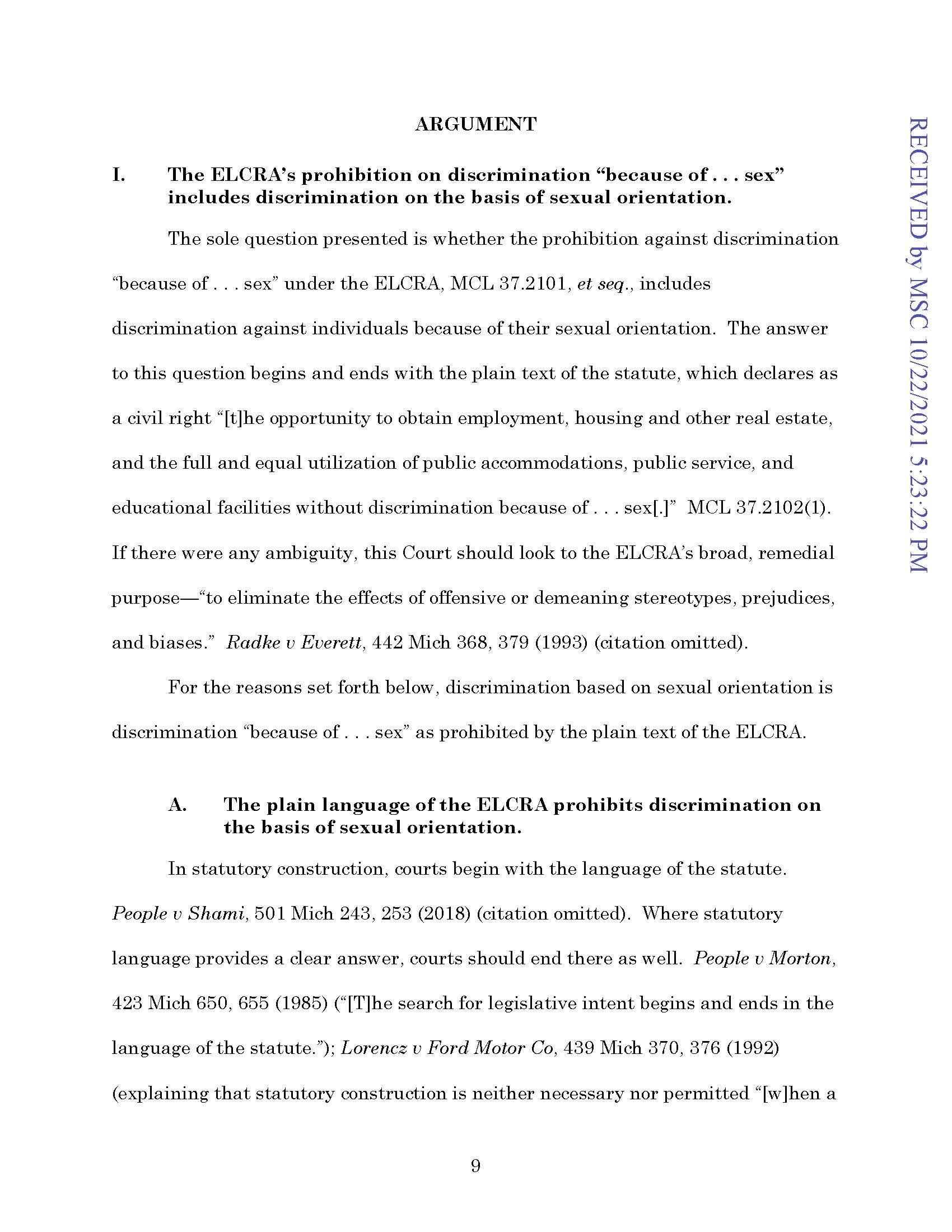
2023] DISTINGUISHED BRIEF 97

98 W. MICH. U. COOLEY LAW REVIEW [Vol. 38:1
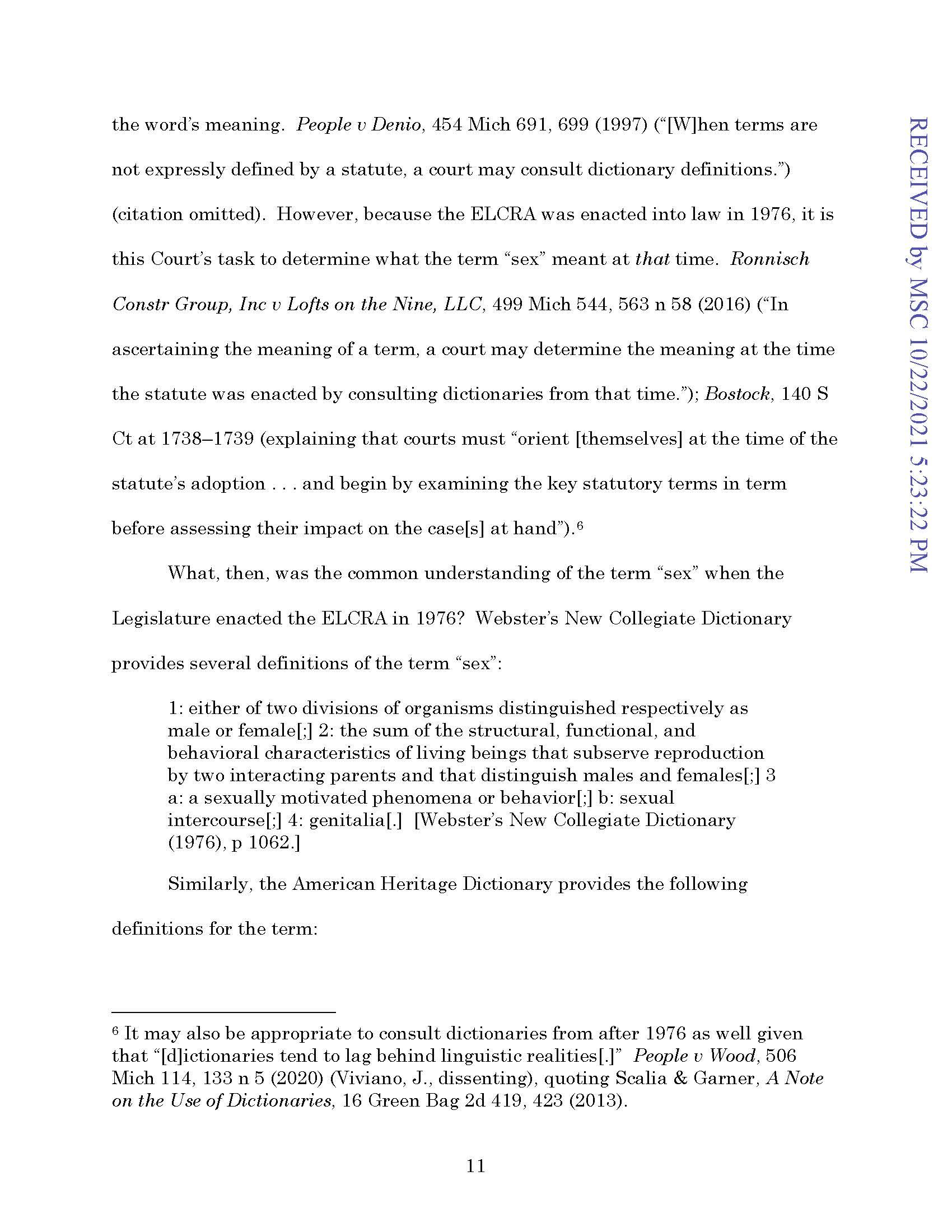
2023] DISTINGUISHED BRIEF 99
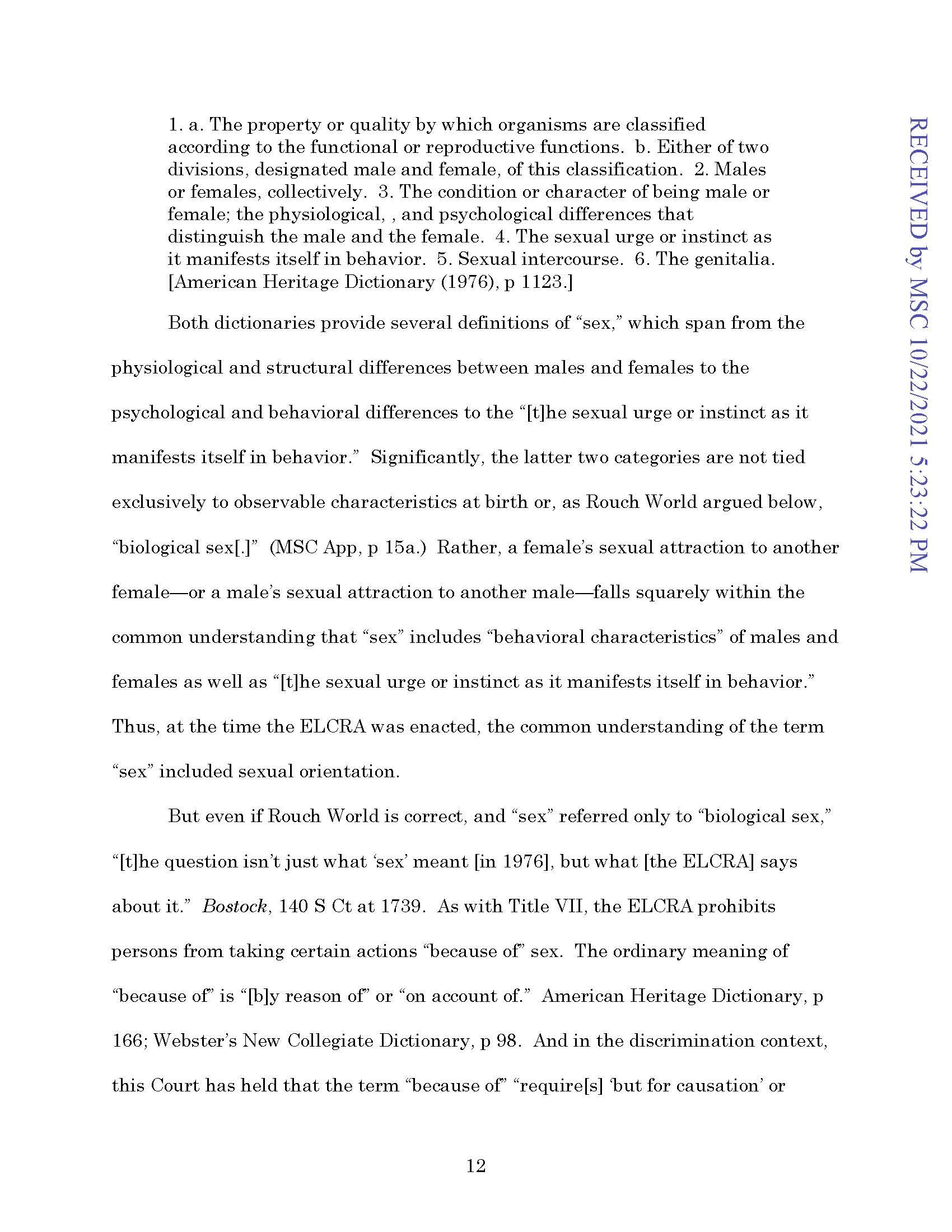
100 W. MICH. U. COOLEY LAW REVIEW [Vol. 38:1
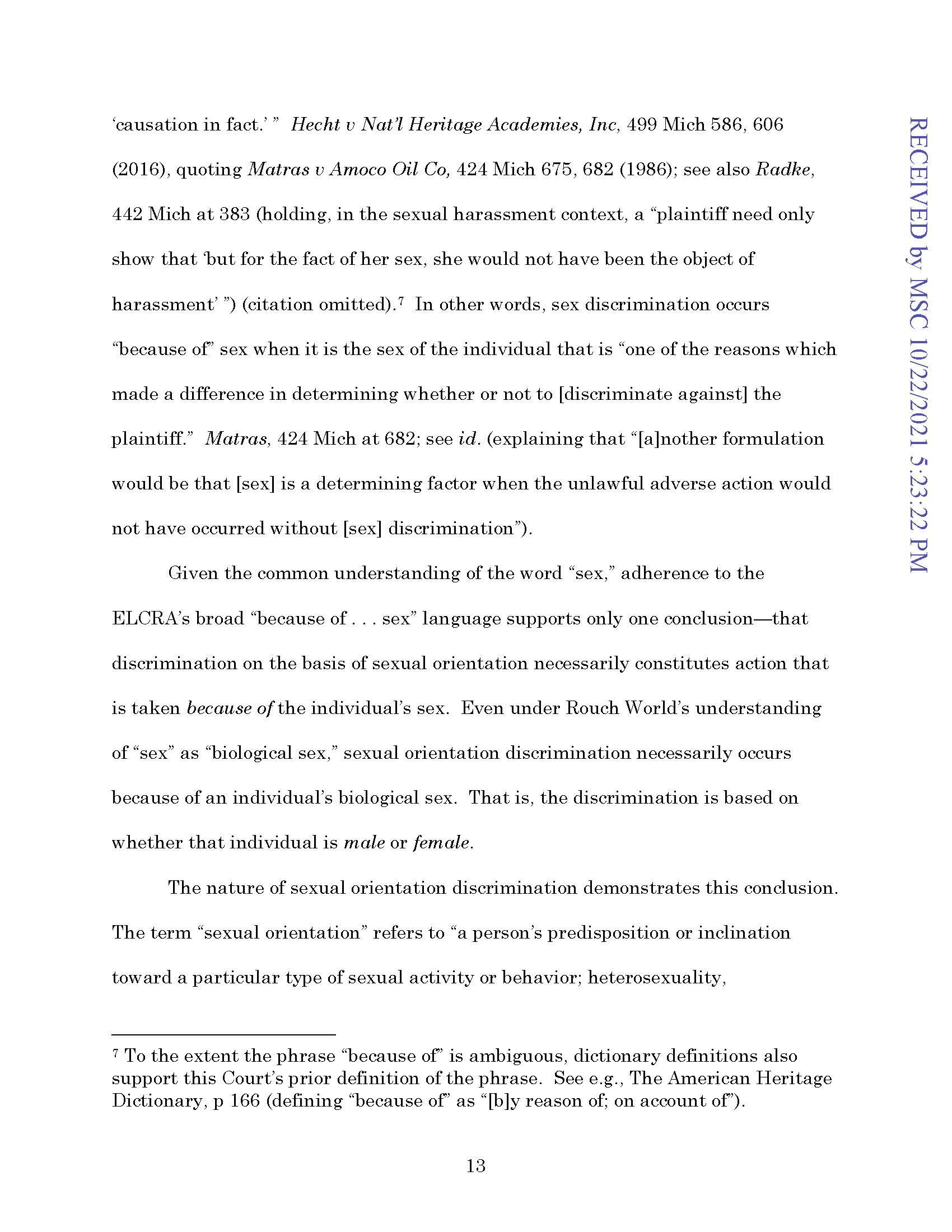
2023] DISTINGUISHED BRIEF 101

102 W. MICH. U. COOLEY LAW REVIEW [Vol. 38:1
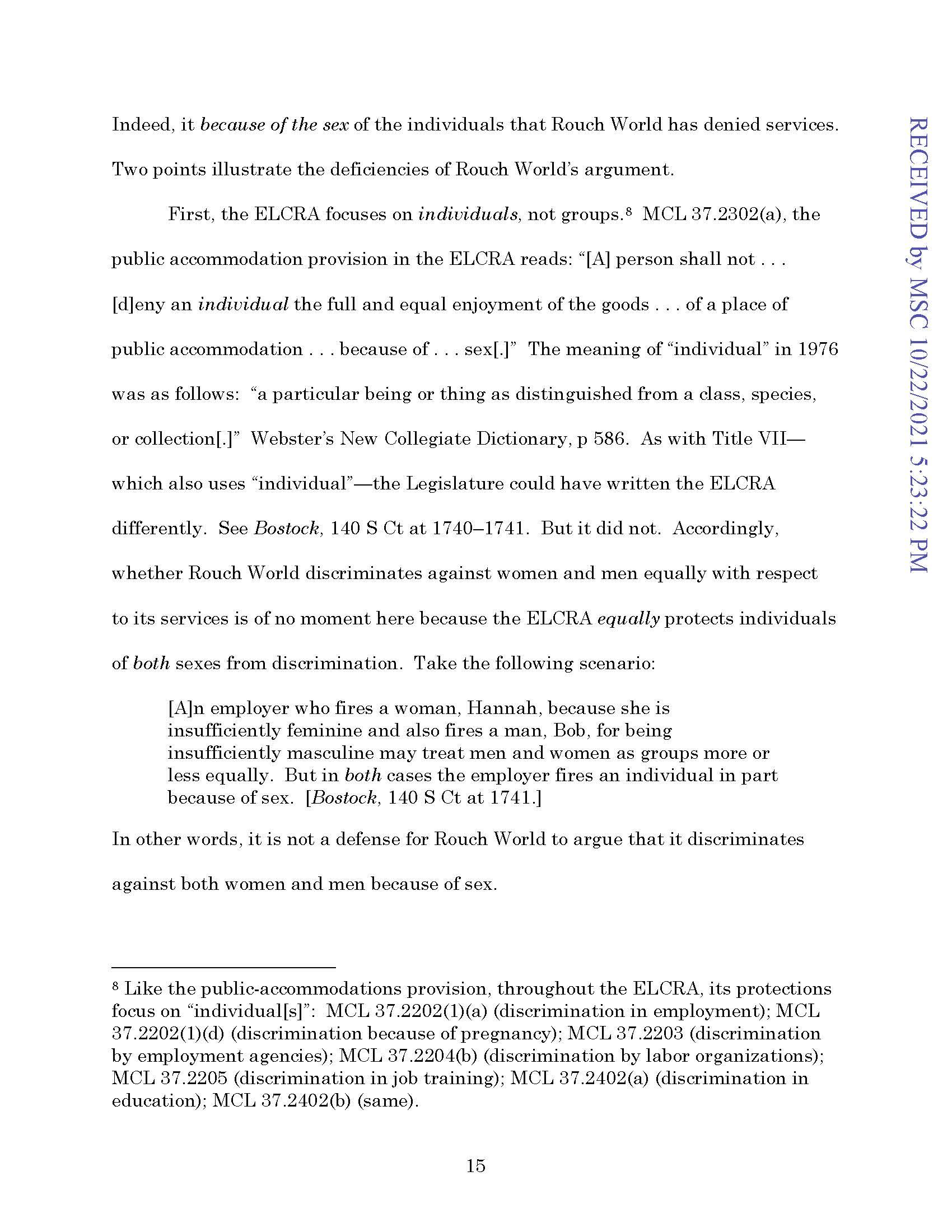
2023] DISTINGUISHED BRIEF 103
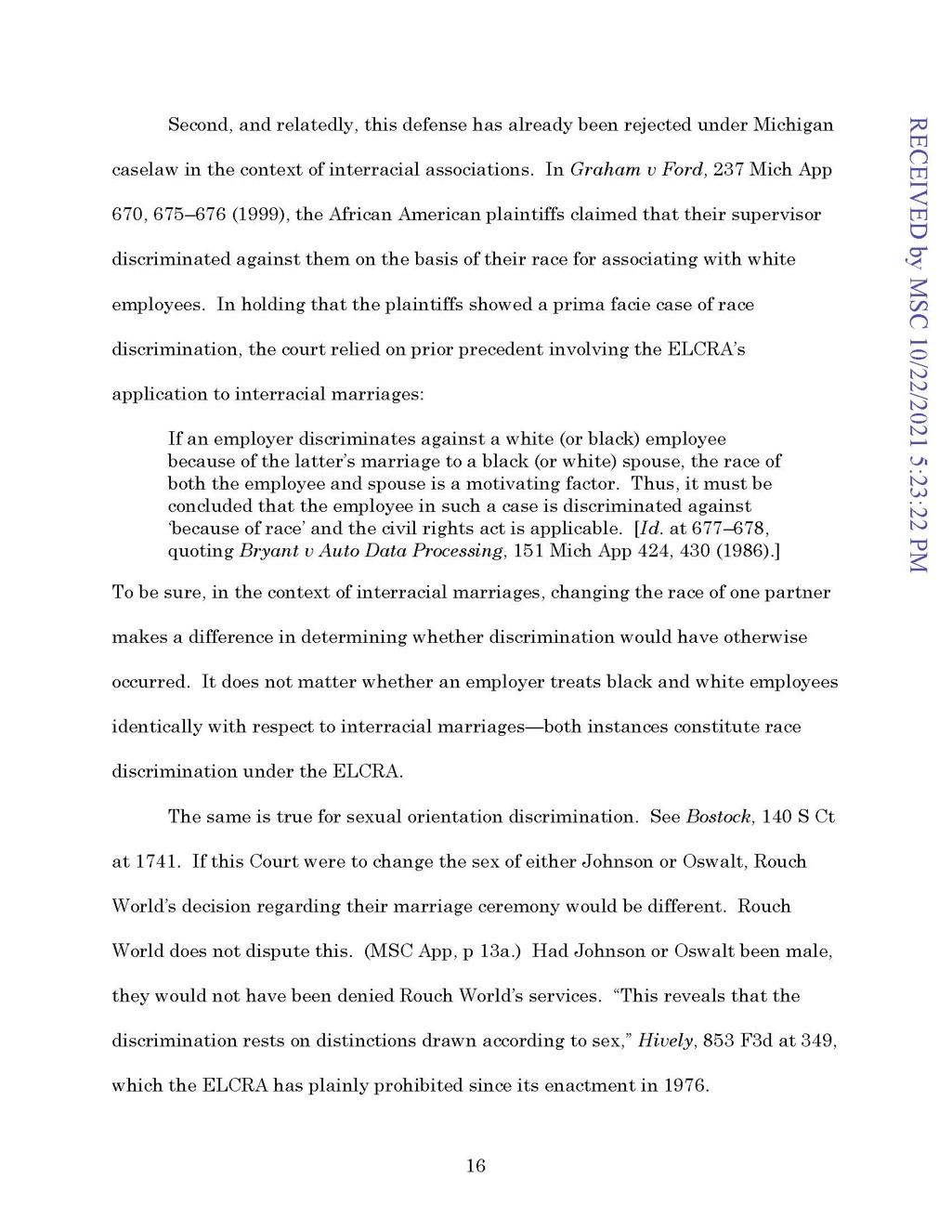
104 W. MICH. U. COOLEY LAW REVIEW [Vol. 38:1
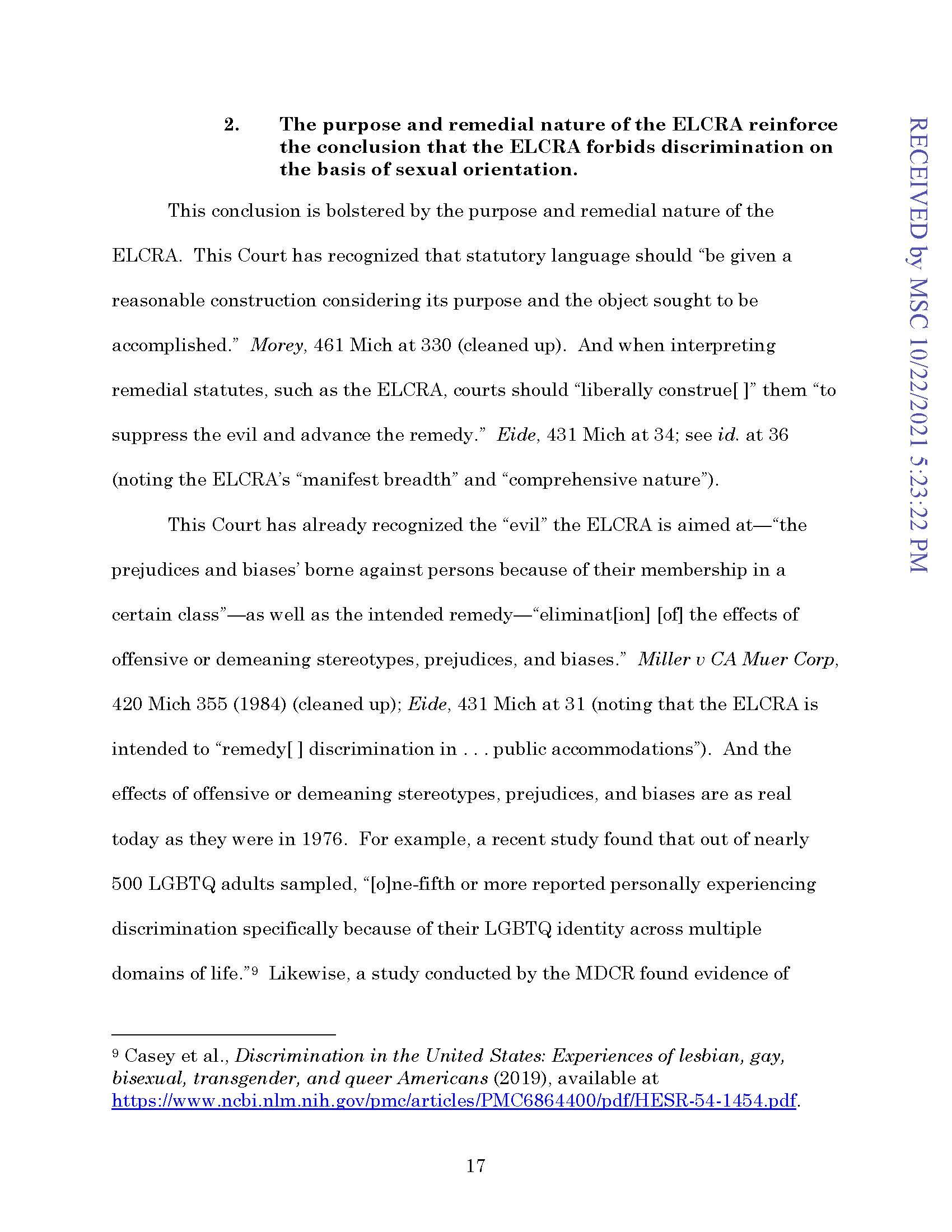
2023] DISTINGUISHED BRIEF 105
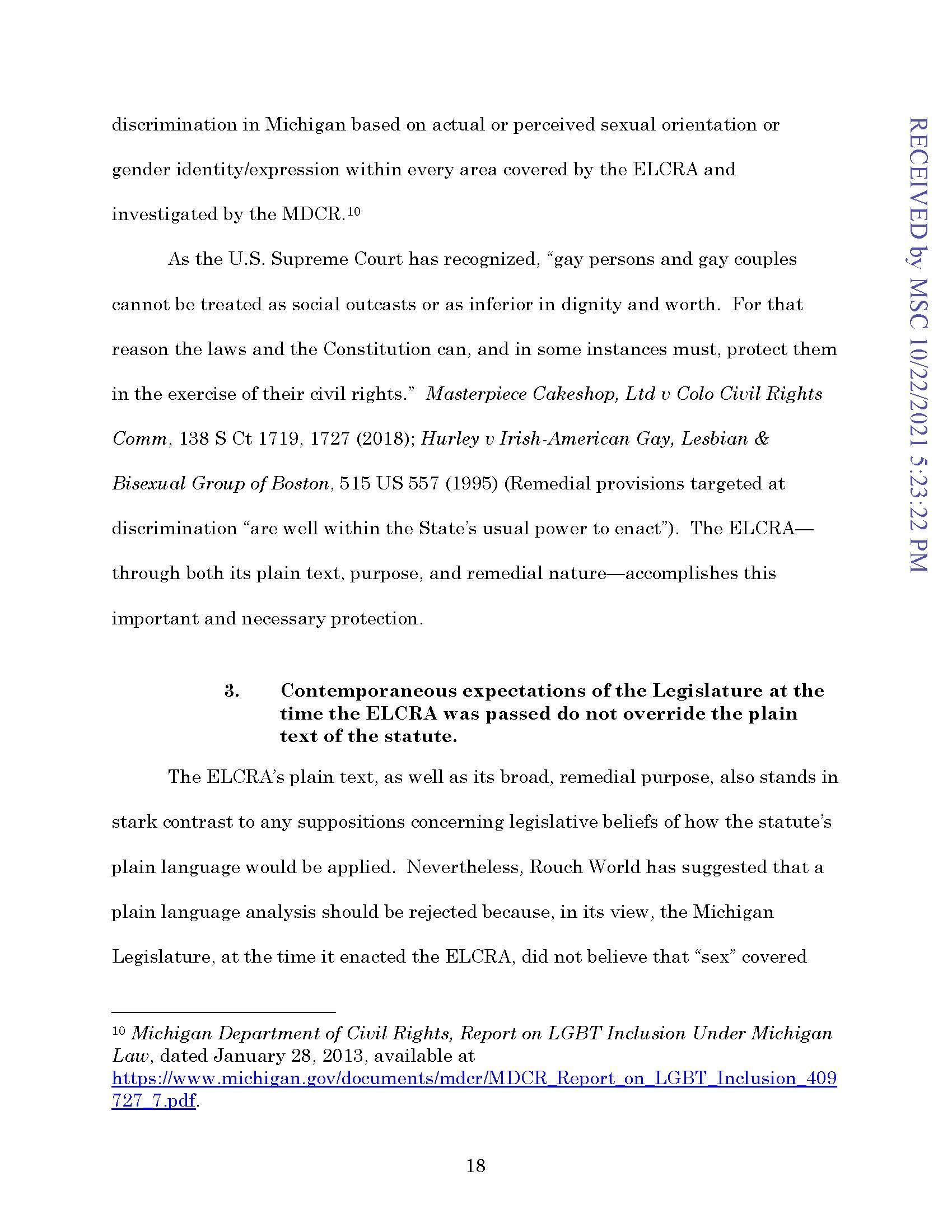
106 W. MICH. U. COOLEY LAW REVIEW [Vol. 38:1

2023] DISTINGUISHED BRIEF 107
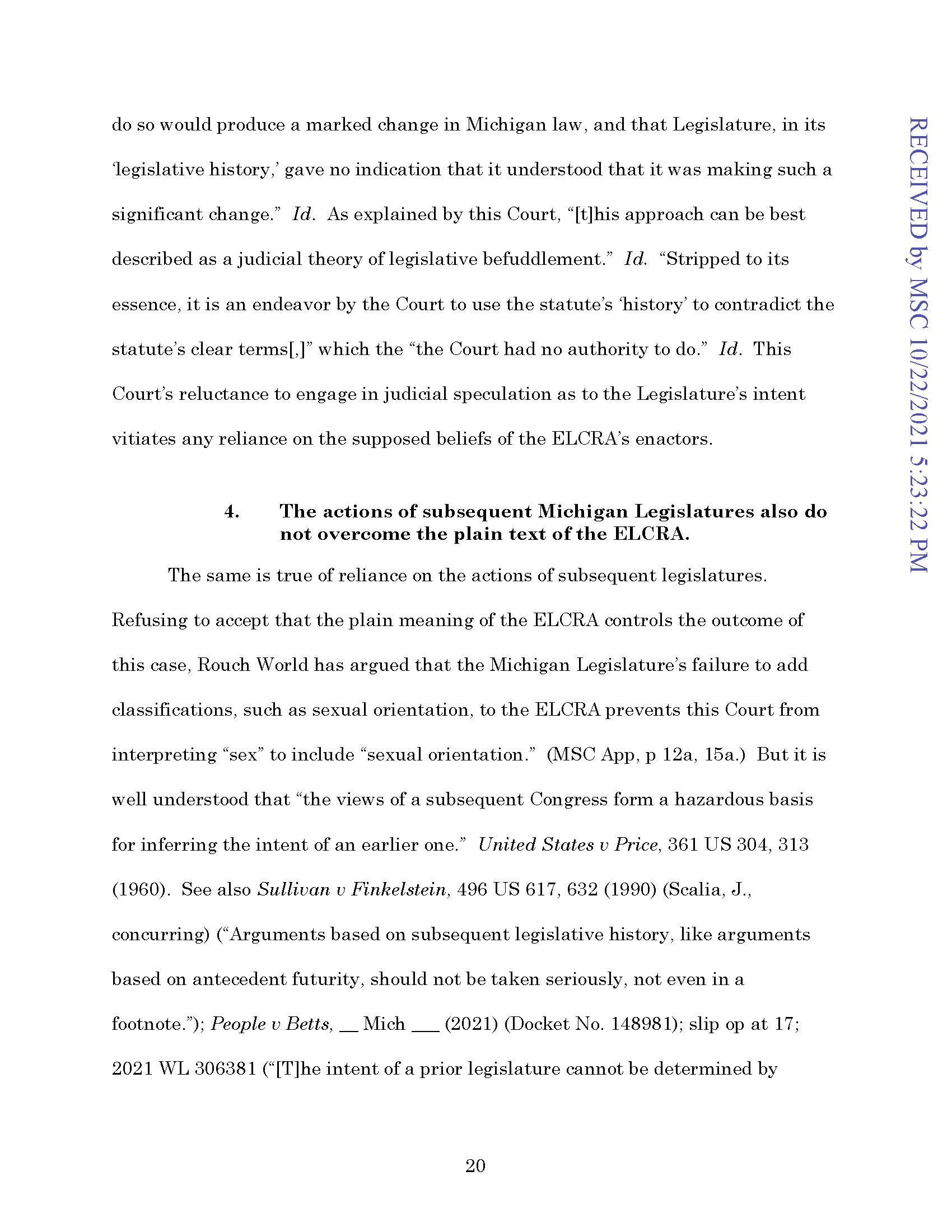
108 W. MICH. U. COOLEY LAW REVIEW [Vol. 38:1

2023] DISTINGUISHED BRIEF 109

110 W. MICH. U. COOLEY LAW REVIEW [Vol. 38:1
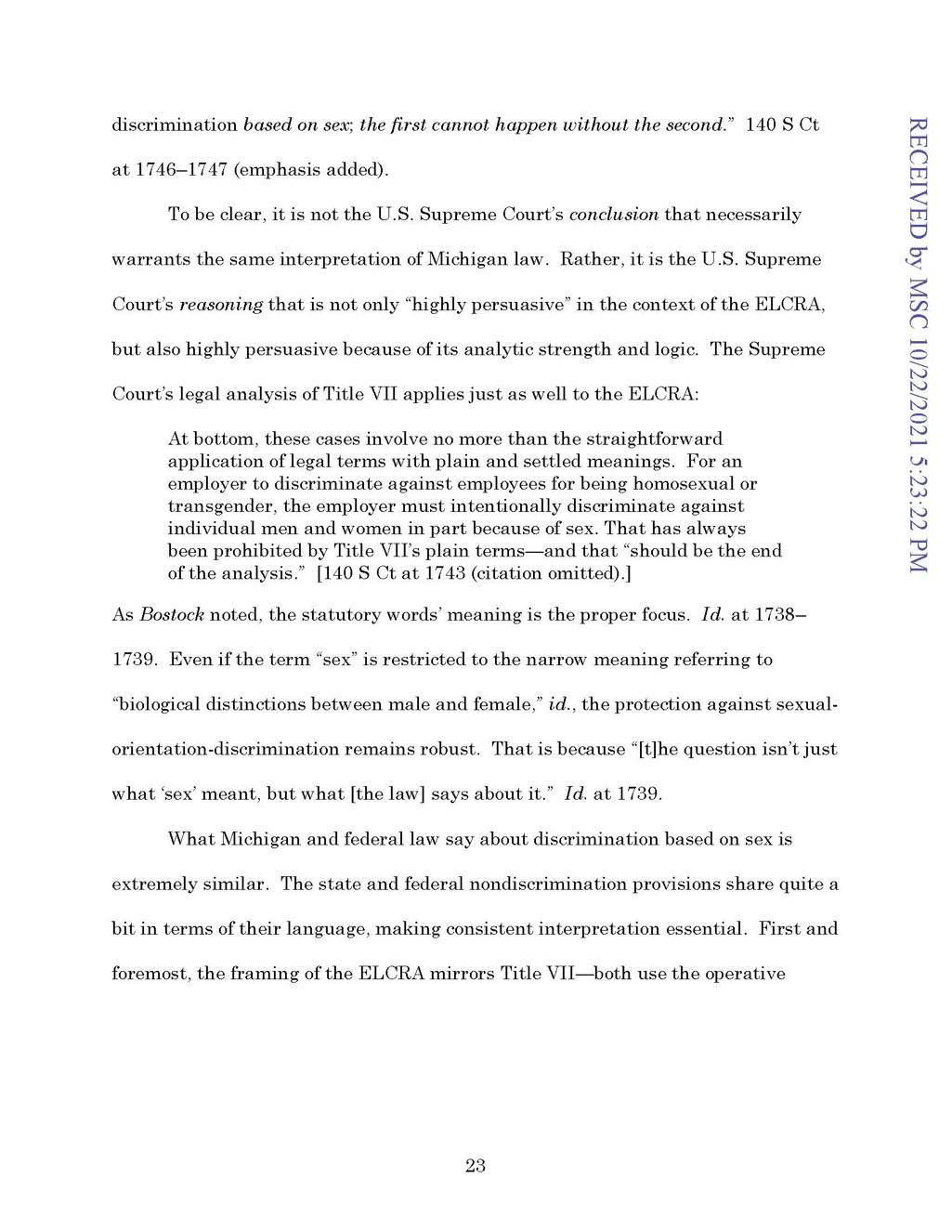
2023] DISTINGUISHED BRIEF 111

112 W. MICH. U. COOLEY LAW REVIEW [Vol. 38:1
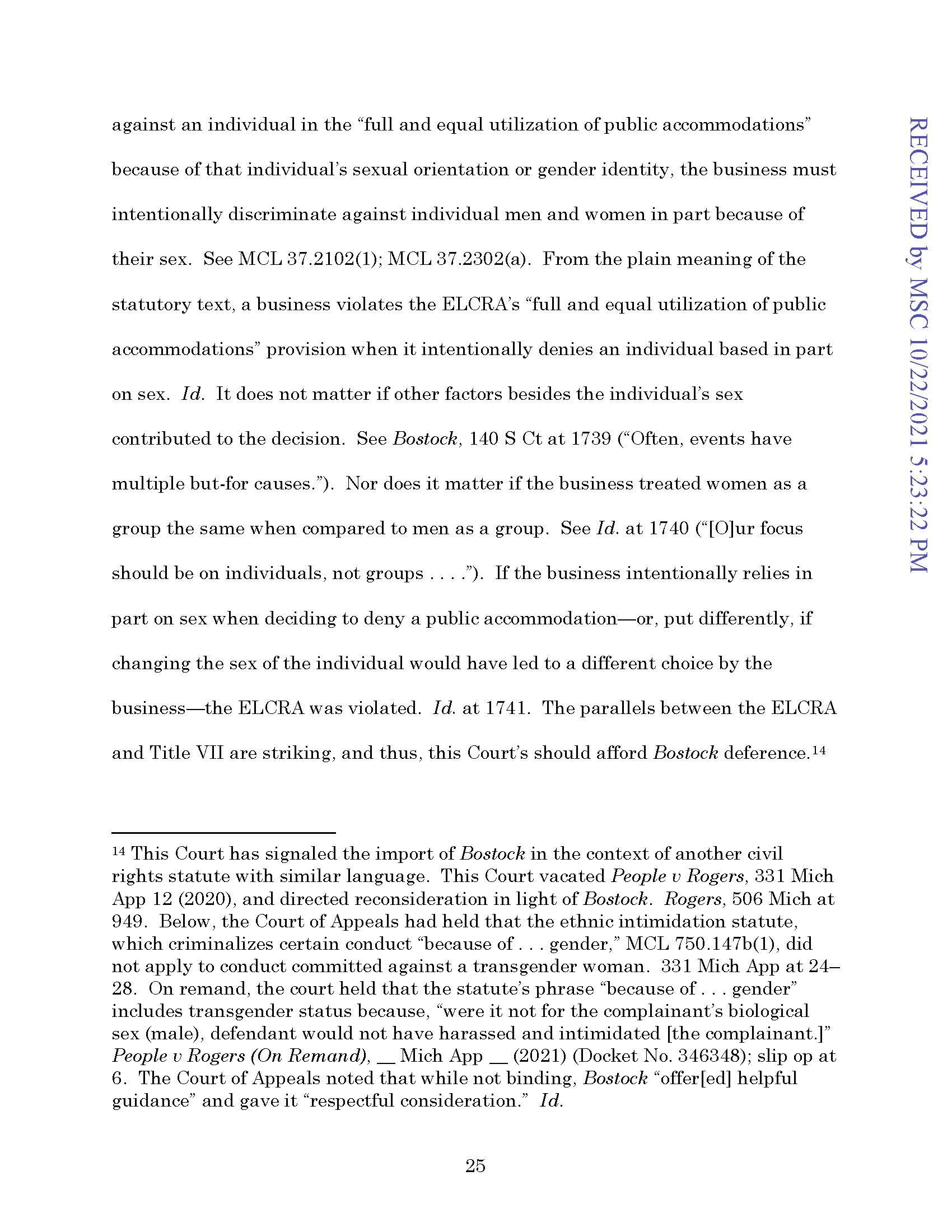
2023] DISTINGUISHED BRIEF 113

114 W. MICH. U. COOLEY LAW REVIEW [Vol. 38:1
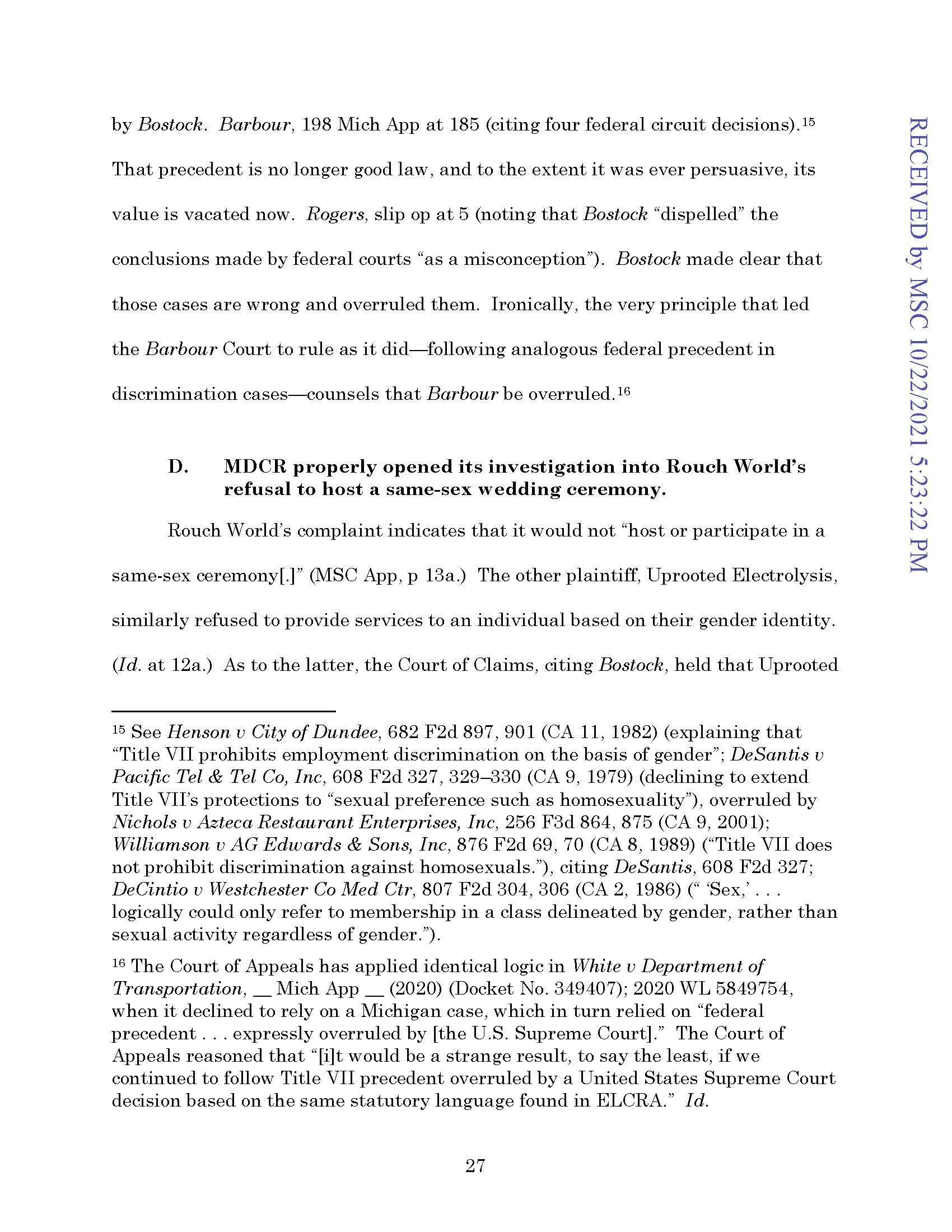
2023] DISTINGUISHED BRIEF 115

116 W. MICH. U. COOLEY LAW REVIEW [Vol. 38:1

2023] DISTINGUISHED BRIEF 117

118 W. MICH. U. COOLEY LAW REVIEW [Vol. 38:1
PEOPLE OF THE STATE OF MICHIGAN, Plaintiffs-Appellees, v.
ROBERT LANCE PROPP, Defendants-Appellants.
ABSTRACT
On July 6, 2016, emergency responders found Melissa Thornton dead in her own bed. Ms. Thornton was Robert Propp's ex-girlfriend and the mother of his child. Although the relationship between defendant and Thornton had been turbulent, Mr. Propp had spent the night with Ms. Thornton. At roughly 3:00 A.M., the two were involved in a physical altercation that resulted in a piece of furniture tipping over and trapping Mr. Poole on top of Ms. Thornton. Mr. Poole pressed down with the weight of his body when he lifted the dresser and himself up. Before leaving, he then carried Ms. Thornton to her bed and claims he was not aware that she was not breathing. The following morning, at 10:00 A.M., Mr. Poole returned to the residence to find Ms. Thornton unconscious. He immediately phoned 9-1-1 and proceeded to perform chest compressions. The autopsy report attributed Thornton's death to neck compression.
On the theory that Ms. Thornton's death was accidental, Defendant moved for funds to retain an expert. The trial court found that the facts on the record did not support the theory and denied the motion. Prosecution then moved to introduce evidence of Defendant's other acts of domestic violence: (1) statements that Thornton had made to friends and family concerning her relationship with defendant, and (2) testimony by defendant's ex-wife about abuse she had endured during their marriage. Defendant objected to the admission of these prior acts and argued that this evidence is inadmissible hearsay and more prejudicial than probative. The trial court denied Defendant’s motion and admitted the evidence in its
entirety. Following a jury trial, Defendant was convicted of firstdegree premeditated murder.
After the Court of Appeals affirmed his conviction, Defendant was granted leave to appeal to the Michigan Supreme Court to address: (1) whether the Court of Appeals correctly affirmed the trial court's decision to deny the Defendant's motion for expert funding; and (2) whether the Court of Appeals correctly held that evidence of other acts of domestic violence is admissible regardless of whether it might be otherwise inadmissible under the hearsay rules of evidence. Defendant argued that the Court of Appeals erred in characterizing Mr. Propp’s defense as an affirmative defense, thus rendering the basis for its ruling inapplicable. The defense of accident was not an affirmative defense because defendant did not bear the burden of negating intent. Therefore, the Court of Appeals failed to apply the correct standard, and the Michigan Supreme Court vacated the Court of Appeals’ analysis on this issue.
With regard to the evidence of other acts of domestic violence, Defendant argued that the Court of Appeals erred in its interpretation of MCL 768.27b because MCL 768.27b does not limit or preclude the consideration of MRE 802, which states that hearsay is generally not admissible. The Michigan Supreme Court agreed and reversed and remanded the Court of Appeals’ holding on this issue.
BIOGRAPHICAL STATEMENT
Steven Helton graduated magna cum laude from Wayne State University Law School in 2013. While in Law School, Helton was able to refine his legal writing skills by interning for Judge Marian Blank Horn at the United States Court of Federal Claims and for Chief Judge Gerald Rosen at the United States District Court for the Eastern District of Michigan. He also served on the Executive Board of The Wayne Law Review where he was able to participate in the publication of scholarly articles.
In 2018, Helton joined the State Appellate Defender Office and has since been awarded the 2022 Norris Thomas Award for Excellence in Appellate Advocacy. He also shares his expertise by training defense attorneys throughout the state. Steven Helton’s legal research, writing, and advocacy skills make him the an ideal candidate for handling some of the most complex Michigan Supreme Court cases. Having him at the forefront of up-and-coming legal issues is an advantage to the entire legal community.
120 W. MICH. U. COOLEY LAW REVIEW [Vol. 38:1

2023] DISTINGUISHED BRIEF 121
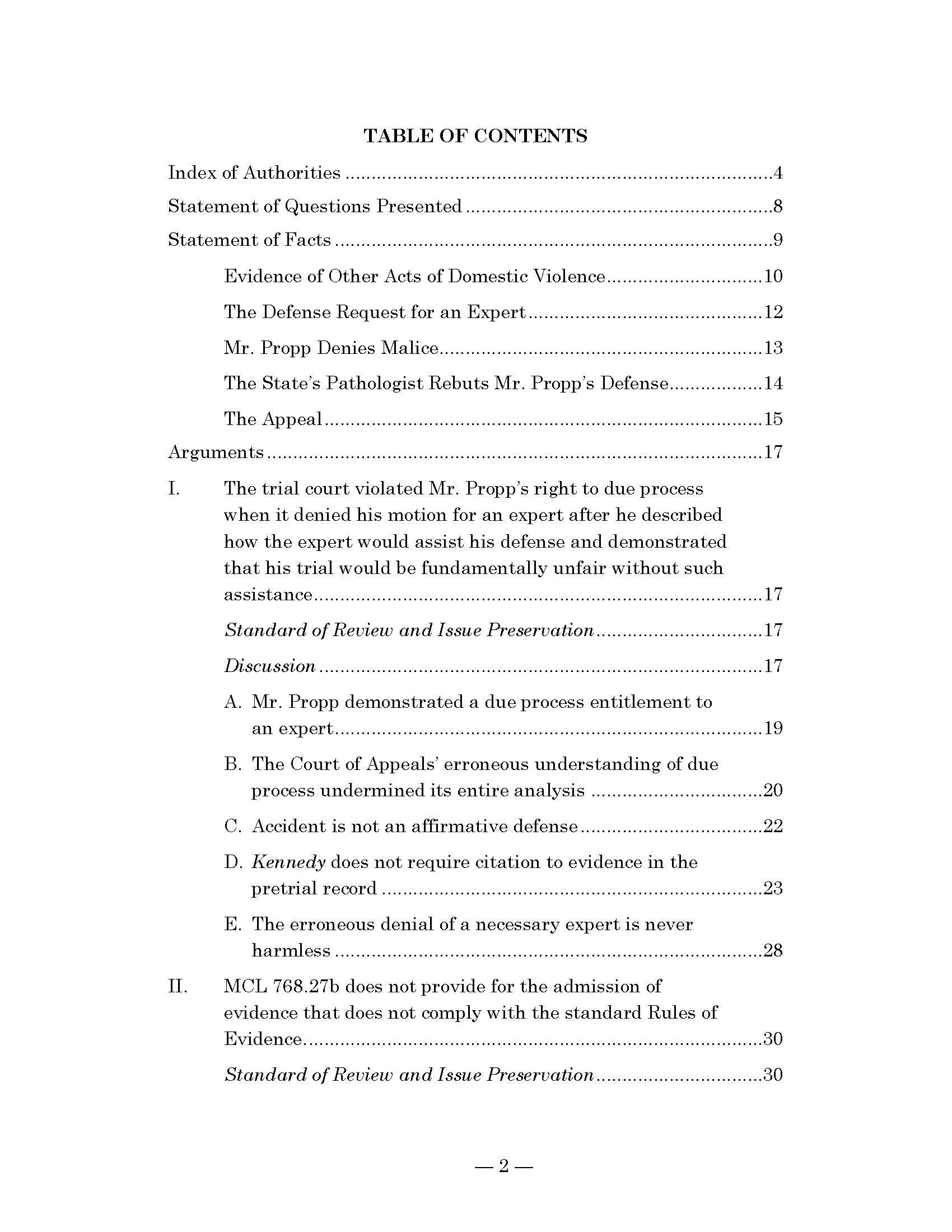
122 W. MICH. U. COOLEY LAW REVIEW [Vol. 38:1

2023] DISTINGUISHED BRIEF 123
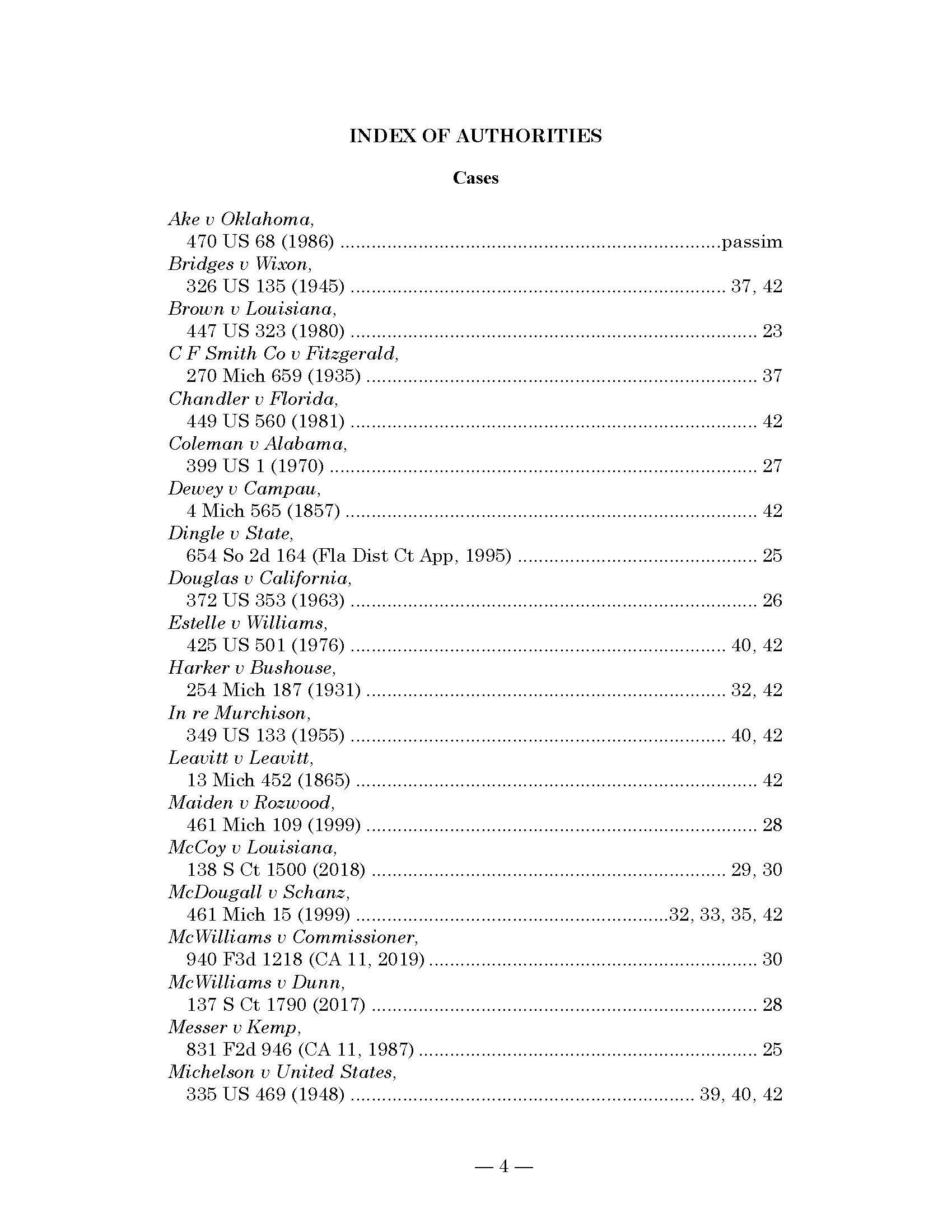

124 W. MICH. U. COOLEY LAW REVIEW [Vol. 38:1

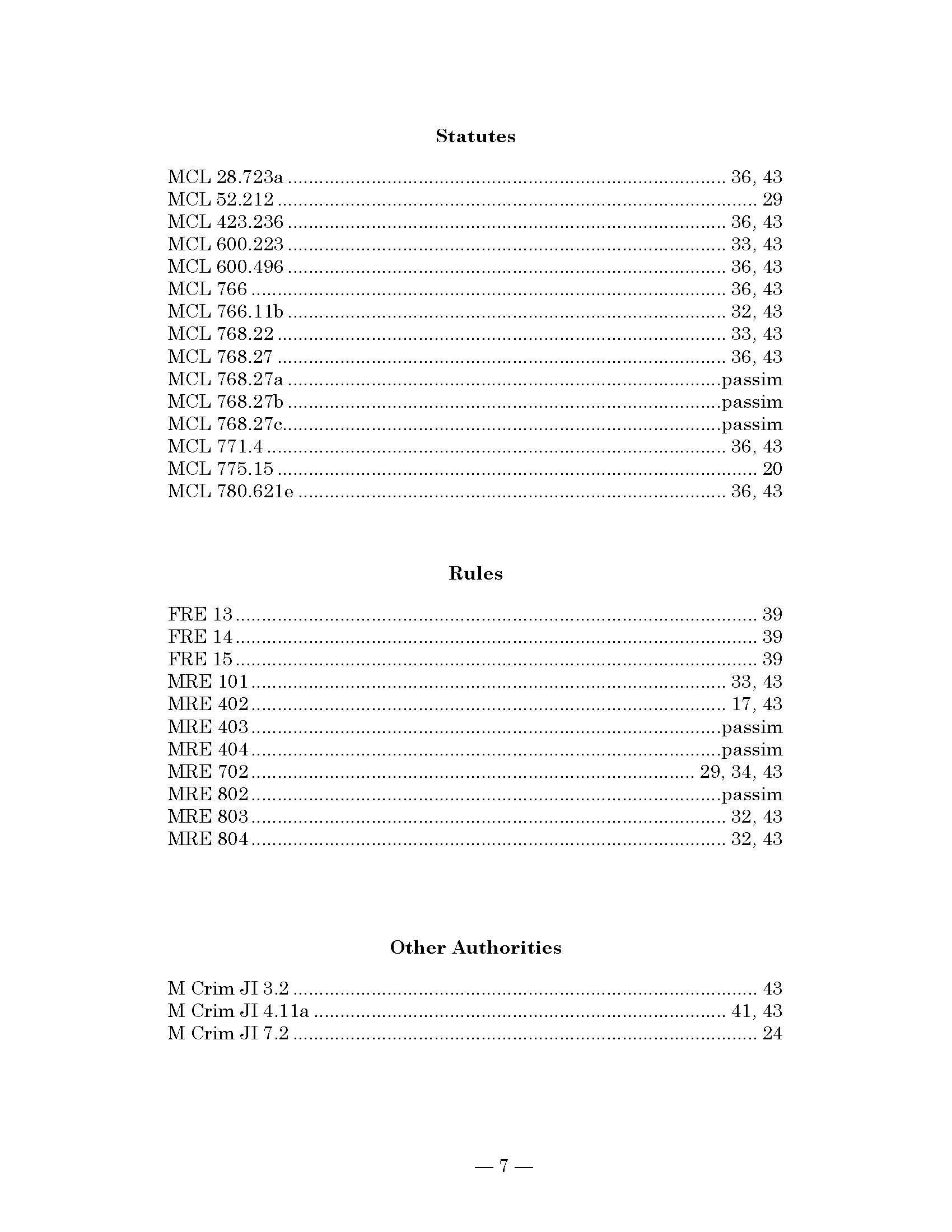
2023] DISTINGUISHED BRIEF 125

126 W. MICH. U. COOLEY LAW REVIEW [Vol. 38:1

2023] DISTINGUISHED BRIEF 127
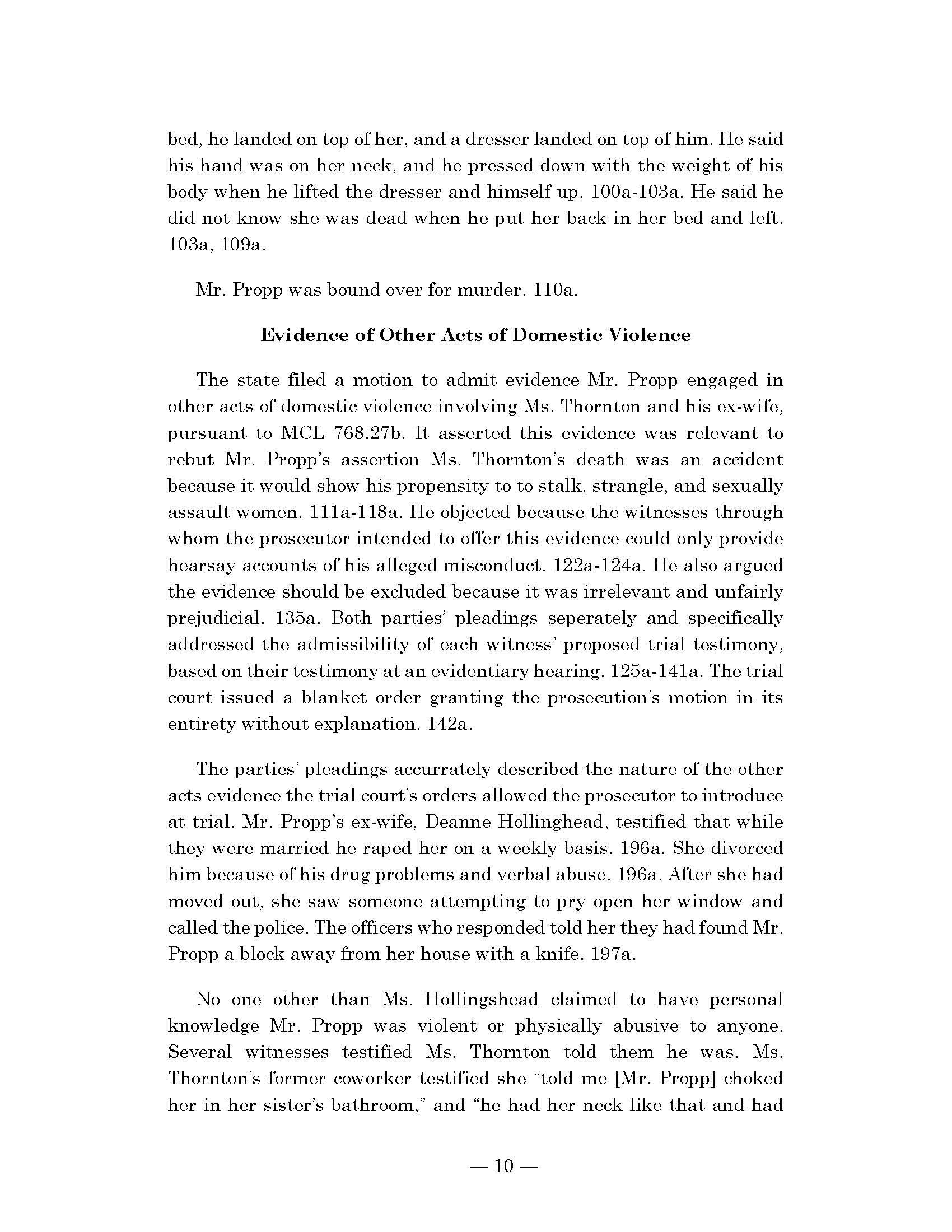
128 W. MICH. U. COOLEY LAW REVIEW [Vol. 38:1
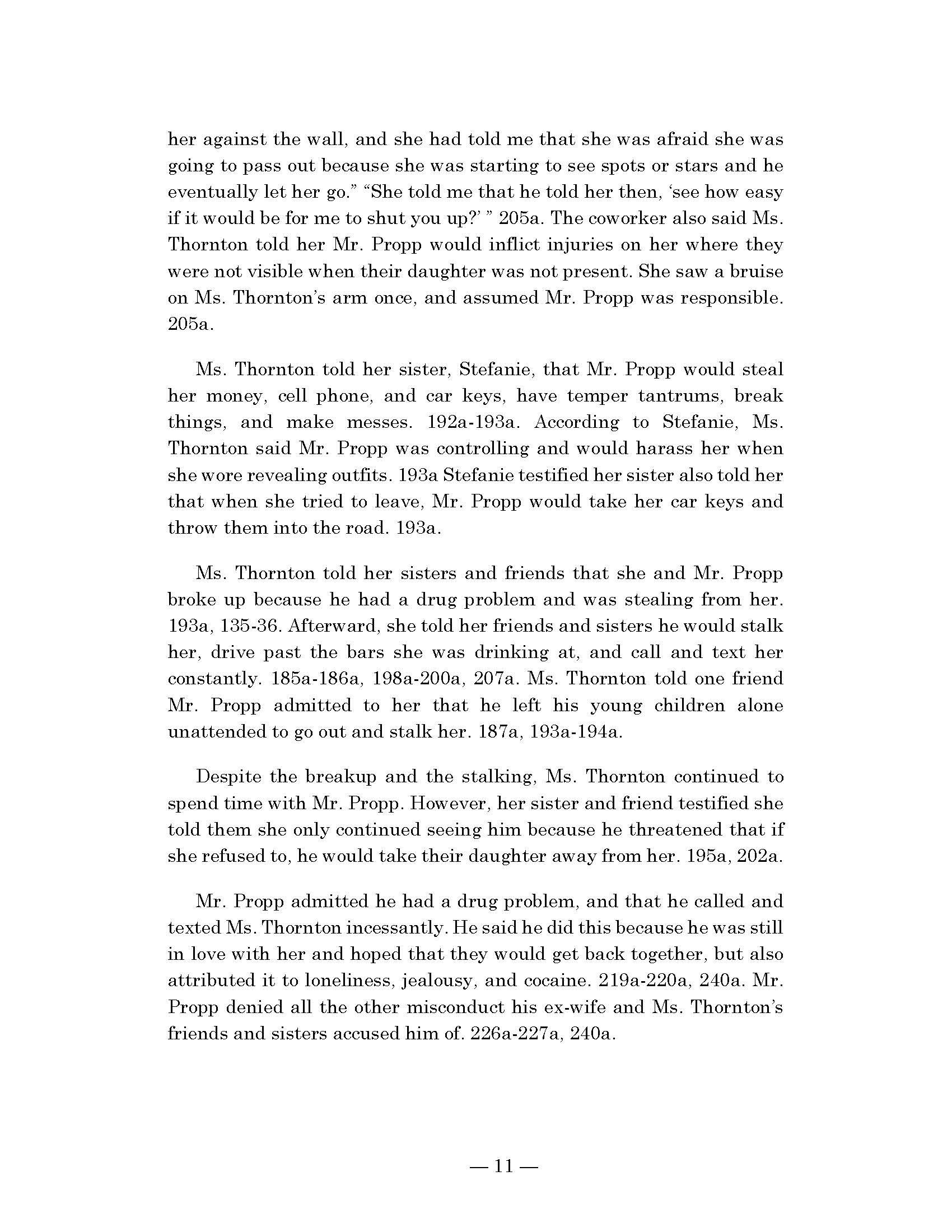
2023] DISTINGUISHED BRIEF 129

130 W. MICH. U. COOLEY LAW REVIEW [Vol. 38:1
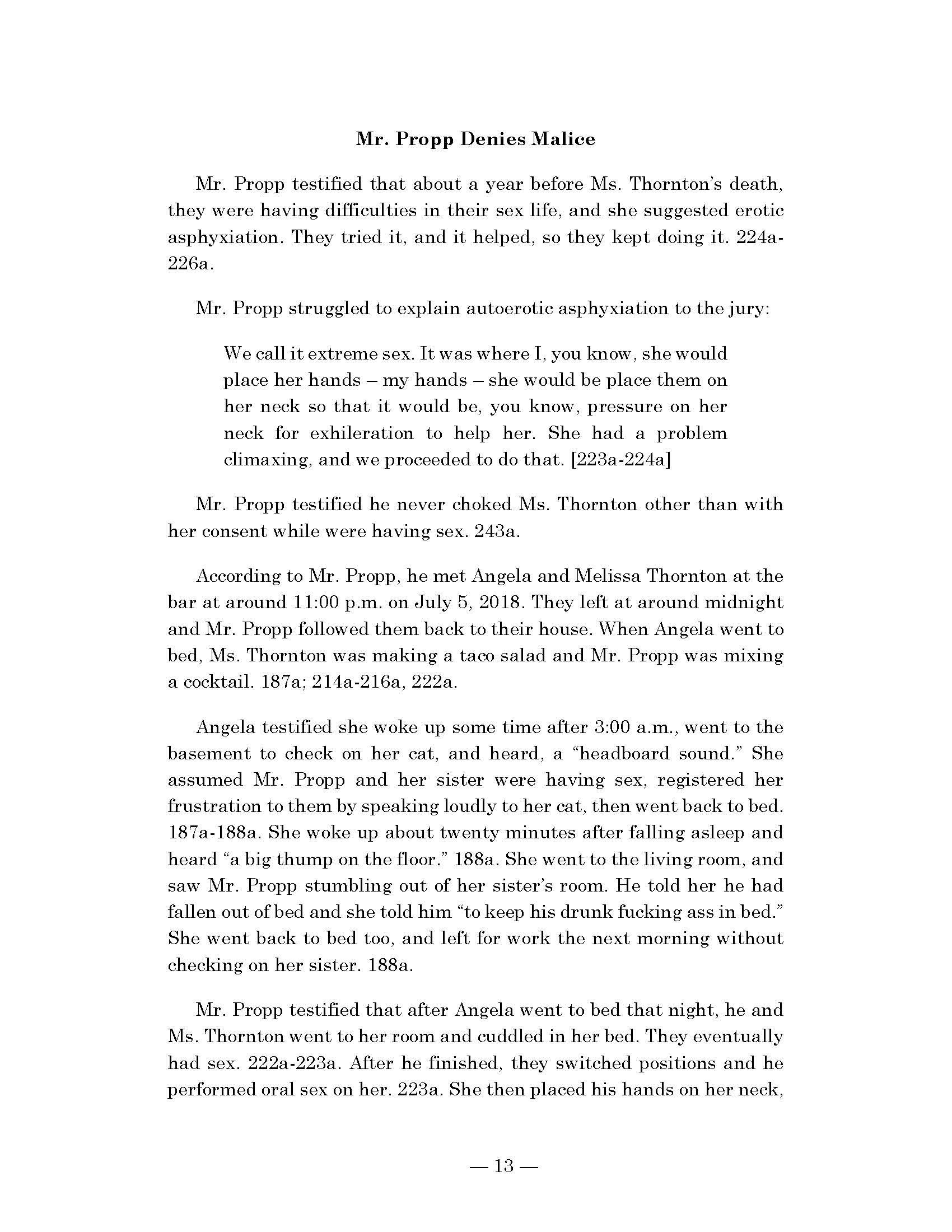
2023] DISTINGUISHED BRIEF 131

132 W. MICH. U. COOLEY LAW REVIEW [Vol. 38:1

2023] DISTINGUISHED BRIEF 133
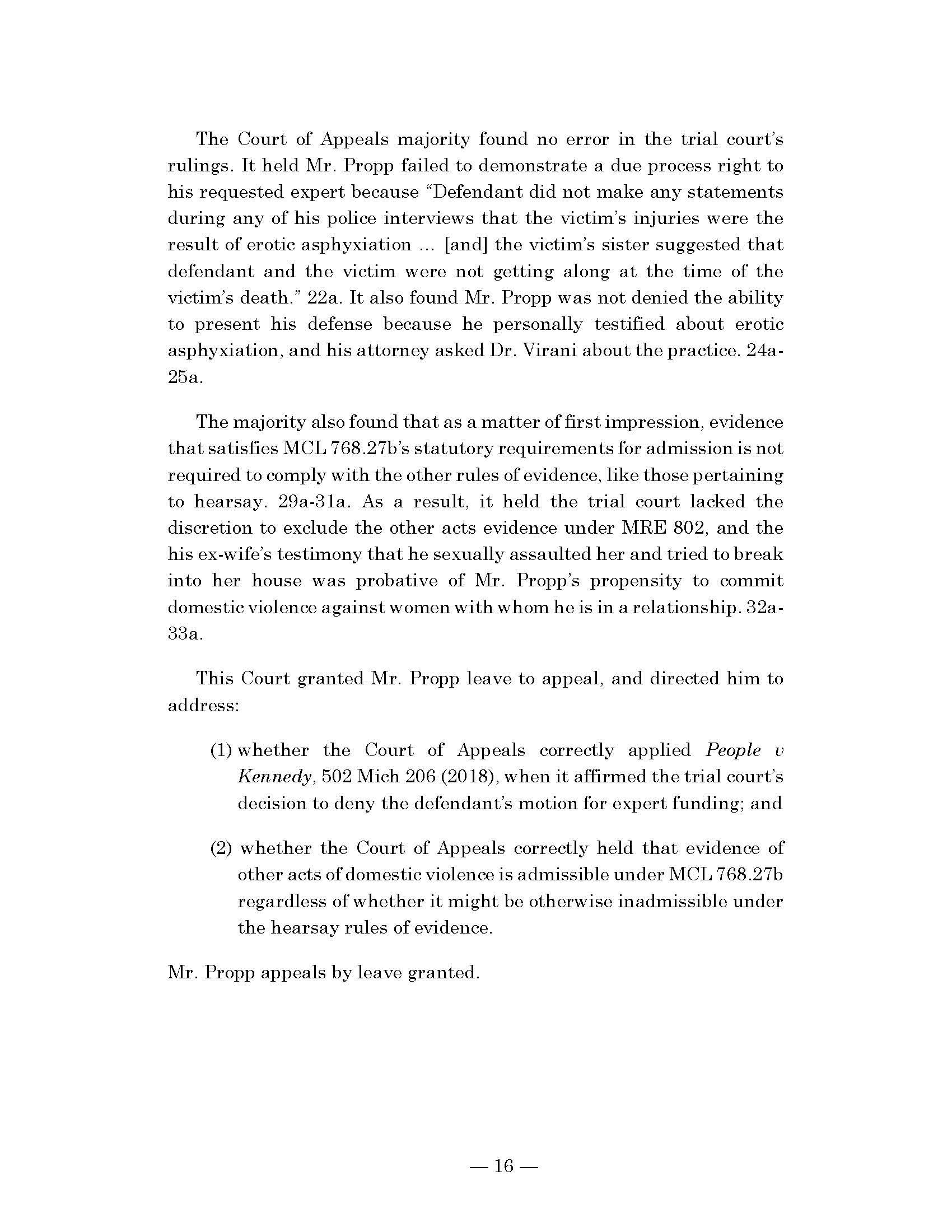
134 W. MICH. U. COOLEY LAW REVIEW [Vol. 38:1

2023] DISTINGUISHED BRIEF 135
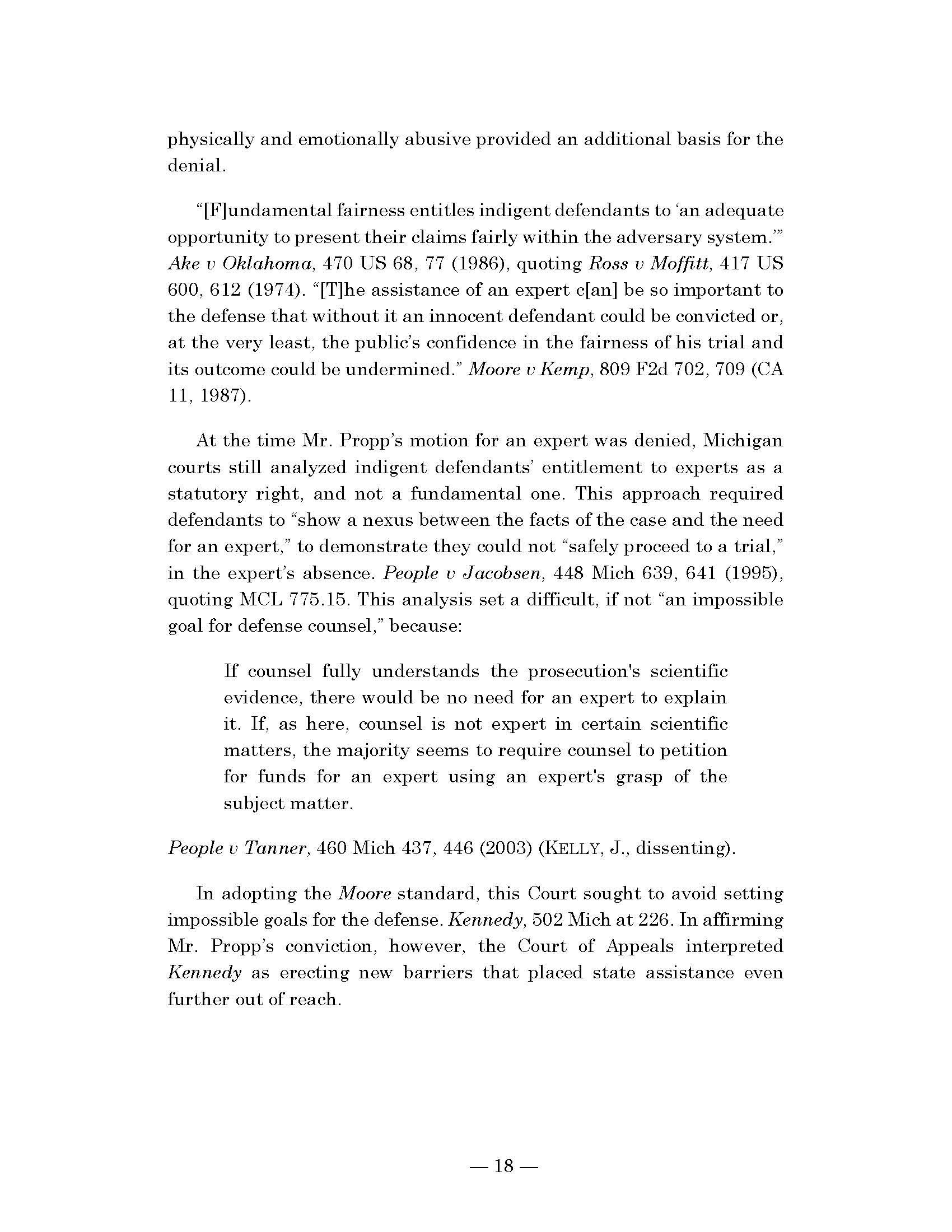
136 W. MICH. U. COOLEY LAW REVIEW [Vol. 38:1
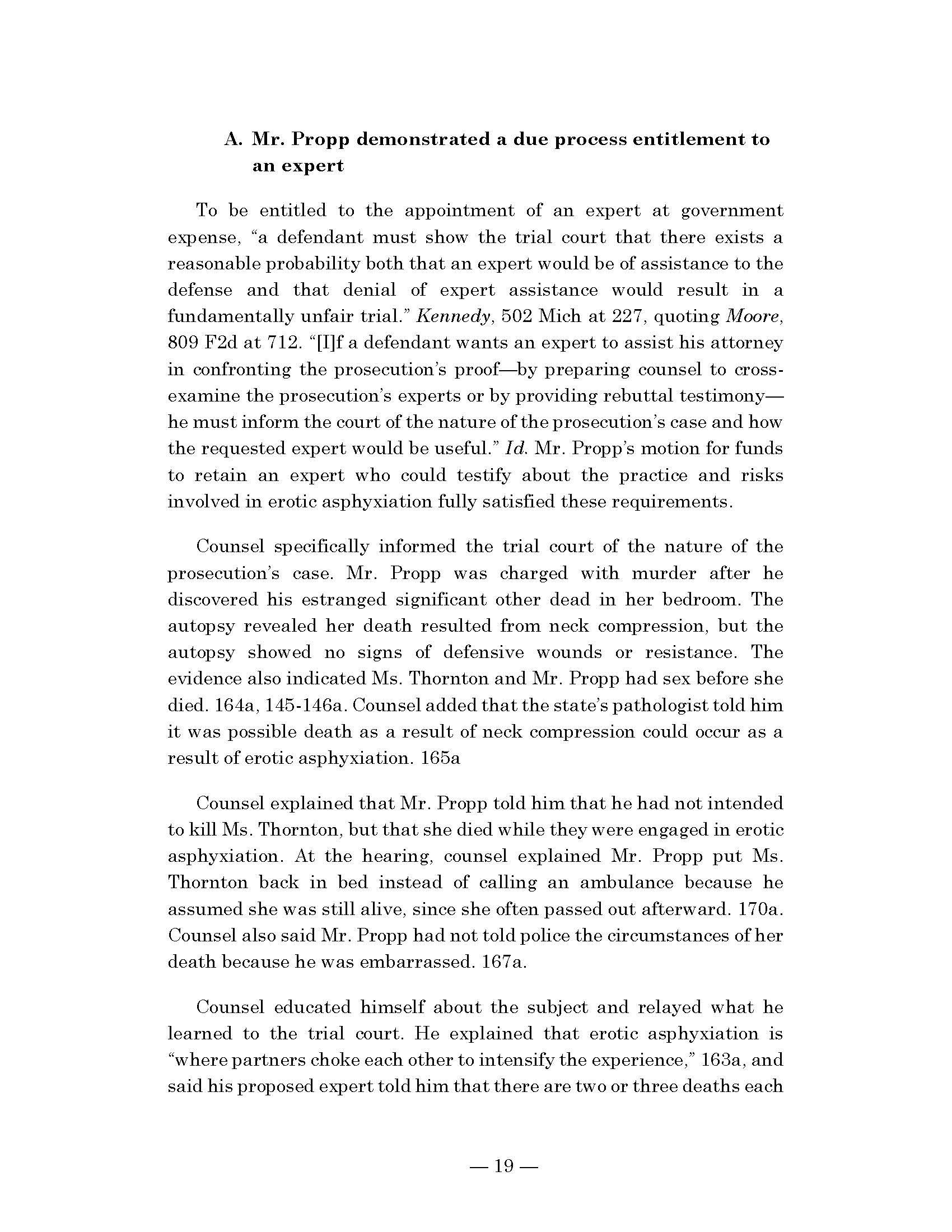
2023] DISTINGUISHED BRIEF 137

138 W. MICH. U. COOLEY LAW REVIEW [Vol. 38:1

2023] DISTINGUISHED BRIEF 139
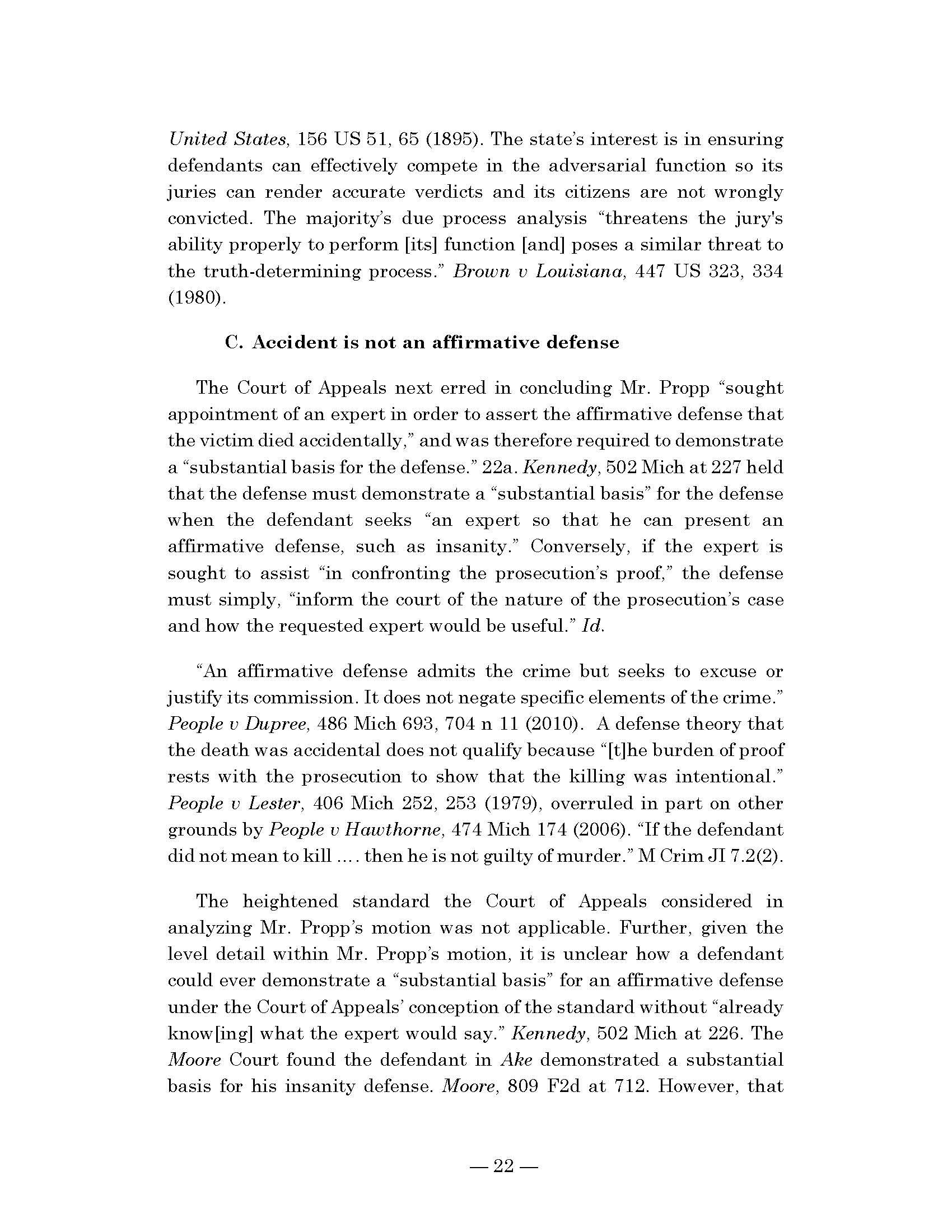
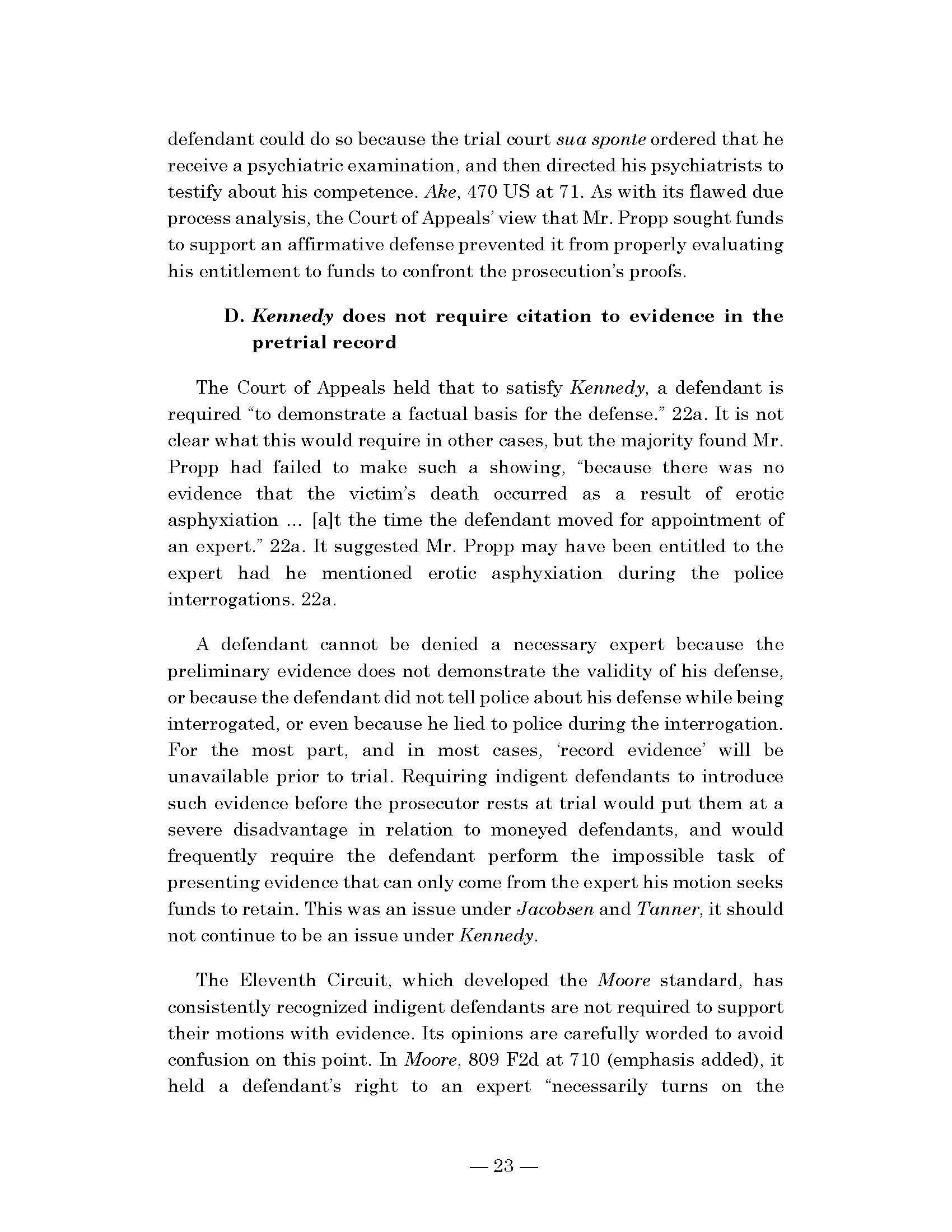
140 W. MICH. U. COOLEY LAW REVIEW [Vol. 38:1
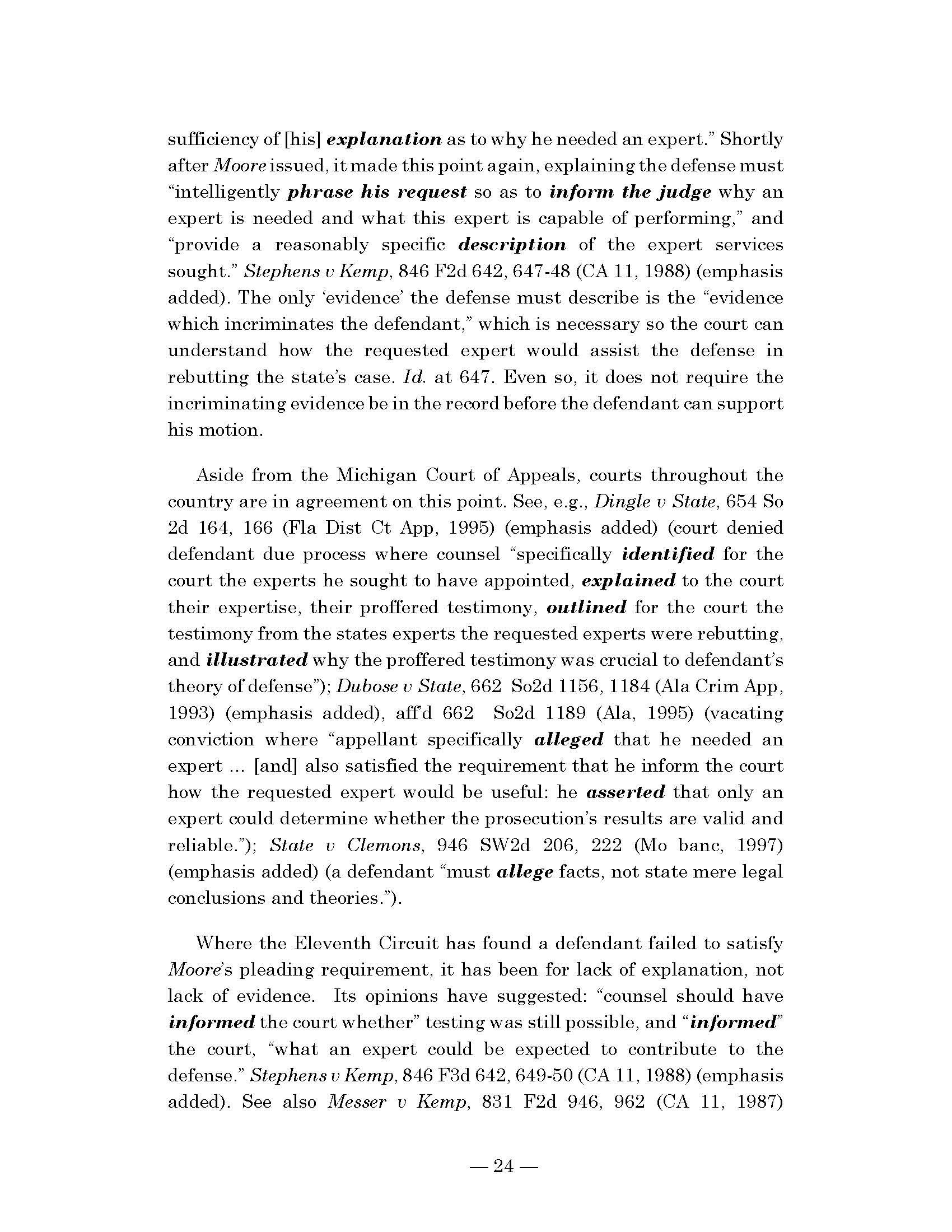
2023] DISTINGUISHED BRIEF 141
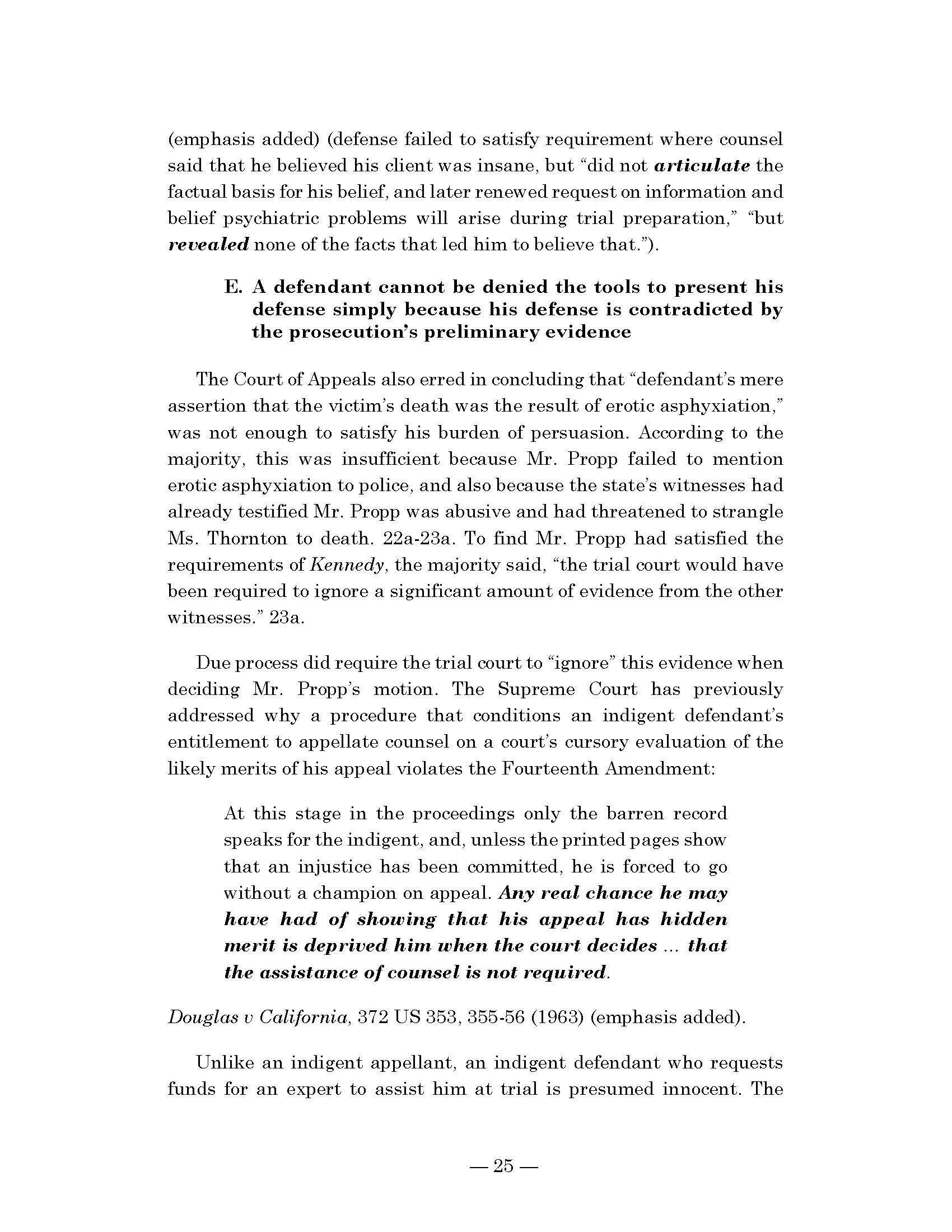
142 W. MICH. U. COOLEY LAW REVIEW [Vol. 38:1

2023] DISTINGUISHED BRIEF 143

144 W. MICH. U. COOLEY LAW REVIEW [Vol. 38:1
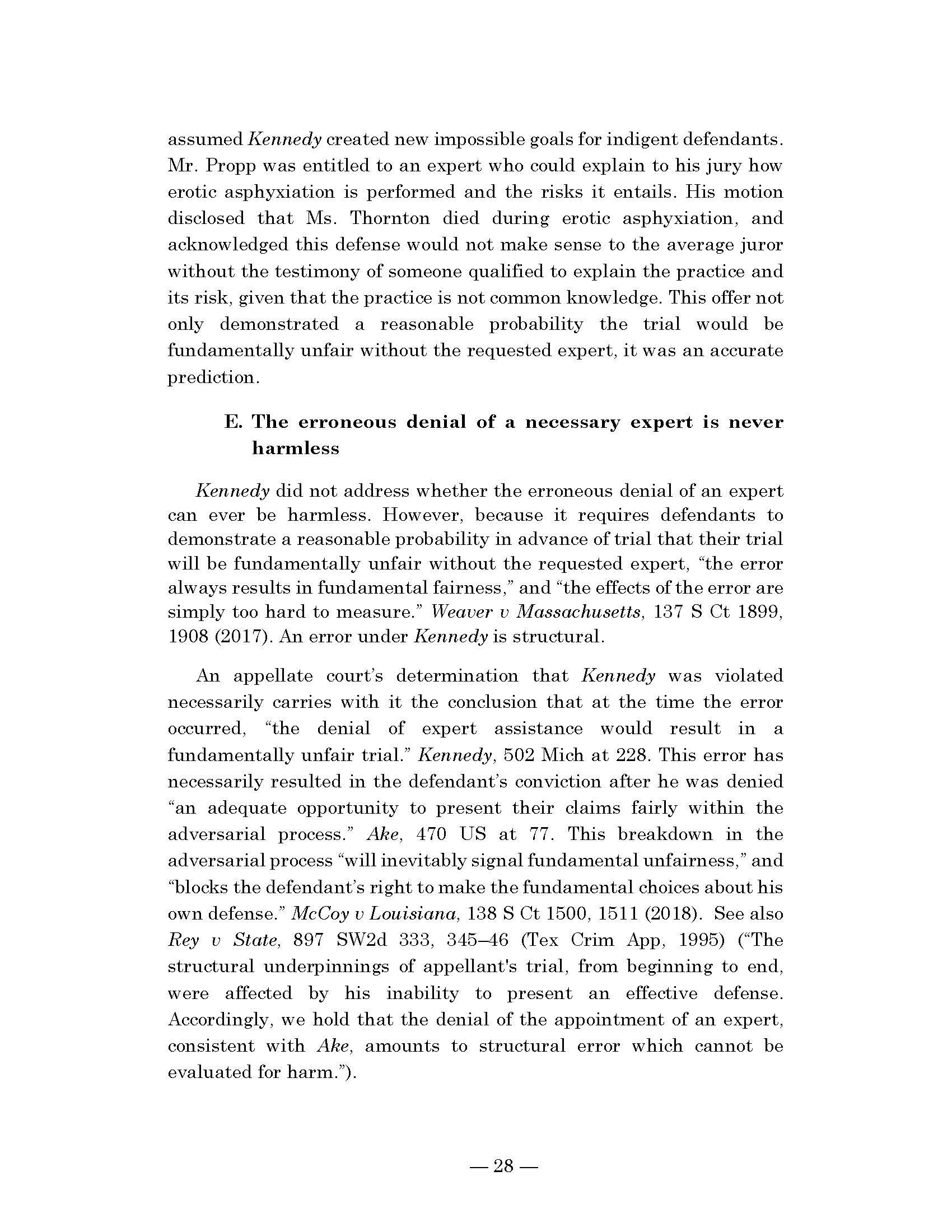
2023] DISTINGUISHED BRIEF 145
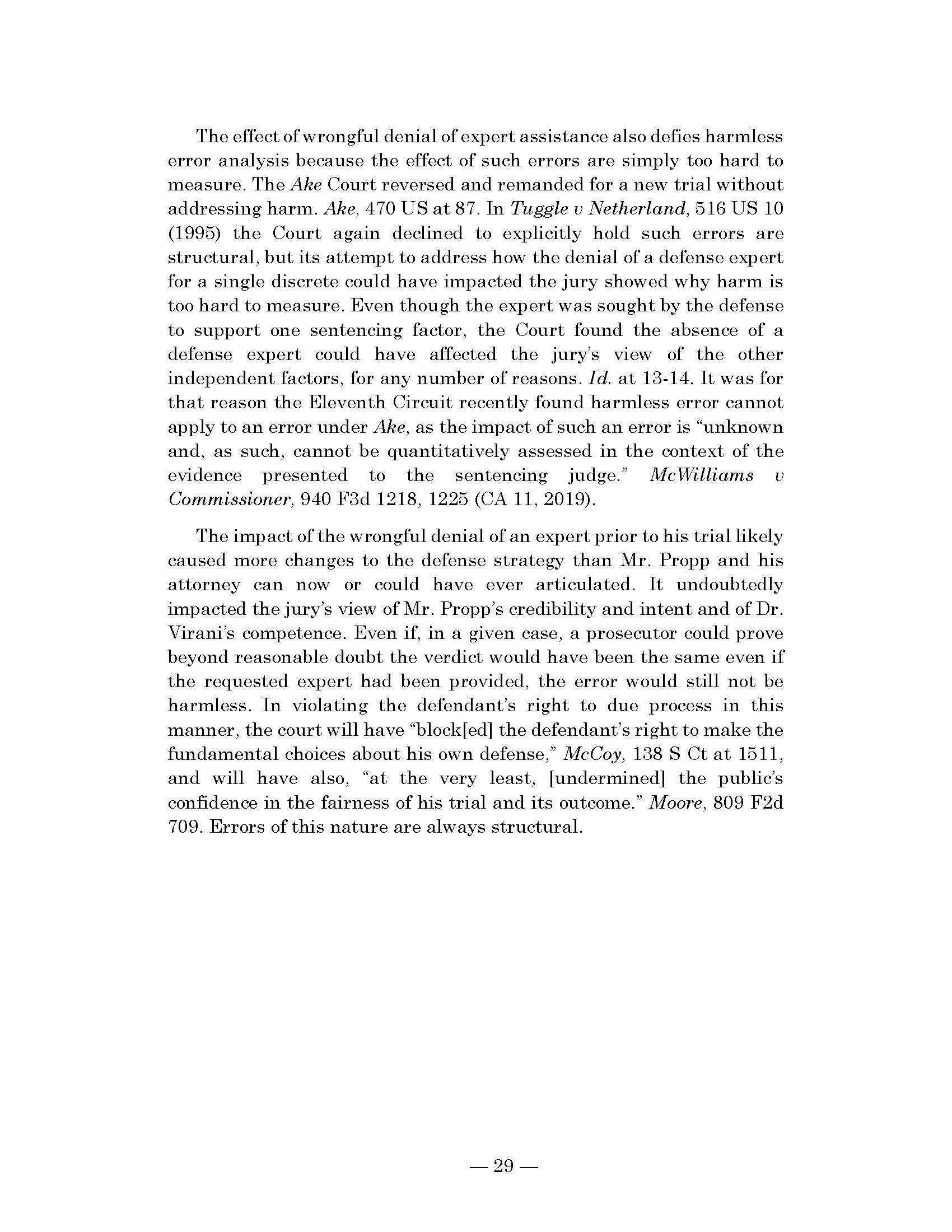
146 W. MICH. U. COOLEY LAW REVIEW [Vol. 38:1

2023] DISTINGUISHED BRIEF 147
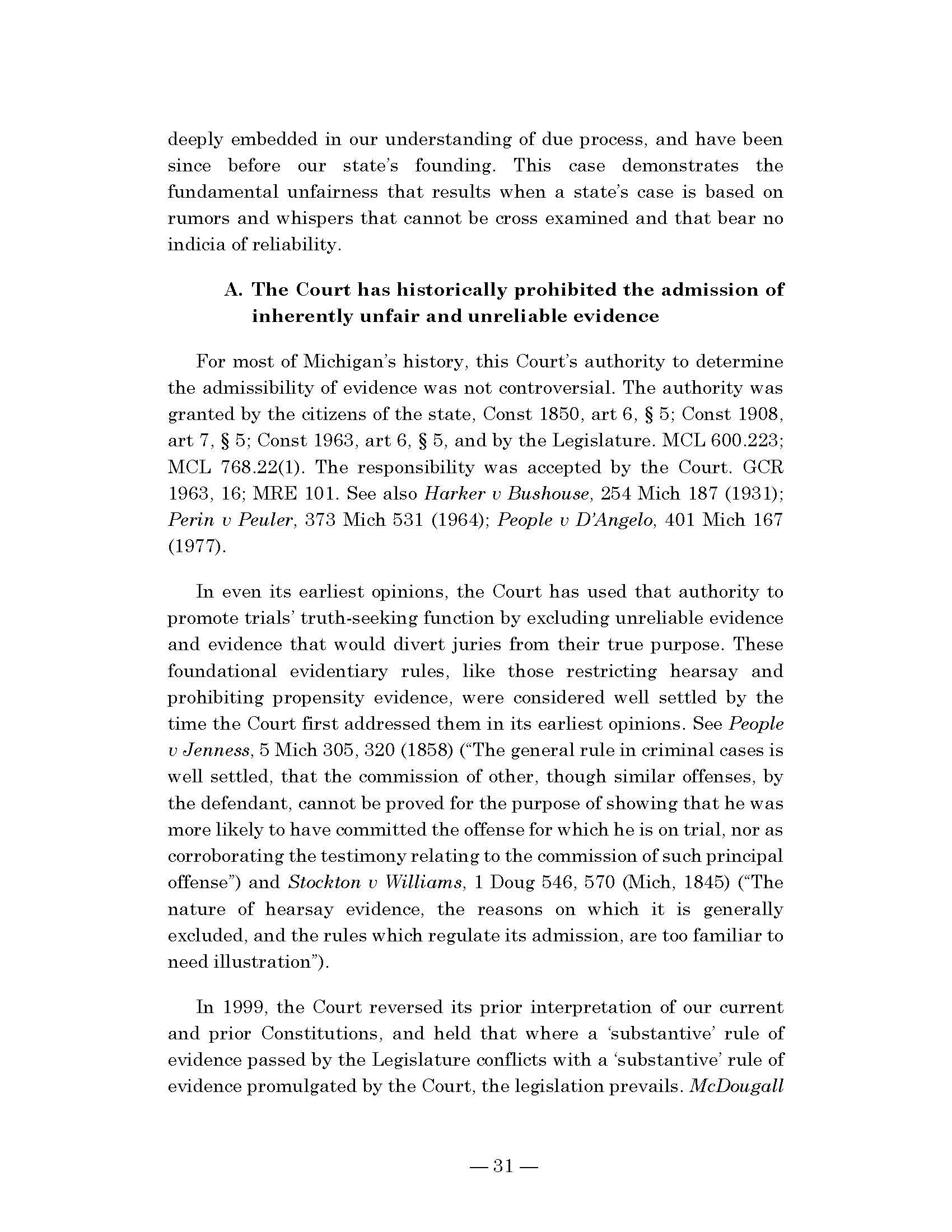
148 W. MICH. U. COOLEY LAW REVIEW [Vol. 38:1
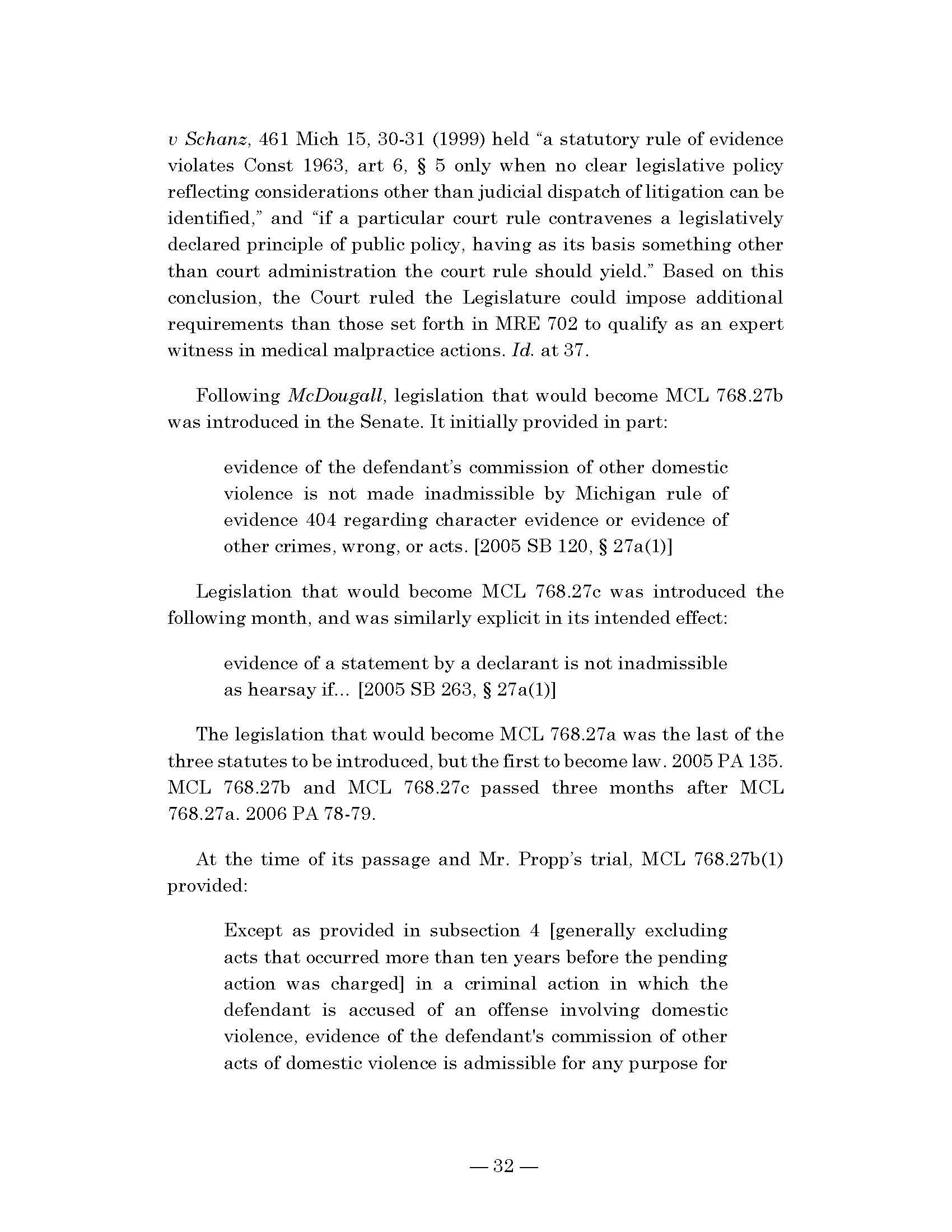
2023] DISTINGUISHED BRIEF 149

150 W. MICH. U. COOLEY LAW REVIEW [Vol. 38:1
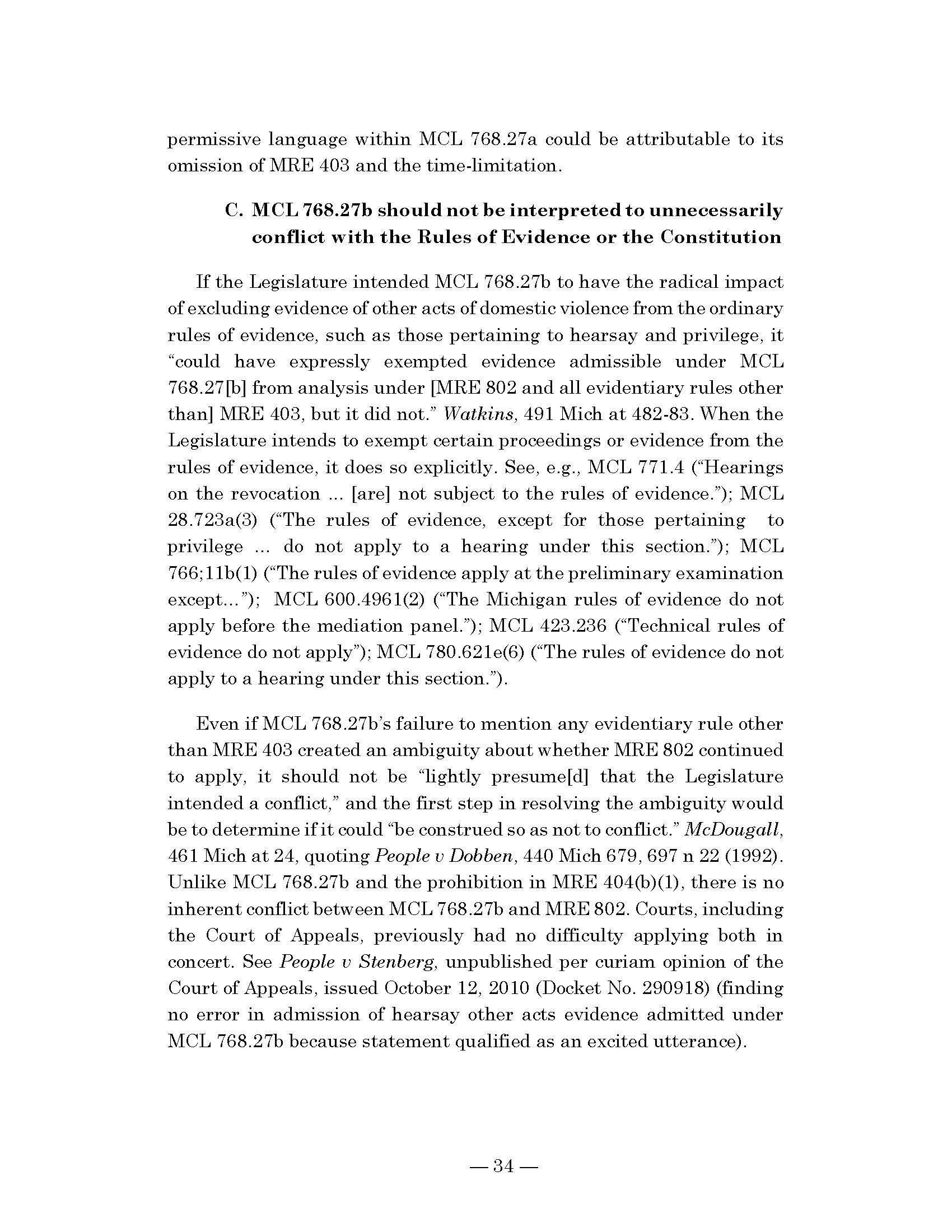
2023] DISTINGUISHED BRIEF 151
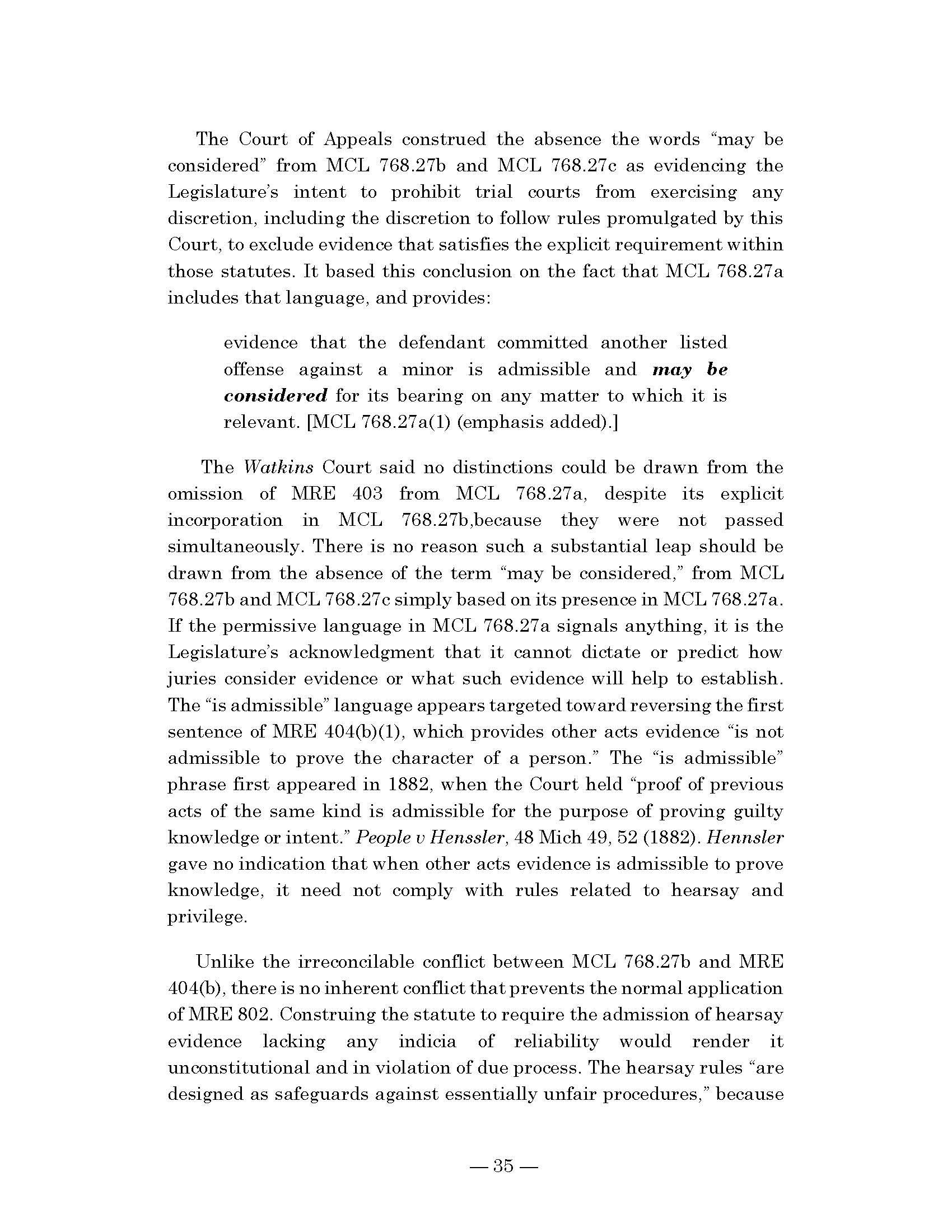
152 W. MICH. U. COOLEY LAW REVIEW [Vol. 38:1

2023] DISTINGUISHED BRIEF 153
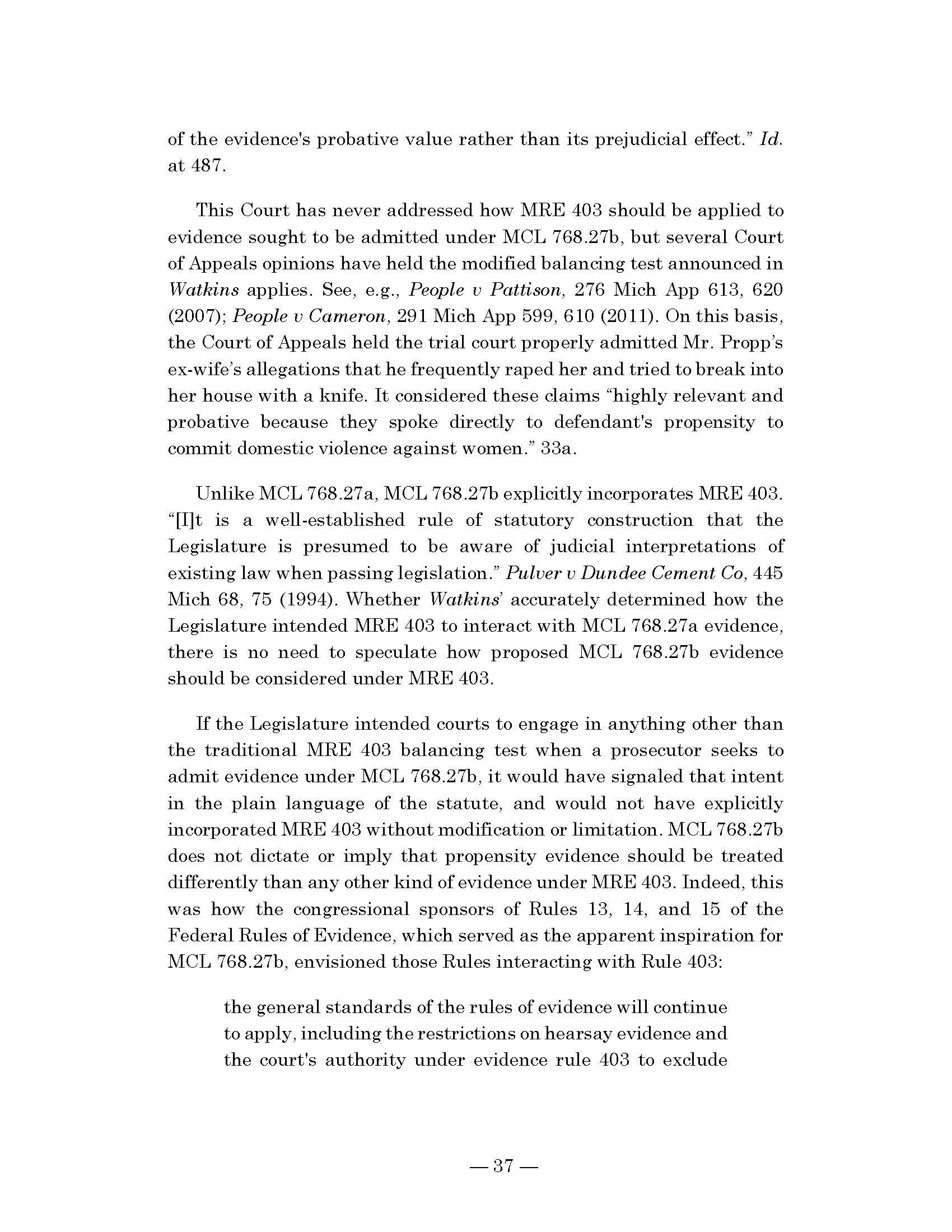
154 W. MICH. U. COOLEY LAW REVIEW [Vol. 38:1

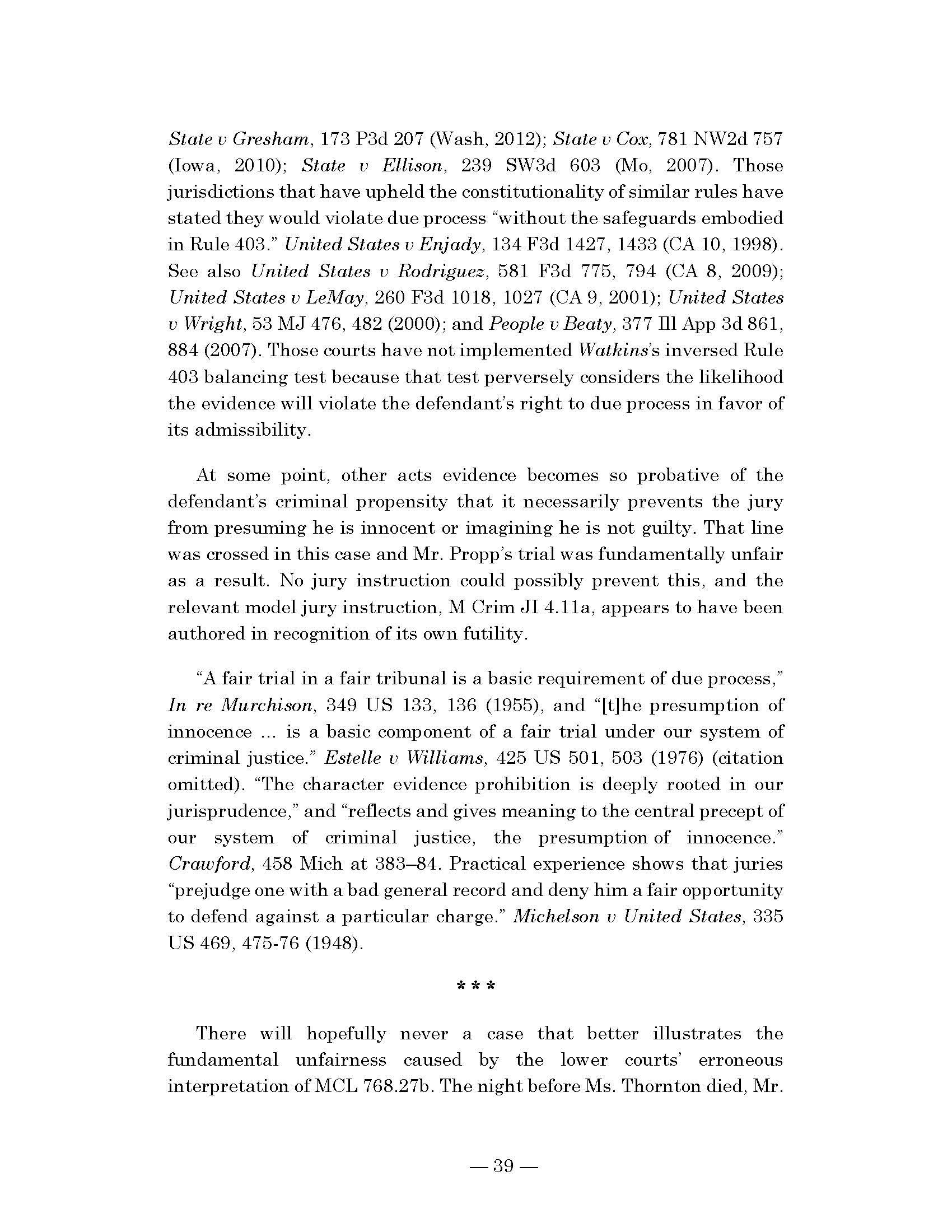
2023] DISTINGUISHED BRIEF 155

156 W. MICH. U. COOLEY LAW REVIEW [Vol. 38:1

2023] DISTINGUISHED BRIEF 157
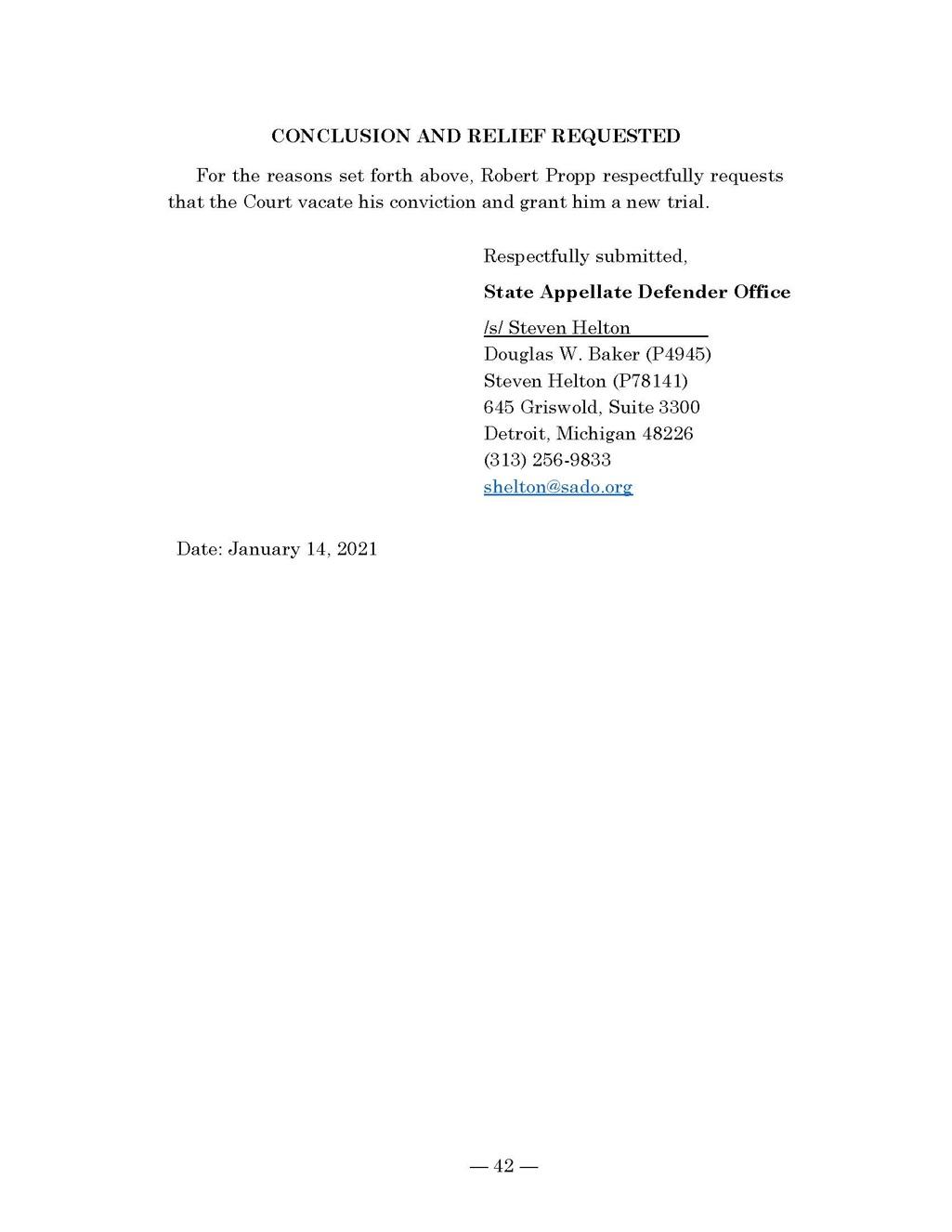
158 W. MICH. U. COOLEY LAW REVIEW [Vol. 38:1

2023] DISTINGUISHED BRIEF 159
WESTERN MICHIGAN UNIVERSITY COOLEY LAW REVIEW


WESTERN MICHIGAN UNIVERSITY
C OOLEY LAW REVIEW is also available electronically at:
WESTERN MICHIGAN UNIVERSITY COOLEY LAW REVIEW































































































